Street Works Manual
1.0 Introduction
The NYC Street Works Manual describes policies governing work on city streets, and presents procedures for notice, approval and execution of such work. These policies and the Manual's presentation of permit procedures are designed to deliver higher quality street surfaces, fewer transportation capacity reductions and a more efficient construction environment to the people and businesses of New York City.
There are nearly 6,000 miles of streets in New York City. City streets facilitate the movement of pedestrians, transit riders, motorists and cyclists as well as the delivery of goods and services throughout the city. Under the surface, the same streets support the city's water, sewer, power and telecommunications infrastructure, as well as its subway tunnels and building vaults. The streets themselves also serve as public spaces, fostering social, economic and recreational activities.
Management of New York City's street infrastructure is critical to the city's economic well-being and quality of life. The Street Works Manual is a tool intended to increase the performance of both city government and the private sector in this regard. Its overall goals are both far-reaching and vital: sustaining the city's investment in its streets, enhancing access to subsurface infrastructure and minimizing transportation and community disruptions.
To this end, the Street Works Manual is a resource for all parties that perform work in New York City streets, from utilities and contractors installing, replacing and repairing underground infrastructure to developers replacing roadways and sidewalks adjacent to building sites and homeowners performing their own sidewalk repairs.
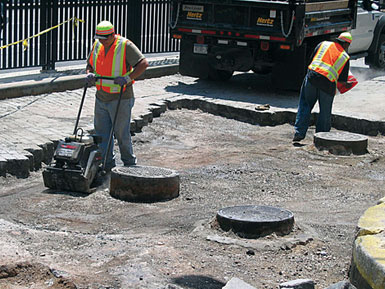
NYC DOT coordinates street opening and other construction on streets.
How to Use the Street Works Manual
The organization of the Street Works Manual generally follows the chronological process of planning and undertaking work in the street.
Chapter 2 describes processes and tools to enhance advance planning and coordination of street work between NYC DOT's own capital resurfacing and reconstruction programs and the street infrastructure work of other stakeholders, especially those that perform a large number of street excavations. One tool highlighted in this chapter is DOTMap, a data sharing initiative that allows for better coordination of planned street reconstruction and resurfacing activities with other street excavation work.
Chapter 3 describes different types of construction-related permits issued by NYC DOT and outlines the application processes for each permit type. It also provides cross-references to useful online forms and tools.
Chapter 4 describes the processes for executing work in the streets, after permits and approvals are obtained, and the enforcement actions NYC DOT may take to safeguard city streets.
In Chapters 3 and 4, the ![]() symbol is used to indicate particularly time-sensitive requirements of the processes described.
symbol is used to indicate particularly time-sensitive requirements of the processes described.
Appendices to the Street Works Manual provide additional resources, including a list of common permit types and the supporting documentation required for each permit type, reference copies of applications and required forms, contact information for NYC DOT and other agencies and utilities, a list of the stipulations placed on permits under certain conditions and/or at certain locations, and useful internet links by chapter of the Manual.
Applicability
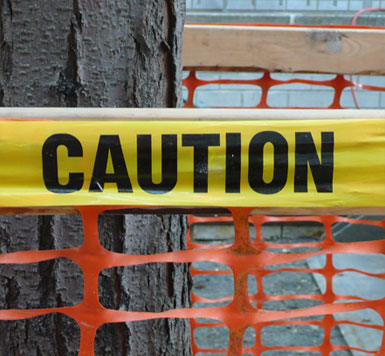
The guidance presented in the Street Works Manual does not supersede any existing federal, state or city laws, rules and regulations. For complete NYC DOT requirements regarding the performance of work in the street, please consult the Highway Rules and NYC DOT specifications
The Glossary and definitions found in this Manual provide a brief explanation of NYC DOT terminology. Any definitions found in existing federal, state or city laws, rules and regulations take precedence as the official and legal definitions.
NYC DOT disclaims any liability for omissions or errors that may be contained herein.
2.0 Advance Notice & Coordination
Advance notice and coordination of planned street work is one of the most effective tools for reducing the number of street excavations, especially on streets that are scheduled to be resurfaced or reconstructed. Street excavators, including utility companies and developers, can access New York City Department of Transportation (NYC DOT) data and attend NYC DOT coordination meetings to facilitate effective communication regarding planned street work.
About this Chapter
Thousands of miles of utility pipes, cables and other equipment are beneath the streets of New York City. The installation and repair of this infrastructure is crucial to maintaining and strengthening the city's competitive position in the global economy. Inevitably, street excavations to install or access this infrastructure disrupt the normal activity of New York's streets, causing frustration and confusion for local residents and businesses. Street excavations also adversely affect the condition of the streets, reducing the number of years the pavement would otherwise be expected to remain in good or excellent condition following resurfacing or reconstruction, and increasing repair and life cycle costs for the city.
The goal of advance coordination is to reduce the number of excavations in New York City streets. To this end, this chapter discusses existing mechanisms that help inform utility companies and other potential street excavators of impending NYC DOT work, including how to access information on NYC DOT's planned capital projects, weekly street resurfacing schedules, "protected street"* information and other data that can help to facilitate effective communication regarding street work. It also outlines principles for coordinating with NYC DOT when proposing excavation work to help make certain that excavation on streets occurs before or in conjunction with city street work, where practicable.
NYC DOT project locations, protected streets, and other maps are available online at the Department of Information Technology & Telecommunications (DoITT) NYCityMap website and the DOTMap portal. Permittees can use these maps to make informed decisions while planning new projects.
2.1 The Goal of Advance Notice and Coordination
Advance notice and coordination of planned street work is one of the most effective tools for reducing the number of street excavations on newly resurfaced or reconstructed streets. With advance notice of proposed excavation work, NYC DOT can sequence the timing of the large number of roadway and utility works being undertaken across the city. Similarly, the sooner a potential street excavator knows about NYC DOT's intent to work in a particular location, the better it can make arrangements to avoid or reduce potential conflicts.
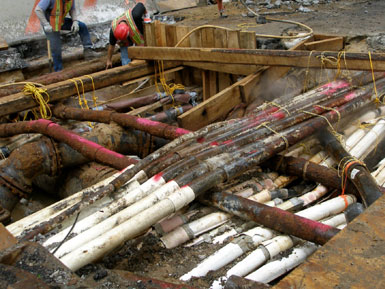
New York City streets include a complex mix of assets such as electric, gas, telephone, cable, water, sewer and steam lines, requiring coordination among the different asset owners when street work is performed.
2.2 NYCityMap, DOTMap, and Other Online Information
With advance notice of NYC DOT's intent to work in a particular location, utility companies and other potential street excavators are better able to make arrangements to minimize potential conflicts or to leverage the opportunity to perform their work before resurfacing or reconstruction is complete. In order to assist the goal of advanced coordination, information about planned NYC DOT projects is available via the DOTMap portal within the NYCityMap website. By accessing this map portal, a utility company or any other entity that performs street excavation work can find details on NYC DOT projects included in the city's 10-year Capital Budget, as well as more imminent NYC DOT and New York City Department of Environmental Protection capital projects currently in design or under construction.

NYCityMap is the city's web-based interactive mapping application. It includes capital construction projects.
View information on how to navigate and use NYCityMap.
DOTMap also features a protected streets layer, enabling utilities and other potential street excavators to view which streets are protected and for what period of time. The protected streets layer is current as of the previous business day. The screen image below displays the "NYC DOT 10 year Capital Plan" projects in green and protected streets in blue.
Clicking on the "i" button at the top center of the map will change the cursor into an arrow with an "i" next to it. With this cursor, users can click on the map to get information about a particular map layer. As shown in the screen image, the pop-up for the "NYC DOT 10 year Capital Plan" layer features a project ID, title, and the fiscal year for which the project is planned, whereas the pop-up for "NYC DOT Protected Streets" includes street name and the date to which protected status extends.
Other Online Information
Weekly Milling and Resurfacing and Concrete Repair Schedules—NYC DOT weekly milling and resurfacing schedules are available online.
The milling and resurfacing schedules are organized by borough and are sent electronically each week to utility companies and other city agencies. A longer-term resurfacing schedule that forecasts several months of anticipated work is distributed during borough-level monthly utility coordination meetings (see Section 2.3 Key Principles for Effective Notice and Coordination of Planned Street Work). NYC DOT's concrete repair schedule for roadways, sidewalks and other assets in the street can also be accessed from this link.
Embargoes—NYC DOT imposes construction "embargoes" (a temporary suspension of active permits in the affected area) for significant special events including the New York City Marathon, parades, high profile projects and the winter holiday season. Click here for a list of current construction embargoes. Additional information regarding embargo periods is provided in Chapter 3, Section 3.6.2.
2.3 Key Principles for Effective Notice and Coordination of Planned Street Work
NYC DOT is working to enhance the coordination of major planned work that impacts the streets with utility companies and other entities that perform street excavations. To this end, NYC DOT has dedicated time and resources to enhance its own systems and coordination efforts. It is important that contractors and utility companies are responsible partners as well in order for coordination to be effective. Coordinating street work in accordance with the principles of this section will help to minimize delays and disruption to road users, businesses and residents and help extend the useful life of city streets.
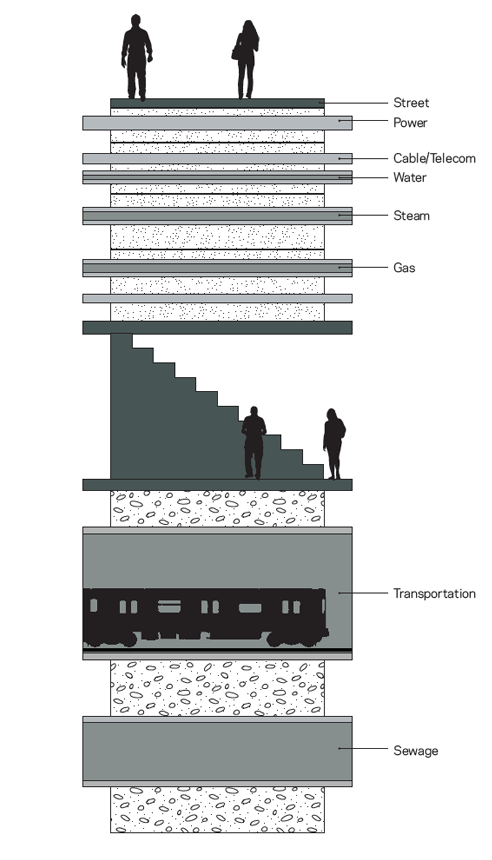
Key principles for effective coordination include:
Provide Notice of Planned Street work at Earliest Opportunity—The basic principle of providing adequate advance notice is the greater the disruption, the longer the notice period needed.
The notice provisions specified in Section 2-02(g) of the Highway Rules are the minimum required for street operations. Click here to access the Highway Rules
By mutually sharing data before detailed construction plans have been developed NYC DOT and street excavators can adjust their project plans to avoid conflict and maximize the potential opportunity for street work coordination.
Share long-term capital plans for planned repairs, upgrades and new
service—Information on long-term capital programs from potential street excavators helps NYC DOT to effectively coordinate planned street work. It also helps NYC DOT to identify opportunities for joint bidding and to coordinate the timing of the agency's resurfacing and reconstruction activities.
Regular Input and Attendance of Decision Makers at Coordination
Meetings—Regular coordination meetings allow decision makers to share information and to discuss project difficulties and constraints. Several forums are in place to provide advance notice of city capital projects. NYC DOT hosts borough-level meetings to discuss the scheduling of upcoming resurfacing projects with utility companies and other potential street excavators. NYC DOT also routinely meets with utility companies and others who perform street excavations to inform these organizations of upcoming events and major construction projects with which NYC DOT is involved. Additionally, in the middle of each fiscal year, the New York City Department of Design and Construction (DDC) convenes a meeting with other agencies and utilities to discuss city projects under its purview that are expected to begin construction during the next four years. During the final design stage of a city project, DDC will also hold a series of alignment meetings with the utilities and other agencies to inform them about proposed changes to the location of street infrastructure that would require facility relocation.
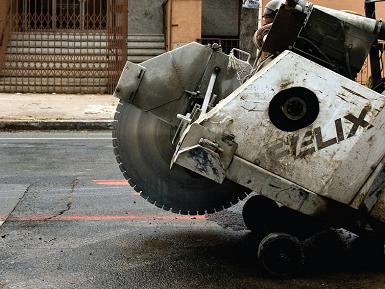
Coordination aims to reduce street excavation work on recently repaved streets.
3.0 Permits & Approvals
Utility companies, developers, contractors, and excavators who undertake any type of construction that will impact the street or occupy it with equipment, structures or other installations must obtain a permit.
About this Chapter
New York City is brimming with construction activity—from the building of skyscrapers, rehabilitating and reconstructing of bridges and roadways, to the digging of new subway lines. At the foundation of the city that never sleeps lays a network of streets that helps keep New York and New Yorkers moving forward. In order to maintain world-class streets, permits must be obtained for the work performed in the street.
The term "street" means a public street, avenue, road, alley, lane, highway, boulevard, concourse, parkway, driveway, culvert, sidewalk, crosswalk, boardwalk, viaduct, square or place, except those streets adjacent to any waterfront property designated as a marginal street on a city map. This chapter describes the different types of permits that are issued by the New York City Department of Transportation (NYC DOT), the one-time permittee registration process, the application procedure for each permit type, and special circumstances and procedures.
3.1 General Provisions For Construction-Related Permits
NYC DOT's mission is to provide for the safe, efficient and environmentally responsible movement of pedestrians, goods, bicycles and vehicular traffic on the streets of the city of New York. In addition, the streets serve as the access point for the subsurface infrastructure that provides water, sewer, power, and telecommunications services for the city. NYC DOT registers permittees, and coordinates and issues permits for construction-related activity on streets.
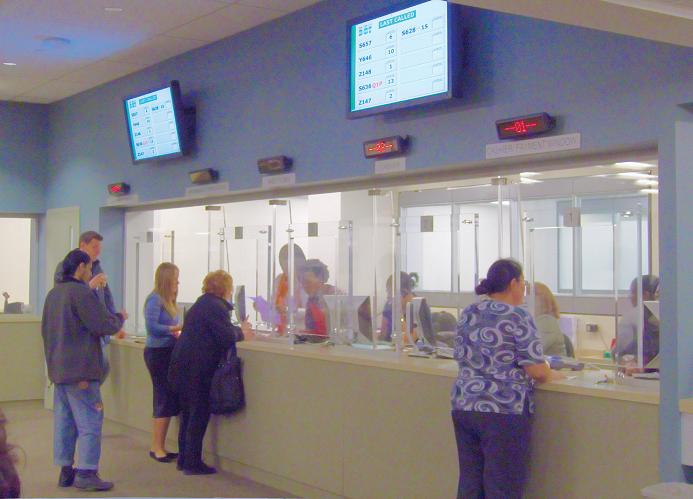
Permit windows at the central Permit Office
Registered Permittees may apply, pay for and print their permits anytime anywhere using the NYCStreets Permit Management online system.
Public can search for location and status of active construction permits using a friendly map based NYCStreets interface.
An online permit processing application significantly enhanced the efficiency of NYC DOT permitting operations. By eliminating manual steps, most permit requests now may be approved and issued within 1-2 business days.
Please note that although permits can be submitted, paid for and printed out 24/7, the permit review process occurs only during normal weekday Permit Office hours.
In calendar year 2018 NYC DOT processed more than 700,000 construction permits.
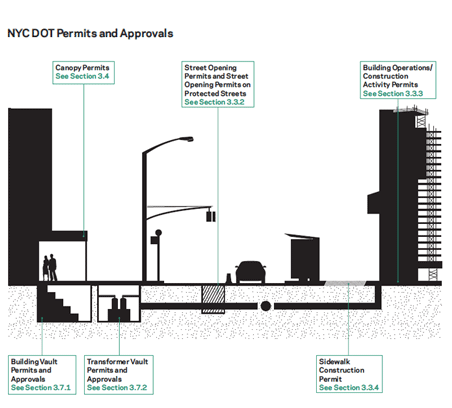
Who Issues Construction-Related Permits for Work on a Street?
The NYC DOT Bureau of Permit Management and Construction Control (the Bureau) is responsible for overseeing all construction-related permitting. The Bureau is comprised of two offices:
- The Office of Permit Management (Permit Office) provides extensive customer support for all applicants, registers permittees, receives and reviews for accuracy and completeness permit application submitted in person, and also reviews appropriate fees for both online and in-person applications. There is a central Permit Office in Manhattan and borough Permit Offices in each of the other boroughs.
- The Office of Construction Mitigation and Coordination (OCMC) reviews all construction permit applications and develops construction activity stipulations* to allow for work to occur with minimal disruption to businesses, motorists, bicyclists and pedestrians, and avoid conflicts with other construction projects and special events. OCMC also interacts with project engineers, city agencies, community boards, elected officials and the general public to resolve construction issues related to mobility.

All work within the street requires a NYC DOT permit to minimize construction impacts.
Types of Permits
The Permit Bureau issues a number of different categories of construction-related permits for work on a street. Street Opening, Building Operations/Construction Activity, Sidewalk Construction, and Canopy Permits are reviewed and stipulated by OCMC staff. Manhole Embargo, Commercial Refuse Container, Temporary Plates and Shunts, Steam Tanks and Nitrogen Tanks permits are processed and stipulated directly by NYCSTREET. An overview of major permit categories, is provided below. More specific information on each permit type, including application procedures and fee structures are described in greater detail in Section 3.3 The Permit Application Process of this chapter. Procedures to follow in the event of an emergency or the need to apply for a permit during an embargo period are explained in Section 3.6 Emergency Work and Special Circumstances later in the chapter.
Street Opening Permits
This category of permits applies to openings/excavations or other work in a street that may cause damage to the street surface or to any work that the Permit Office believes would compromise the street surface. Street Opening Permits are generally taken out by entities that need access to subsurface infrastructure, including utility companies and contractors, such as licensed master plumbers.
Building Operations/ Construction Activity Permits
This category of permits applies to construction-related activities that take place within the street and are generally associated with construction work adjacent to the street. Typically, a valid permit issued by the New York City Department of Buildings (DOB) is required prior to application for permits in this category. Some of the construction-related activities covered under this category include placement of materials, equipment and temporary structures on the street or sidewalk (e.g., building materials, cranes, boom trucks, a shanty or trailer, construction container, security structure, tool cart, or construction parking regulation signs) or movement of construction equipment across roadways and sidewalks. This category also covers installations above the street such as banners and decorative lights and permanent installations on the street such as bike racks. Building Operations/Construction Activity Permits are generally taken out by entities that perform construction activities, including developers and contractors.
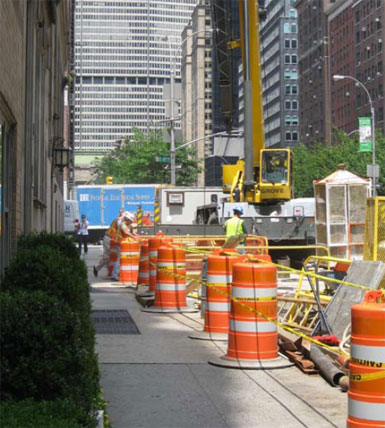
Crane placed on the street for construction activity. Cranes may require permits from DOB in addition to NYC DOT.
Sidewalk Construction Permits
This category of permits applies to any repairs, replacements or new sidewalk installations. Sidewalk Construction Permits are generally taken out by entities that need to perform work on sidewalks, including developers, contractors, and private homeowners (for sidewalk repairs and only if performing the work themselves).
Canopy Authorizations and Permits
This category of permits applies to authorizations and permits required to place a canopy* over the sidewalk. A one-time Street Opening Permit must also be obtained to install the poles that support the canopy. Canopy permits are generally taken out by building owners, business owners, and canopy installers.
3.2 The Permittee Registration Process
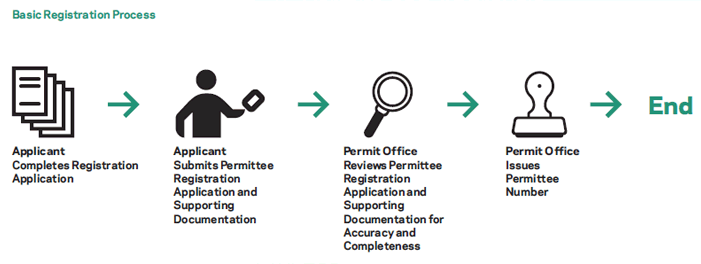
In order to apply for a permit, an applicant must first register with NYC DOT by submitting a completed Permittee Registration Application along with insurance and supporting documents. Although registration is a one-time process, registered applicants must keep all insurance and general information up to date.
3.2.1 Required Documentation for a Permittee Registration Application
The required documents include:
- Completed Permittee Registration Application. Click here for a completed Permittee Registration Application. An application can also be found in Appendix B, Forms.
- Copy of E.I.N. or Tax I.D. number as provided by the Internal Revenue Service (IRS).
- Original insurance certificates for Commercial General Liability (CGL) insurance and Worker's Compensation insurance.
- CGL insurance. The applicant must satisfy all of the requirements listed in section 2-02(3) of the Highway Rules. Additionally, Section 2-02(3) contains an indemnification provision to which all permittees are subject.
- Worker's Compensation Insurance. Each applicant must obtain and provide Worker's Compensation insurance in accordance with the laws of the State of New York from a licensed insurance company.
- Permit Bond. Where applicable, an applicant must submit an original Permit Bond to the Permit Office at the time of permit issuance to cover all costs and expenses that may be incurred by the city as a result of the activity for which the permit is issued or for the purpose of otherwise safeguarding the interests of the city. Permit Bonds, as described in the Highway Rules, Section 2-02(4), should cover all permitted activities. Click here to download Permit Bond templates.
- Copies of incorporation papers, licenses, and business certificate or filing receipt filed with the state of New York.
All addresses must be the same on all above referenced documents.
Instructions for Permittee Registration Application
The instructions below apply to corporations, partnerships, joint ventures and individuals. Registration applications should be printed on 8 1/2"x 14" paper. Please note all fields marked with an asterisk (*) on application must be completed.
SECTION 1A THROUGH 1D: APPLICANT INFORMATION
1A. Applicant Information (Corporation, LLC or LLP)
- Permittee Legal Name*: Enter the legal name of the corporation, limited liability corp. or limited liability partnership as registered with the NYS Department of State (NYSDOS).
- Tax ID Number (EIN) or Social Security Number*: Enter Tax ID as provided by Internal Revenue Service or SS number as provided by Social Security Administration.
- NYS Department of State I.D. Number*: Enter your NYS Department of State ID number. If you are unsure of the number it can be found at http://www.dos.ny.gov/corps/ .
- Address*: Enter the applicant’s complete address (address number, street name, apt. /Suite. Post Office Box is not accepted).
- City, State, Zip Code*: Enter city, state and zip code.
- Telephone Number*: Enter daytime telephone number.
Fax Number: Enter applicants fax number. - 24-Hour Emergency Telephone Number*: Enter a telephone number where applicant can be reached at all times (for emergency situations).
- Applicant E-Mail: Enter email for owner of company or company email address (DOT correspondence pertaining to permits will be sent to this email address). E-mail address is required if applicant wishes to use on-line Permit Management system.
Information contained in Items 9 through 11 is optional - NYSDOS Process Name: Enter name to which DOS will mail process if accepted on behalf of the entity.
- NYSDOS Process Address: Enter address to which DOS will mail process if accepted on behalf of the entity.
- Assumed Name (Doing Business As): Enter Assumed Name/Doing Business As (DBA) if applicable.
1B. APPLICANT INFORMATION (PARTNERSHIP)
- Permittee Legal Name*: Enter the legal name of the partnership as filed with Clerk of County.
- Tax ID Number (EIN) or Social Security Number*: Enter Tax ID as provided by Internal Revenue Service or SS number as provided by Social Security Administration.
- Index Number: Enter your Index number as provided by County Clerk’s office.
- Through 8. Enter information as indicated in 1A above.
1C. APPLICANT INFORMATION (JOINT VENTURE)
- Permittee Legal Name*: Enter the legal name of the joint venture as provided by the Agreement.
- Tax ID Number (EIN) or Social Security Number*: Enter Tax ID as provided by Internal Revenue Service or SS number as provided by Social Security Administration.
- Address*: Enter the applicant’s complete address (address number, street name, apt. /Suite. Post office Box is not accepted).
- City, State and Zip Code*: Enter city, state and zip code information
- Through 7. Enter information as indicated in 1A above.
1D. APPLICANT INFORMATION (SOLE PROPRIETORSHIP)
- Permittee Legal Name*: Enter the legal name of the company.
- Tax ID Number (EIN) or Social Security Number*: Enter Tax ID as provided by Internal Revenue Service or SS number as provided by Social Security Administration.
- Address*: Enter the applicant’s complete address (address number, street name, apt. /Suite. Post office Box is not accepted).
- City, State and Zip Code*: Enter city, state and zip code information
- Through 7. Enter information as indicated in 1A above.
SECTION 2: APPLICABLE LICENSE NUMBERS*
Plumbers*: Enter the plumber's license number and name on license (if applicable).
Commercial Refuse Container Carting Companies*: You must enter your Business Integrity Commission (BIC) License or Registration number.
SECTION 3: CATEGORY OF WORK PERFORMED
Check all types of work that will be performed by the applicant or his/her corporation.
SECTION 4: WORK IN BOROUGH
Check each borough in which the applicant expects to work.
SECTION 5: DESIGNATED REPRESENTATIVE(S) TO ACCEPT SERVICE OF SUMMONS AT THE APPLICANT'S BUSINESS OFFICE:
Enter the names of at least two people who are authorized to accept summonses for his/her corporation and who are located at his/her business address.
SECTION 6: LEGAL ENTITY PERSONNEL: OFFICERS/ DIRECTORS/ MANAGING AGENTS/ OWNER/ PARTNERS /MEMBERS /INDIVIDUALS, ETC. (NAME AT LEAST 2)
Enter at least two names of corporate officers, director, managing agent, owners, partner, etc., with titles and telephone number.
SECTION 7: AUTHORIZED REPRESENTATIVES TO OBTAIN PERMITS
Enter all persons authorized to obtain permits for the applicant, their affiliation to the applicant and their telephone number and email address. Include the names of any expediter. If the applicant makes any changes to these authorized representative(s), he or she must update the Permittee Registration Application.
Section 8: SIGNATURE OF LEGAL ENTITY OFFICER (THIS INDIVIDUALS NAME WILL APPEAR ON ALL DOT PERMITS)
Print his/her name and title and provide a signature.
NOTARIZE THE FORM. Form must be notarized.
Click here for a copy of the Instructions for Permittee Registration Application.
3.2.2 Permittee Registration Application Submittal
New permittees must first email the Commercial General Liability Policy for review, email the policy to constructionpermits@dot.nyc.gov and await a response.
The completed Permittee Registration Application and other required documents must be submitted to the NYC DOT central Permit Office to complete the registration process.
A full review will typically take between one or two business days.
When all necessary information has been submitted and reviewed, the applicant is issued a Permittee ID Number that must be used on all permit applications. This number should be kept confidential and only used to apply for NYC DOT permits.
Questions regarding permit registration can be directed to the central Permit Office. The contact information and hours of operation can be found in Appendix C, NYC DOT Contact Information.
Homeowners applying for Sidewalk Construction permits who intend to do the work themselves do not need to register.
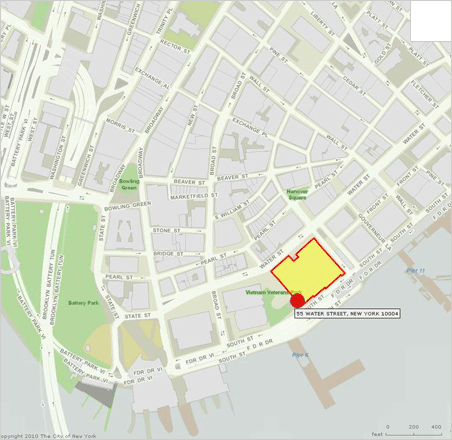
The central Permit Office entrance is via Vietnam Memorial Plaza between Water and South Streets.
3.3 The Permit Application Process (Non-Emergency Work)

There is one permit application form that covers Street Opening, Building Operations/Construction Activity, and Sidewalk Construction permits for non-governmental work. These applications can be submitted online using NYCStreets. Applicants who prefer to apply in person may do so using an Application for Roadway/Sidewalk Permit(s) or see Appendix B, Forms. There are separate permit applications for governmental work, Canopy Permits, and permit renewals and re-issuance, all of which are explained later in this chapter.
In some cases, applications and supporting documentation must be submitted in person. The location to which the application should be submitted depends on the location and type of construction-related work to be performed:
Central Permit Office in Manhattan—In-person applications for non-emergency work, including work on all streets in Manhattan and on all critical streets in Brooklyn, Queens and the Bronx; all work to be performed for sewer and water system construction; and all capital project work, all utility work, all crane requests, and all full closures of sidewalks and roadways must be submitted only to the central Permit Office in Manhattan.
Borough Permit Offices—In-person applications for all other construction-related work can be submitted to the borough office in the borough in which the work is to be performed. The Staten Island borough permit office also accepts applications for work on critical streets in Staten Island. The contact information and hours of operation for all Permit Offices can be found in Appendix C, NYC DOT Contact Information.
3.3.1 Common Requirements for All Permit Types

- Applicants must be registered with NYC DOT and have a Permittee ID Number, except in the case of a Sidewalk Repair Permit taken out by a homeowner, where the work will be performed by the homeowner.
- Applicants must submit a completed permit application. Generally, applicants must provide business and contact information; proposed work information, including location, size of proposed work, and the work start and end date; type of permit(s) being requested; detailed work zone sketch; and date and signature of applicant or authorized representative. View the permit application or see Appendix B, Forms.
- Applicants must obtain all applicable original permits and/or approvals from any other governmental agencies prior to applying for a permit. Common examples include approval from the New York City Department of Parks and Recreation (Parks) if any street trees or tree pits will be affected by the proposed work; a permit from the New York City Department of Environmental Protection (DEP) if any water or sewer line will be affected; and a Certificate of Appropriateness from the New York City Landmarks Preservation Commission (LPC) if the proposed work is within an Historic District. Copies may be accepted if approved by the Permit Office in advance. A table showing the agencies that must be contacted prior to applying for certain NYC DOT permit types can be found in Appendix A, Common Permit Types and Documents Needed; a list of contact numbers for these agencies can be found in Appendix D, Other Agency and Utility Contact Information.
- If the applicant intends to work on a contract that has been awarded by a government agency or authority, the applicant must bring a copy of the contract, Order on Letter, Notice to Proceed or a Letter of Authorization. Applicants should indicate on the application, Application for Governmental Work Permit(s), their name and the name of the governmental agency or authority for which they are working. Access the Application for Governmental Work Permit(s) or see Appendix B, Forms.
- If the applicant intends to fully close a roadway, a Request for Full Roadway Closure must be completed or see Appendix B, Forms.
- If the applicant intends to do work associated with a Franchise, Concession or Revocable Consent Agreement, the applicant must have a copy of the Agreement prior to applying for a permit.
- Any work is subject to suspension during an NYC DOT-issued embargo period*, unless otherwise designated.
Questions regarding permit registration or application processes can be directed to any Permit Office. Contact information can be found in Appendix C, NYC DOT Contact Information
3.3.2 Application Procedures for a Street Opening Permit
Street Opening Permits are required for excavations or other work in a city street that disturbs the street surface.
Outlined below are the basic application procedures for Street Opening Permits. These are in addition to the "Common Requirements" listed at the beginning of this section. Additional requirements are contained in Sections 2-02 and 2-11 of the Highway Rules and should be consulted before any work is performed on the street.
- Street Opening Permits are designated as the "01" permit series, meaning all permits in this category begin with "01." Listed on the following page are the most commonly requested Street Opening Permit types which may be used when completing an application. A separate permit is required for each street opening activity.
- All Street Opening permit types usually allow for work within 300 linear feet by a width of 12 feet. Other conditions may apply, such as a variation in the distance and width of the job, which may increase the fee required. For further information regarding fees, the applicant should refer to Section 2-03 of the Highway Rules.
- An application for a Street Opening Permit on a protected street will automatically be placed on a Street Arterial Maintenance (SAM) hold if the proposed work is to start within 18 months of the street being resurfaced or reconstructed. The hold is to review the proposed work and set conditions for the work and/or the street restoration. More information on this and other "holds" that may be placed on permit applications can be found in Section 3.5 Other Provisions Pertaining to Permits of this chapter.
Information on restoration requirements following street openings/excavations can be found in Chapter 4 Executing Work in the Street.
Protected Streets Listing
A street is considered to be protected for five years from the date it was last resurfaced or reconstructed. The purpose of placing a street in protected status is to maintain the integrity of a new street surface.
The list of protected streets is updated daily and is accurate as of the previous business day. Prior to submitting a Street Opening Permit application, the Protected Streets Listing should be consulted in order to determine if the proposed work location is in protected status. If the proposed work location is in protected street status, the application will automatically be placed on SAM hold for further review.
Only in circumstances where the applicant can demonstrate that the work could not have been reasonably anticipated prior to the street resurfacing/reconstruction will an application for a Street Opening Permit on a Protected Street be reviewed.
The Protected Streets Listing consists of four separate files, each covering all five boroughs:
- Protected street status for segments
- Protected street status for intersections
- Active/Future start dates of projects for segments
- Active/Future start dates of projects for intersections
All streets on the "Active/Future" lists show the anticipated start date of the project. This information should be used to plan work before streets go into protected street status.
View the Protected Streets Listing.
| Street Opening Permits (Non-Protected) | Street Opening Permits (Protected) |
||||
| TYPE | NAME | FEE | DURATION IN DAYS | PERMIT NO. | FEE |
|---|---|---|---|---|---|
| 0100 | Open Sidewalk To Install Foundation | $135 | 30/90 | 0100P | $135 |
| 0102 | Major Installations – High Voltage | $135 | 30/90 | 0102P | $380 |
| 0103 | Major Installation – Gas | $135 | 30/90 | 0103P | $380 |
| 0104 | 0104 Major Installations – Steam | $135 | 30/90 | 0104P | $380 |
| 0105 | Major Installations – Telephone | $135 | 30/90 | 0105P | $380 |
| 0106 | Transformer Vault – In Roadway | $135 | 30 | 0106P | $380 |
| 0107 | Transformer Vault – In Sidewalk Area | $135 | 30 | 0107P | $135 |
| 0108 | Installation Of Poles | $135 | 30 | 0108P | $135 |
| 0109 | Major Installations – Water | $135 | 30/90 | 0109P | $380 |
| 0110 | Major Installations – Cable | $135 | 30/90 | 0110P | $380 |
| 0111 | Major Installations – Sewer | $135 | 30/90 | 0111P | $380 |
| 0112 | Rapid Transit Construct/Alteration | $135 | 30/90 | 0112P | $380 |
| 0113 | Repair Water | $135 | 30 | 0113P | $380 |
| 0114 | Repair Sewer | $135 | 30 | 0114P | $380 |
| 0115 | Repair Water - Sewer | $135 | 30 | 0115P | $380 |
| 0116 | Fuel Oil Line | $135 | 30 | 0116P | $135 |
| 0117 | Vault Construction or Alteration | $135 | 30 | 0117P | $135 |
| 0118 | Reset, Repair Or Replace Curb | $135 | 30 | 0118P | $135 |
| 0119 | Pave Street-W/ Engineering & Inspection Fee | $135 | 30 | 0119P | $135 |
| 0120 | Tree Pits | $135 | 30 | 0120P | $135 |
| 0121 | Construct Or Alter Manhole Or Casting | $135 | 30 | 0121P | $380 |
| 0122 | Repair Gas | $135 | 30 | 0122P | $380 |
| 0123 | Repair Steam | $135 | 30 | 0123P | $380 |
| 0124 | Repair Electric/Communications | $135 | 30 | 0124P | $380 |
| 0126 | Test Pits, Cores Or Boring | $135 | 30 | 0126P | $380 |
| 0127 | Conduit Construction And Franchise | $135 | 30 | 0127P | $380 |
| 0128 | Erect Canopy | $135 | 30 | ||
| 0129 | Install Street Furniture | $135 | 30/90 | 0129P | $135 |
| 0130 | Land Fill | $135 | 30 | 0130P | $135 |
| 0131 | Private Sewer | $135 | 30 | 0131P | $380 |
| 0132 | Install Fence | $135 | 30 | 0132P | $135 |
| 0133 | Install Traffic Signals | $135 | 30 | 0133P | $380 |
| 0134 | Repair Petroleum Leak | $135 | 30 | 0134P | $380 |
| 0138 | Installation Of Fire Alarm Box | $135 | 30 | 0138P | $135 |
| 0139 | Installation Of Bus Shelter | $135 | 30 | 0139P | $135 |
| 0151 | Installation Public Pay Telephone | $135 | 30 | 0151P | $135 |
3.3.3 Application Procedures for a Building Operations/Construction Activity Permit
Building Operations/Construction Activity Permits apply to construction activities that take place within the street and are generally associated with construction work adjacent to the street. A valid permit issued by DOB is usually required in order to apply for permits in this category. Some of the activities covered include placement of materials, equipment and temporary structures on the street or movement of construction equipment across roadways and sidewalks. It also covers installations above the street such as banners and decorative lights and permanent installations on the street such as bike racks.
Outlined below are the basic application procedures for Building Operations/Construction Activity Permits. These are in addition to the "Common Requirements" listed at the beginning of this section. Additional requirements are contained in Sections 2-02 and 2-05 of the Highway Rules and should be consulted before any work is performed on the street.
- Building Operations/Construction Activity Permits are designated as the "02" permit series, meaning all permits in this category begin with "02". Listed in the table are the most commonly requested Building Operations/Construction Activity Permit types, which may be used when completing an application. A separate permit is required for each construction-related activity, except where otherwise provided in the Highway Rules or by permit stipulations.
- An Occupancy of Sidewalk Permit is required when either more than 3 feet from the property line is obstructed by a fence or a minimum of 5 feet of clear path cannot be maintained for pedestrians, or as otherwise stipulated.
- An Occupancy of Roadway Permit is required for closing all or part of one or more lanes of roadway and/or during blasting operations.
- A permit is required to place any construction trailer or similar structure in the street.
- For building operations, a crane permit is required for all cranes and derricks operating in the street on building construction or related activity under the jurisdiction of DOB, with the exception of truck cranes with telescopic, hydraulic or folding booms, over 50 feet and not more than 135 feet with a maximum rated capacity of 3 tons, for which a construction activity permit has been issued. Other requirements may apply to the movement of cranes within city limits, such as daily or annual over-dimensional travel permit(s) as issued by NYC DOT.
- For street operations, a crane permit is required for all cranes and derricks operating in the street with a maximum rated capacity greater than 20 tons and which are not related to building operations. Other requirements may apply to the movement of cranes within city limits, such as daily or annual over-dimensional travel permit(s) as issued by NYC DOT.
- The applicant may be required to address the circumstances of a hold before a permit is released. An explanation and description of "Holds" may be found in Section 3.5 Other Provisions Pertaining to Permits of this chapter.
Building Operations/Construction Activity Permits
| PERMIT NO | NAME | FEE | DURATION |
|---|---|---|---|
| 0201 | Place Material on Street | $50 | 90 days |
| 0202 | Crossing Sidewalk | $50 | 90 days |
| 0203 | Place Crane Or Shovel On Street | $50 +$100 inspection fee | 1 week |
| 0204 | Place Equipment Other Than Crane Or Shovel | $50 | 90 days |
| 0205 | Place Shanty Or Trailer On Street | $50 | 90 days |
| 0207 | Franchise Installations (Overhead Structures) | $50 | 90 days |
| 0208 | Temporary Pedestrian Walk | $50 | 90 days |
| 0211 | Occupancy Of Roadway As Stipulated | $50 | 90 days |
| 0214 | Place Container On The Street | $50 | 90 days |
| 0215 | Occupancy of Sidewalk As Stipulated | $50 | 90 days |
3.3.4 Application Procedures for a Sidewalk Construction Permit
Sidewalk Construction Permits apply to any repairs, replacements or new sidewalk installations.
Outlined below are the basic application procedures for Sidewalk Construction Permits. These are in addition to the "Common Requirements" listed at the beginning of this section. Additional requirements are contained in Sections 2-02 and 2-09 of the Highway Rules and should be consulted before any work is performed on the street.
- Sidewalk Construction Permits are designated as the "04" permit series, meaning all permits in this category begin with "04". Listed in the table are the most commonly requested Sidewalk Construction Permit types, which may be used when completing an application. A permit is not required to install, repave, reconstruct or repair any sidewalk where the work involves an area of less than 25 square feet, unless the purpose of the work is to remove a violation.
- A separate Occupancy of Sidewalk Permit is required if a minimum of 5 feet cannot be maintained on the sidewalk for unobstructed pedestrian passage.
- If the existing sidewalk is the structural roof of a vault or other opening, a DOB-approved plan for the restoration of the sidewalk, must be submitted as part of the application process.
- The applicant may be required to address the circumstances of a hold before a permit is released. An explanation and description of "Holds" may be found in Section 3.5 Other Provisions Pertaining to Permits of this chapter.
NYC DOT accepts and processes applications by mail for sidewalk repair performed by private homeowners. This unique procedure is described below.
Applying for a Sidewalk Repair Permit by Mail (Private Homeowners ONLY)
If a private homeowner is applying for a Sidewalk Repair Permit, and will be making the repair by himself/herself, the homeowner may apply for a permit by mail. (If the homeowner is using a contractor, the contractor must be registered with NYC DOT and must take out the permit.) Outlined below are the basic procedures in applying for a Sidewalk Repair Permit by mail:
- The private homeowner must complete the application for a Roadway/Sidewalk Permit. This permit application can also be found in Appendix B, Forms, or by calling 311.
- A mandatory Affidavit of Ownership must be completed, notarized and the original returned with the permit application. This form may also be obtained in Appendix B, Forms. This form verifies that the person applying for the permit is the homeowner and will be performing the repairs to the sidewalk pursuant to the permit issued by NYC DOT. No permit will be issued unless the affidavit is complete and notarized.
- The completed application, affidavit, a stamped self-addressed envelope and a certified check made payable to NYC DOT for the permit fee (currently $70.00 for up to 300 linear feet) must be mailed to:
The New York City
Department of Transportation
Permit Management & Construction Control Permit by Mail
55 Water Street, Concourse Level
New York, New York 10041
Upon receipt of the above and verification for completeness, a Sidewalk Repair Permit will be issued and mailed to the applicant. Information on the restoration requirements for sidewalk repairs can be found in Chapter 4 Executing Work in the Street.
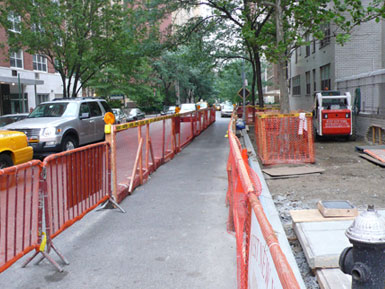
A permit is required for new sidewalk installation, repairs, and replacements. Projects requiring sidewalk closure may require additional permits.
Sidewalk Construction Permits
| PERMIT NO | NAME | FEE | DURATION |
|---|---|---|---|
| 0401 | Repair Sidewalk | $70 | 30 days |
| 0402 | Construct New Sidewalk | $70 | 30 days |
| 0403 | Replace Sidewalk | $70 | 30 days |
| 0404 | Construct New Sidewalk With Heating Pipe | $70 | 30 days |
| 0405 | Construct New Sidewalk Builders Pavement | $70 | 30 days |
3.3.5 Permit Application Review and Issuance (for Street Opening, Building Operations/ Construction Activity, and Sidewalk Construction Permits)
Permit Review is the process by which NYC DOT reviews permit applications and supporting documentation and makes determinations regarding the issuance of permits and permit stipulations. In some cases, applications and supporting documentation must be submitted in person, however the majority of permit applications may be submitted online.
Review Procedures in the Central Permit Office
In-person applications for non-emergency work, including work on all streets in Manhattan and on all critical streets in Brooklyn, Queens and the Bronx; all work to be performed for sewer and water system construction; and all capital project work, all utility work, all crane requests, and all full closures of sidewalks and roadways must be submitted to the central Permit Office in Manhattan.
Following are the steps for permit application, review and issuance at the central Permit Office:
- The applicant submits permit application, proof of insurance (originally supplied during the registration process) and supporting documentation for review as to accuracy and completeness.
- If the application and its supporting documentation are accepted, the OCMC Project Manager (PM) reviews the application and all associated documents and adds the permit stipulations to the permit application. View the most commonly issued permit stipulations or see Appendix F, Permit Stipulations.
- If the applicant does not accept the permit stipulations, he or she can request a review with the PM. If the applicant does not agree with the PM, he or she is informed of the appeals process.
- During the processing of the permit, if there is a hold, the applicant is notified of the type of hold and the steps the applicant must take to release the hold. Section 3.5 Other Provisions Pertaining to Permits contains more information on holds.
- If there is no hold, the permit is issued to the applicant after appropriate payment is received. The central Permit Office accepts money orders, company checks, certified checks and most major credit cards as payment for permit fees.
Review Procedures in Borough Permit Offices
Applications for all other construction-related work, including work on critical streets in Staten Island, can be submitted to the borough office in the borough in which the work is to be performed.
Following are the steps for permit application, review and issuance at the borough Permit Offices:
- The applicant submits permit application, proof of insurance (originally supplied during the registration process) and supporting documentation for review as to accuracy and completeness.
- If all the documentation is accepted, pre-determined permit stipulations are added to the permit and the application is sent for processing.
- If there is a hold during the processing of the permit, the applicant is notified of the type of hold and the steps to take to release the hold. Section 3.5 Other Provisions Pertaining to Permits contains more information on holds.
- If there is no hold, the permit is issued to the applicant after appropriate payment is received. All borough Permit Offices accept money orders, company checks, certified checks and most major credit cards for permit fees.
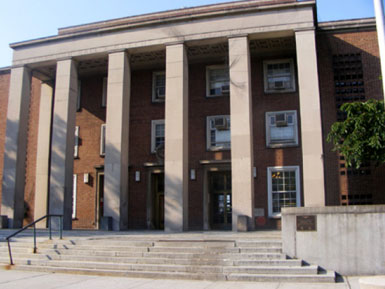
There are borough permit offices in Brooklyn, the Bronx, Queens and Staten Island. The Queens borough permit office is located in Queens Borough Hall.
3.3.6 Permit Renewals and Re-Issuances (for Street Opening, Building Operations/Construction Activity, and Sidewalk Construction Permits)
All construction-related permits have expiration dates. If a permit is about to expire and the permittee has not completed the work, the permittee must apply for a permit renewal as all work must be performed pursuant to an active permit at all times. The permittee may apply for a renewal online, or in-person by accessing either the Application to Renew Permits or the Application to Renew Governmental Permit(s). These forms may also be found in Appendix B, Forms. The permittee must attach a copy of the original permit to the application when it is submitted for renewal and all applicable reviews and fees will apply. This form cannot be used if the permit has already expired.
Permits that have expired may be reissued only within 30 days ![]() of expiration. The permittee may apply for a re-issuance online, or in-person by accessing either the Application to Re-Issue Permits or the Application to Re-Issue Governmental Work Permit(s). These forms may also be found in Appendix B, Forms. Re-issued permits will not apply retroactively and are subject to new permit stipulations. The permittee must attach a copy of the original permit to the application when requesting a re-issuance and all applicable reviews and fees will apply. If the permit has been expired for more than 30 days
of expiration. The permittee may apply for a re-issuance online, or in-person by accessing either the Application to Re-Issue Permits or the Application to Re-Issue Governmental Work Permit(s). These forms may also be found in Appendix B, Forms. Re-issued permits will not apply retroactively and are subject to new permit stipulations. The permittee must attach a copy of the original permit to the application when requesting a re-issuance and all applicable reviews and fees will apply. If the permit has been expired for more than 30 days ![]() , a new permit application must be submitted.
, a new permit application must be submitted.
3.4 Canopy Authorizations and Permits
Canopy authorizations and permits are required to place a canopy over the sidewalk. Canopy placement must be adequate for public safety and must be suitable to the circumstances of the proposed canopy location and not interfere with the public use of the sidewalk.
Listed in the following paragraphs are some of the requirements for canopy authorizations and permits. The full list of rules and regulations is contained in the Highway Rules, Sections 2-02 and 2-04, and should be consulted before any work is performed on the street.
- Canopy placement must be approved by the owner of the property to which the canopy will be attached.
- Canopy design and construction must be in accordance with NYC DOT Standard Details of Construction. View the most recent version of Drawing #H1029 of the NYC DOT Standard Details of Construction.
- Canopy permits are not transferable from person to person or from the location of original issue.
- No attachments of any kind are permitted on a canopy, including, but not limited to temporary or permanent signs, balloons, streamers, flags, banners or pennants.
- Canopies must be well-maintained at all times.
- Canopies must be fully roofed.
A list of partially and fully restricted streets where canopy placement is limited or prohibited can be found in the Highway Rules, Section 2-04(f).
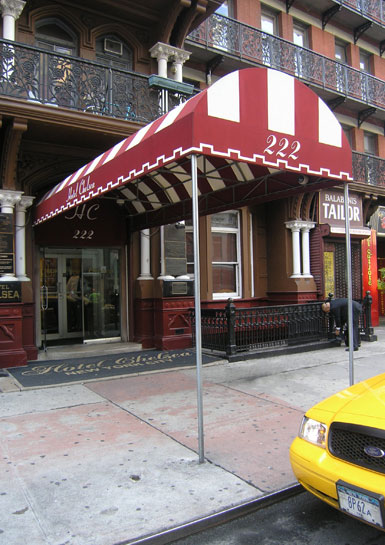
NYC DOT authorization is required before installing a canopy over the sidewalk.
3.4.1 Application Procedure for Canopy Authorizations and Permits
Application for a canopy installation involves three major steps. First, the applicant must obtain authorization from the Highway Inspection and Quality Assurance (HIQA) unit for the placement of the canopy at the proposed location. Second, after obtaining HIQA's authorization, the applicant must obtain a permit to install the canopy at the approved location and apply for a permit to maintain the canopy once it is installed. The permit to maintain the canopy will remain on hold until after the canopy is installed and inspected. Third, following installation of the canopy, a final inspection by HIQA is required to confirm compliance with the applicant's submitted plans. After the canopy passes final inspection, HIQA will release the hold and the applicant must return to the Permit Office to obtain the permit to maintain the canopy.
Following are the specific steps for canopy authorizations and permits:
Authorization
- To request authorization for the installation of a canopy, an applicant must initiate the process at the HIQA office in the borough where the proposed canopy will be located. At the HIQA borough office, applicants will be given a Canopy Authorization Application (Appendix B, Forms, contains a copy of this application), which outlines the requirements necessary to gain authorization. HIQA borough office locations may be found in Appendix C, NYC DOT Contact Information.
- The applicant submits a completed Canopy Authorization Application, which must include the following:
- Written approval from the owner of the property to which the canopy will be attached.
- A statement of the basic construction details including type, description and color of the canopy covering; type, diameter and gauge of all supporting members; description of the frame, wind bracing assembly and sidewalk and building fastenings; description of proposed lettering on the canopy covering including exact wording and dimensions thereof; three 5 inch by 7 inch photographs of the proposed site.
- A statement that the canopy design and construction conforms to NYC DOT Standard Details of Construction. See the most recent version of Drawing # H1029 of the NYC DOT Standard Details of Construction.
- A sketch showing the canopy dimensions, location and all street facilities and furniture within 15 feet of both sides of the proposed canopy.
- If applicable, a permit from the Landmarks Preservation Commission (LPC) for the placement of a canopy in a historic district or attached to a landmarked building. The permit application is available online. View additional information about historic districts.
- Certification by the manufacturer that the covering is flameproof. Where certification is unobtainable from the manufacturer, certification by the installer may be submitted instead.
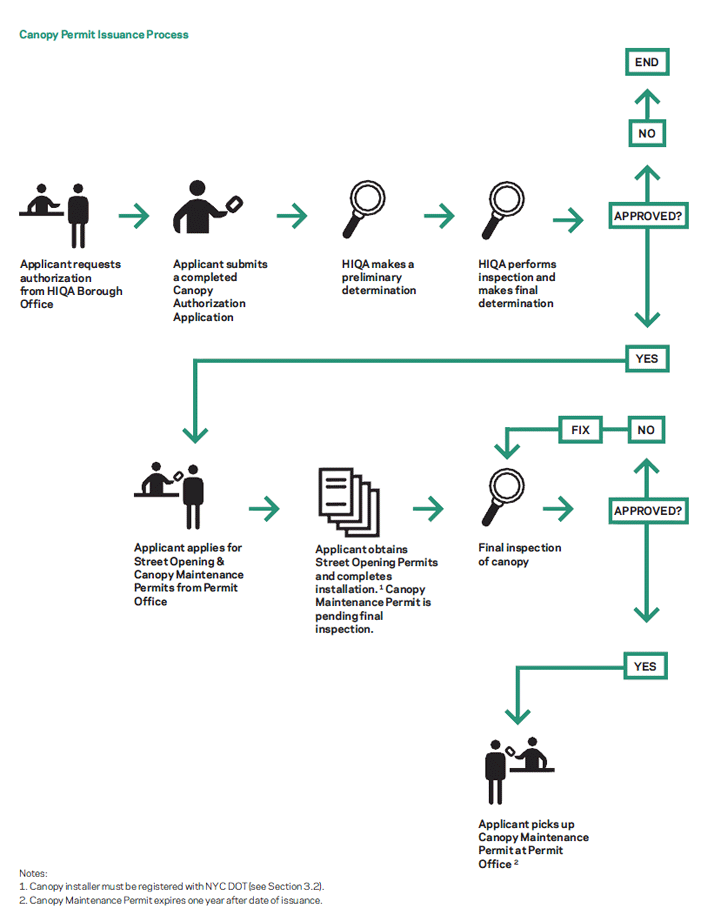
- Based on the documents submitted, HIQA makes a preliminary determination as to whether the proposed location may be suitable for a canopy. If the proposed location may be suitable, HIQA performs an inspection in order to confirm its suitability.
- Upon completion of the inspection, HIQA makes a final determination as to whether the location is suitable for a canopy placement. If the location is deemed suitable, HIQA signs the Canopy Authorization Form indicating HIQA approval and returns it to the applicant. If the proposed location is unsuitable, the canopy authorization is denied and the request for a canopy ends at this point. However, a new request may be submitted at a later date, if conditions at the location change.
Obtaining Installation Permit, Installation and Application for Maintenance Permit
- After obtaining HIQA's authorization, the applicant will be referred to the Permit Office in the borough in which the canopy will be located.
A permit must be obtained to install the canopy at the approved location (Erect Canopy Permit from the "01" Street Opening Permit series). Only a canopy installer or authorized agent that is registered with NYC DOT can apply for a permit to install the canopy.
In addition, a second permit must be applied for to maintain the canopy. The canopy maintenance permit is from the "07" Canopy Permit series; the specific permit type to be applied for depends on the land use to which the canopy is being attached. The full list of Canopy Permit types is shown in the table. The applicant may apply directly for this permit type without being a registered permittee, provided he or she can demonstrate proof of required insurance. The applicant must maintain valid insurance and a canopy maintenance permit as long as the canopy exists.
- Once the canopy installation permit application has been reviewed and approved by the Permit Office, the permit is issued to the canopy installer or authorized agent, and canopy installation can begin. The second permit for canopy maintenance is automatically placed on a Canopy (CAN) hold until a final inspection has been conducted by HIQA. Section 3.5 Other Provisions Pertaining to Permits contains more information on holds.
Inspection and Obtaining Maintenance Permit
- Once the canopy is installed, the canopy installer or authorized agent must contact the HIQA borough office for a final inspection to determine whether the installed canopy conforms to the submitted plans.
- If the installed canopy fails final inspection, HIQA will reject the canopy maintenance permit and notify the applicant of the rejection. The applicant will also be notified of any corrective action necessary and recourses available.
- If the installed canopy passes final inspection, HIQA releases the CAN hold on the canopy maintenance permit and notifies the original applicant. The applicant will be able to pick up the permit from the Permit Office in the borough in which the canopy is located upon payment of the appropriate fee.
Canopy Permits
| PERMIT NO | NAME | FEE | DURATION |
|---|---|---|---|
| 0701 | Canopy For Hotel | $50 | 1 Year |
| 0702 | Canopy For Restaurant | $50 | 1 Year |
| 0703 | Canopy For Residence | $50 | 1 Year |
| 0704 | Canopy For Miscellaneous | $50 | 1 Year |
| 0705 | Canopy In Connection With Sidewalk Café | $25 | 1 Year |
3.4.2 Canopy Permit Renewals
Each canopy maintenance permit expires one year ![]() after the date of issuance, unless revoked sooner by NYC DOT.
after the date of issuance, unless revoked sooner by NYC DOT.
Applications for renewal of a canopy maintenance permit must be made at least one month prior to the permit expiration date and must be submitted to the Permit Office in the borough in which the canopy is located. All applicable fees will apply.
3.5 Other Provisions Pertaining to Permits
The following section provides information on some issues that may delay the issuance of a permit or that may lead to the revocation of a permit.
3.5.1 Holds
A hold is a "do not release" order that can be placed on permits or permittees to prevent the permit from being processed. Any given permit or permittee may be subject to one or more holds. Contact information pertaining to the release of holds by NYC DOT can be found in Appendix C, NYC DOT Contact Information.
Permit Office and OCMC Holds
Capital Project In-House (CPI) hold — A CPI hold is automatically placed if the proposed permit location involves a street that will be resurfaced by a NYC DOT in-house resurfacing operation in the near future.
CPI holds are regularly released by the borough Administrative Superintendent of Highway Operations (ASHO) if the proposed work does not interfere with the in-house street resurfacing operation. If the hold is not released, the applicant must contact the borough ASHO to determine the feasibility of the work being completed prior to the final resurfacing. If it is determined to be unfeasible, the pending permit will be rejected.
Street Arterial Maintenance (SAM) hold — A Street Opening Permit request to perform work on a protected street will automatically have a SAM hold placed on it if the proposed work start date is within 18 months of the street being resurfaced/reconstructed. The hold is to review the proposed work and set conditions for the work and/or restoration.
To request a release of a SAM hold, the borough ASHO must be contacted to discuss the work and allow the ASHO to determine the extent of the restoration requirements.
Capital Project by Other Agency (CPO) hold — A CPO hold is automatically placed if the proposed permit location involves a current capital street reconstruction project or one that is being planned.
For New York City Department of Design and Construction (DDC) capital projects, a CPO hold can only be released by DDC. CPO holds will typically be released by DDC if the proposed work does not interfere with its schedule. If the hold is not released, the applicant must contact DDC (DDC contact information is available in Appendix D, Other Agency and Utility Contact Information).
For non-DDC capital projects, the applicant may contact the Permit Office to request release of a CPO hold.
Bridge (BOB) hold — Any planned work requiring a Building Operations/ Construction Activity Permit that may potentially be within 100 feet of a bridge structure will be placed on a Bridge hold. If any proposed work is within 100 feet of a bridge or structure, applicants must submit a scaled drawing showing the work and exact location. If the work is more than 100 feet away from the bridge structure, applicants must send a certification by e-mail stating so. Either response must be sent to NYC DOT's Division of Bridges at bridgeshold@dot.nyc.gov for review and release prior to commencing work. Emergency work will not be placed on hold and shall proceed in accordance with Highway Rules, Section 2-11 (g).
The Bridge Hold Map shows locations where Bridge holds apply.
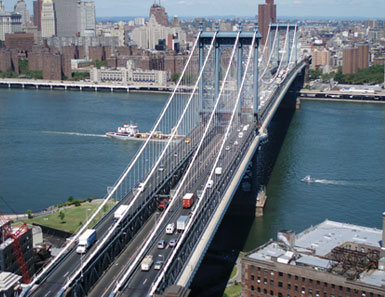
Permit applications near bridges are subject to approval by the Division of Bridges.
Executive (EXC) hold— An EXC hold is automatically placed if the proposed permit locations involve locations deemed necessary by NYC DOT. These include major construction related projects or planned traffic enhancements (e.g., Second Avenue subway, bus rapid transit, water tunnel route), or where there are significant traffic issues (e.g., “thru” streets, exits and entrances to major tunnels and bridges).
These holds can only be released by OCMC executive staff. Once OCMC executive staff determines the final permit stipulations, the permit will be released. However, if extraordinary conditions are present, the applicant may be asked to meet with OCMC.
Full Closure Review (FCR) hold— An FCR hold is automatically placed on the 90th consecutive calendar day of any full street closure. OCMC will review the project to determine if a Community Reassessment Impact and Amelioration (CRIA) statement must be submitted to NYC DOT. A CRIA statement is required if the closure is expected to last for more than 180 consecutive calendar days, as set forth in Section 2-16 of the Highway Rules.
To release an FCR hold, the applicant must demonstrate that either he or she has begun the CRIA process or that the CRIA statement is not required. At that point, OCMC executive staff will determine if additional permit stipulations are required. If no changes are required, the permit will be released.
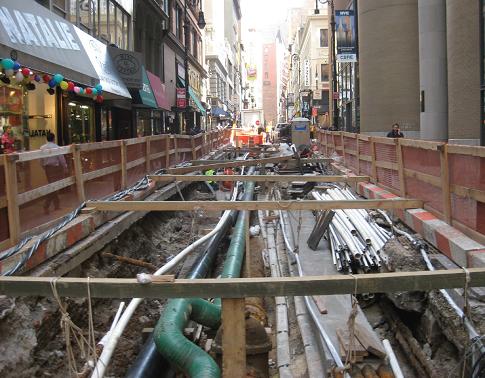
A Full Closure Review (FCR) hold is triggered when a street is closed for 90 days.
OCMC will release the hold after it reviews the proposed work and adds the permit stipulations.
Poles (POL) hold— A POL hold is automatically placed if the proposed permit work is for the installation of a pole on the sidewalk, which must be reviewed, approved and released by NYC DOT Street Lighting.
To release a POL hold, the Division of Traffic Operations, Office of Street Lighting must be contacted.
Vault (VLT) hold— A VLT hold is automatically placed if the proposed permit work is for the installation or repair of a vault, which must be reviewed and released by the Permit Office. To release a VLT hold, the Permit Office’s Plan Examination Unit must be contacted.
LMZ (Lower Manhattan Zone) hold – This hold signifies that you are working on a street that falls within the Lower Manhattan Zone (south of and including Canal Street). Your permit(s) must be reviewed and released by the OCMC Office.
HIQA Holds
There are two categories of HIQA holds: Holds for Specific Permit Type or Unique Street Treatment and Holds that May Be Placed on the Permittee.
These holds can only be released by HIQA:
Holds for Specific Permit Type or Unique Street Treatment
Cobblestone (COB) hold— All permits issued to work on a cobblestone street are automatically placed on hold until a HIQA inspector performs an inspection of the work site to establish existing conditions before work begins.
To request release of a COB hold, the applicant must contact the HIQA borough office in the borough in which the proposed work is to be performed to arrange for an inspector to visit the work site prior to the start of the work.
Concrete (CON) hold— All permits issued to work on concrete portions of the roadway are automatically placed on hold until a HIQA inspector performs an inspection of the work site to establish existing conditions before work begins.
To request release of a CON hold, the applicant must contact the HIQA borough office in the borough in which the proposed work is to be performed to arrange for an inspector to visit the work site prior to the start of the work.
Special Treatment Projects (STP) hold— Any permits issued to work in areas that have a special treatment such as Times Square, Madison Square, Herald Square and other pedestrian plaza areas are automatically placed on hold.
To request release of an STP hold, the applicant must contact the HIQA borough office in the borough in which the proposed work is to be performed. HIQA will determine whether an inspection of the work site is warranted to establish existing conditions before work begins.
Canopy (CAN) hold— A CAN hold is automatically placed on a canopy maintenance permit application until a HIQA inspector performs a final inspection confirming the submitted plans.
To request release of a CAN hold, the applicant must contact the HIQA borough office in the borough in which the canopy is installed to arrange for a final inspection following canopy installation.
Re-Dig (RED) hold— In cases where an inspection has revealed a failed restoration and permittees have been told to redo the entire restoration, a RED hold will be placed. A HIQA inspector must be present during the restoration.
To request release of a RED hold, the applicant must contact the HIQA borough office in the borough in which the proposed work is to be performed.
Holds that May Be Placed on the Permittee
Any of these holds will prevent a permittee from applying for new permits:
New York City Department of Finance (DOF or Finance) hold— If a permittee has failed to pay previously issued summonses/Notices of Violation (NOVs) to the New York City Environmental Control Board (ECB), all future permit requests may be placed on hold until the fees associated with the outstanding summonses/NOVs are paid. (See Chapter 4, Section 4.5 Street Construction Inspections and Enforcement regarding the circumstances in which summonses/NOVs may be issued.)
To request release of a DOF hold, the permittee must contact Finance and either make a payment or agree to a payment schedule for all fees associated with the outstanding summonses/NOVs. Once Finance contacts HIQA, the hold(s) will be released.
Revenue hold— If the permittee owes NYC DOT money for an open Corrective Action Request (CAR) or Jolt Elimination Team (JET) bill, all future permit requests may be placed on hold until the bills are paid. (See Chapter 4, Section 4.5 Street Construction Inspections and Enforcement regarding the circumstances in which CARs may be issued.)
To request release of a Revenue hold, the permittee must contact NYC DOT's Fiscal Affairs Office to arrange for payment of outstanding bills. Upon satisfactory payment, the hold(s) will be released.
Incorrect Information on File— If a permittee’s 24/7 phone number, address or other contact information is inaccurate or has changed without being updated, all future permit requests may be placed on hold until the information is updated.
To request release of the hold, the permittee must contact HIQA’s central office or one of the borough offices to update the file. Upon completion of updates, the holds will be released.
Unsafe Conditions— If the permittee has been notified and fails to address an unsafe condition, all future permit requests may be placed on hold until the unsafe condition has been eliminated.
To have the hold released, the permittee must correct the unsafe condition, and then contact HIQA to arrange for an inspection. Upon a satisfactory inspection, the hold(s) will be released.
Working Without a Permit— If the permittee has been issued a summons/NOV for working without a permit, all future permit requests may be placed on hold until the applicant takes out a permit of record for the work that was performed.
To request release of the hold, the permittee must take out a permit of record for the work that was performed without a permit and then contact HIQA to submit a copy of the permit. Upon completion of this action, the hold(s) will be released.
3.5.2 Permit Revocation
NYC DOT may revoke or refuse to renew a permit for any of the reasons listed below. The Highway Rules, Section 2-02(k) contains additional information.
- For failure to comply with the terms or conditions of such permit, the Highway Rules or other applicable law in carrying out the activity for which the permit was issued;
- Whenever there has been any false statement or any misrepresentation as to a material fact in the application or accompanying papers upon which the issuance of the permit was based; or
- Whenever a permit has been issued in error and the conditions are such that the permit should not have been issued.
Prior to any permit revocation, NYC DOT will give the permittee an opportunity to be heard with not less than two days' notice.
NYC DOT may revoke a permit without affording the permittee an opportunity to be heard prior to the revocation if NYC DOT determines that an imminent peril to life or property exists. In this case, upon request of the permittee, NYC DOT will provide an opportunity to object to the permit revocation within five days after the request is received by NYC DOT.
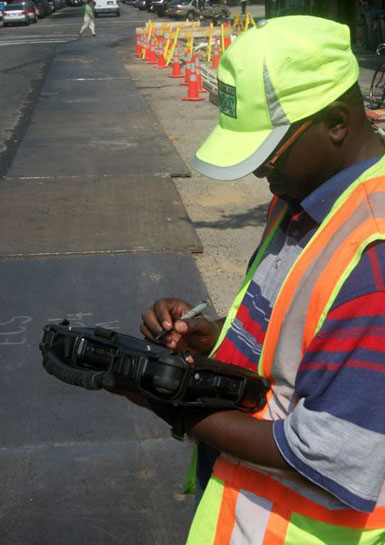
HIQA staff inspecting a work site.
3.5.3 Other Actions
Suspension of Application Review— NYC DOT may suspend the review of applications for permits pending:
- Payment by an applicant of outstanding fines, civil penalties or judgments imposed or entered against such applicant by a court or ECB;
- Payment by an applicant of outstanding fees or other charges lawfully assessed by NYC DOT against such applicant pursuant to the Highway Rules or other applicable law; and/or
- Satisfactory compliance by an applicant with a CAR or order issued by the Commissioner. See the Highway Rules, Section 2-02(j)
Refusal to Issue Permit— NYC DOT may refuse to issue a permit to an applicant:
- Who has exhibited a pattern of disregard for the rules or orders of NYC DOT or the terms or conditions of permits issued by NYC DOT or for other applicable law.
- Who has been found liable by a court or in a proceeding before the ECB of a violation of a rule or order of NYC DOT or the terms or conditions of a permit issued by NYC DOT or other applicable law, which violation caused an imminent peril to life or property. See the Highway Rules, Section 2-02(l).
Voiding and Reissuing of Permits. Permits may be voided and reissued only within three business days of issuance. The fee for reissuance may be found in Section 2-03 of the Highway Rules. Permits reissued after three business days ![]() must be subject to the full permit fee.
must be subject to the full permit fee.
See the Highway Rules, Section 2-02(n).
3.6 Emergency Work and Special Circumstances
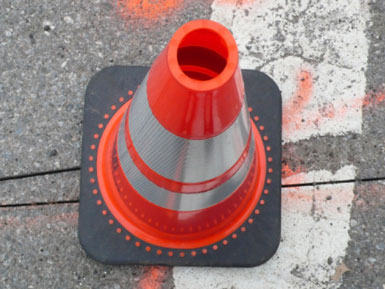
In addition to the application procedures for the four categories of permit types, there are some situations or street conditions that require special procedures. These include:
- Emergency utility access cover openings and emergency street openings/excavations
- Embargoes
3.6.1 Emergency Utility Access Cover Openings and Emergency Street Openings
Certain circumstances are considered to be emergencies, meaning situations that endanger the public safety or cause or are likely to cause the imminent interruption of service. Special and separate procedures govern emergency work: one for utility access covers (including those for "manholes," valve covers and grates) and one for street openings/excavations. The following procedures must be followed to obtain either an emergency authorization number (EAN) for emergency utility access cover work or an Emergency Street Opening Permit Number for emergency street opening work.
Procedures for Obtaining Authorization Numbers for Emergency Utility Access Cover Openings
Any emergency work on a street that involves opening a utility access cover to gain access to an underground facility on a critical street during restricted hours requires an EAN. NYC DOT has a separate procedure for obtaining authorization for emergency utility access cover openings so that applicants can expeditiously perform such work.
Applicants have two options to acquire an EAN. The first option (see Diagram 1) is by using the DOT on-line NYCStreets Permit Management system. Applicants who are registered as permittees (see Section 3.2) and are registered for on-line permitting can log-in to NYCStreets and request an EAN. If all information is satisfactory the applicant is approved and the system auto-generates an email which is sent to the applicant with the EAN. NYCStreets system will automatically block an applicant from submission if insurance is not current.
The second option is available for applicants who do not have the technology to use the above procedure. Applicants must first submit an Emergency Authorization Number Form. The form must be completed and faxed to NYC DOT’s Emergency Authorization Unit (EAU), which will confirm that the applicant's insurance is current and that the location requires an EAN.
If all information is satisfactory, EAU will fax or call the applicant with an EAN, which must be available at the work site and presented to any governmental employee upon request. An EAN is required for each utility access cover opening at a location, provided that the work is performed around the clock until the emergency is eliminated, at which time the EAN expires. The Highway Rules, Section 2-07(c) (4) contains additional information. The applicant will be charged a fee of $30 for each utility access cover opening EAN.
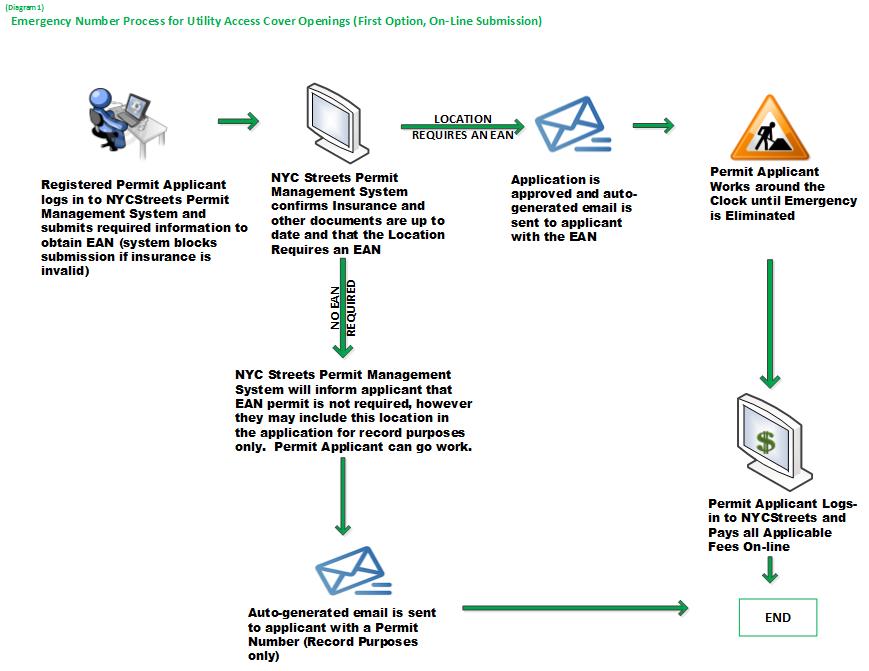
Procedures for Obtaining an Emergency Street Opening Permit
Any emergency work on a street that involves a street opening/excavation requires a Street Opening Permit. NYC DOT has a separate procedure for obtaining permits for emergency street opening/excavation work so that applicants can expeditiously obtain such permits.
Applicants have two options to acquire an emergency street opening/excavation permit. The first and most expeditious option (see Diagram 2), is by using the DOT on-line NYCStreets Permit Management system. Applicants who are registered as permitees (see Section 3.2) and are registered for on-line permitting can log-in to NYCStreets and submit a request for an emergency street opening/excavation permit. NYCStreets confirms that the applicants insurance is current; approves application and auto-generates an Emergency Street Opening permit number, which authorizes the emergency street opening/excavation work. NYCStreets system will automatically block an applicant from submission if insurance is not current.
The second option is available for applicants who do not have the technology to use the above procedure. Applicants must first submit an Emergency Street Opening Permit Form. A copy of the form can also be found in Appendix B, Forms. The form must be completed and faxed to EAU, which will confirm that the applicant's insurance is current. EAU will process the request and fax or call the applicant with an Emergency Street Opening Permit Number, which authorizes the emergency street opening/excavation work. If the insurance is not current, the request will be denied. The Emergency Street Opening Permit Number must be available at the site and presented to any governmental employee upon request. Work must begin within two hours ![]() after obtaining an Emergency Street Opening Permit Number and must be performed around the clock until the emergency is eliminated, unless otherwise directed by NYC DOT. Only one Emergency Street Opening Permit Number is required for a specific work location.
after obtaining an Emergency Street Opening Permit Number and must be performed around the clock until the emergency is eliminated, unless otherwise directed by NYC DOT. Only one Emergency Street Opening Permit Number is required for a specific work location.
Following issuance of the Emergency Street Opening Permit Number, the permittee must submit an application for a regular Street Opening Permit within two business days ![]() (Highway Rules, Section 2-11(g)). This Street Opening Permit retroactively covers the emergency street opening/excavation work already performed.
(Highway Rules, Section 2-11(g)). This Street Opening Permit retroactively covers the emergency street opening/excavation work already performed.
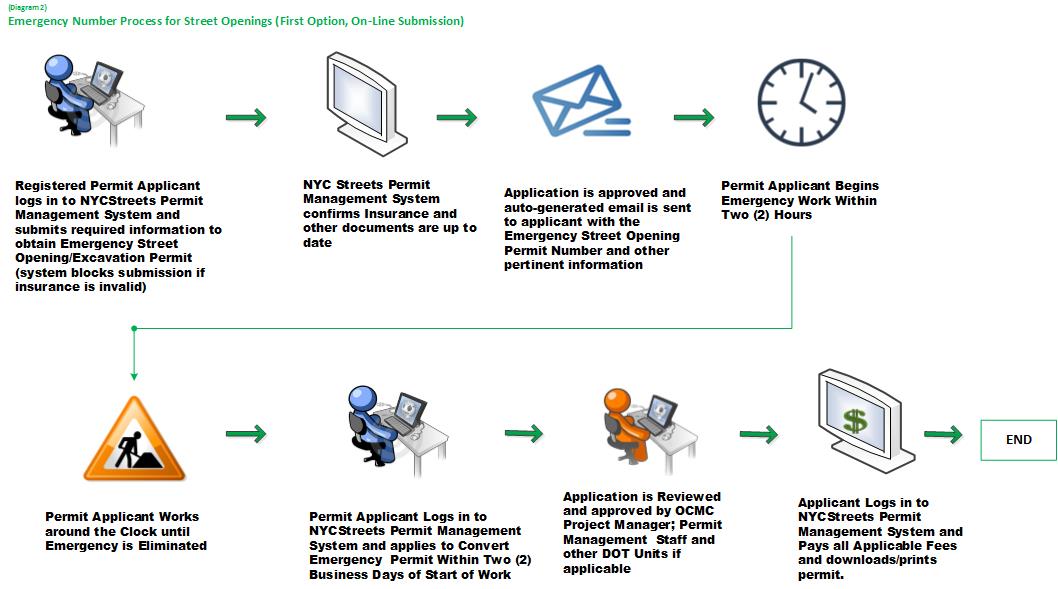
3.6.2 Embargoes
OCMC imposes construction embargoes* for significant special events including the New York City Marathon, parades, high profile projects and for the winter holiday season. All active permits in the affected area(s) are suspended during the dates and times of the embargo period and no new permits may be approved, unless a waiver for the work is granted by OCMC. The suspension does not apply to emergency authorizations and permits (see Section 3.6.1 Emergency Utility Access Cover Openings and Emergency Street Openings).
A list of construction embargoes under way at any given time can be found on the Construction Embargoes page on NYC DOT's website or at the borough Permit Offices.
In order to apply for an embargo waiver, a Request for Roadway/Sidewalk Permits during Embargo Periods form must be submitted for review and consideration to the Permit Office. Applicant should submit this form with the appropriate documentation and waiver request fee. Payment of the waiver request fee, as specified in the Highway Rules, Section 2-03, does not guarantee that approval to work during the embargo period will be granted. If the request is approved or modified, then all conditions, restrictions, fees and application procedures for obtaining a construction-related permit apply.
Winter holiday embargo—The winter holiday embargo typically starts in mid-November and lasts through January 2. As of August 31, 2017, a new Holiday Embargo (HE) review process has replaced the previously used HE waiver request process used by NYCSTREETS. During the application process, the NYCSTREETS system will automatically identify cases which require additional HE review, and processes them accordingly.
If a permit application includes permit requests to work on embargoed streets within 90 days prior to the start of the HE (November 16th), the permittee will be presented with a warning, during the application process, stating that such permit request(s) will be subject to the upcoming HE. If work is planned through the HE period, the critical reasons for the work must be included in the “Work Description” field of the application.
For all permit applications including permit requests to work on embargoed streets through the HE period, the permittee will be automatically charged an additional $135 HE application review fee. Details about the exact holiday embargo dates, times, and locations are posted on NYC DOT's Special Traffic Advisory page, generally in mid-October.
3.7 Vault Approvals
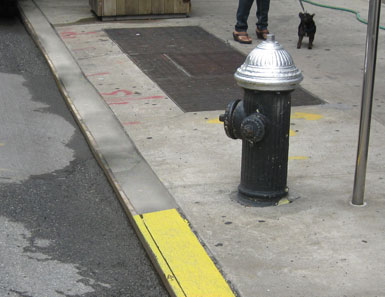
This section describes the application and review process for obtaining approvals to construct or repair vaults under the sidewalks of New York City streets. NYC DOT issues permits for two types of vaults: building vaults and transformer vaults.
A building vault, as described in Section 2-13 of the Highway Rules, is any opening below the surface of the street that projects outside of the property line and is covered over, except for those openings: (1) used exclusively to access, by means of steps, the cellar or basement of any building; (2) used primarily for light and ventilation; (3) constructed or maintained by utility companies (including transformer vaults); and (4) which are subways, railroads and related structures.
A transformer vault is a subsurface structure or room that houses electrical transformers and appurtenant equipment. Transformer vaults are typically installed, owned and maintained by an electric utility company. The city has master revocable consent agreements with electric utility companies that allow them to occupy and use city property for transformer vaults.
The construction, alteration or repair of any building vault or transformer vault requires a permit from NYC DOT. Most vault work also requires plan approval and a permit from DOB. In some cases, approval from the LPC (if the vault is in an historic district) or the Metropolitan Transportation Authority (MTA) (if the vault is near a subway or tunnel entrance) is required. In addition, a vault license from NYC DOT's Office of Franchises, Concessions and Revocable Consents is required to construct a new building vault or enlarge an existing building vault.
Applications for NYC DOT vault permits are reviewed on a case-by-case basis. Applicants should contact the NYC DOT Plan Examination Unit (PEU) of the Permit Office to initiate the application process and to determine specific requirements for a permit and a license, if required. A list of the forms most commonly used during this process can be found in Appendix B, Forms. A $35 filing fee is required for all vault applications.
3.7.1 Building Vaults
PEU performs the initial review of all applications for building vault permits and licenses. A DOB-approved plan must be obtained and submitted to PEU with the application for a final approval and permit. Different from DOB, DOT plans requires 600 PSF live loads on all sidewalk doors, gratings, covers and vault structures.
If the applicant plans to construct a new vault or enlarge an existing vault, PEU will refer the applicant to NYC DOT's Office of Franchises, Concessions and Revocable Consents for a vault license. When the license is issued, the applicant must pay a one-time license fee of $2 per square foot. The applicant can also request a new vault license for an existing vault by submitting SCARA plans and make a one-time license fee of $2 per square foot.
PEU also accepts applications to abandon existing vaults that are no longer in use. NYC DOT may order a vault licensee or the owner of the premises where the vault is located to fill in an abandoned vault. Specific requirements for filling in abandoned vaults can be found in Section 2-13(o) of the Highway Rules. Typical treatments include removing vault roof near curb, filling flowable lifts, and breaking vault floor. DOB approval is also required.
3.7.2 Transformer Vaults
All applications for construction or repair of a transformer vault must be accompanied by an electric utility company layout, and must comply with the minimum clearance requirements for transformer vaults unless an approval or waiver is obtained from the appropriate agency or utility (more information is available in Appendix B, Forms). Contact PEU for further information regarding the procedure to obtain initial and final approval for a transformer vault.
3.7.3 Vaults Requiring a Revocable Consent
The construction of any vault that extends beyond the curb must be authorized under a revocable consent agreement, as required in Section 2-13(c) of the Highway Rules, in addition to approval by PEU. View more information and instructions for obtaining a revocable consent.
4.0 Executing Work in the Street
Entities that perform work in the streets—from utilities or contractors accessing subsurface infrastructure to property owners repairing sidewalks—must follow certain procedures when undertaking such work and must meet restoration requirements following its completion.
About this Chapter
The way street work is executed impacts vehicular and pedestrian movement, the useful life of the street surface, and the experience of the street as a public space. The New York City Department of Transportation (NYC DOT) has adopted specifications and regulations stipulating how street work must be performed in order to minimize disruption and maintain the integrity of the street surface.

Street work at Third Avenue and Saint Marks Place, Manhattan as part of a larger Cooper Square area reconstruction project.
This chapter describes the basic steps for performing work in the street, for restoring the street after work is performed, and for responding to each type of notice or request that may be issued during a Highway Inspection and Quality Assurance (HIQA) inspection.
4.1 General Requirements for Executing Work
Call 911 to report a gas odor or a gas leak.
Permits— In order to perform work in the street, it is necessary to obtain a permit from NYC DOT. Permits are available for various types of work, including Street Opening Permits, Building Operations/Construction Activity Permits, and Sidewalk Construction Permits. The requested permit must be appropriate for the type of work that is planned. Typically, permits must be kept at the work site or designated field headquarters at all times and must be made available for inspection. Further information on permits is available in Chapter 3 Permits and Approvals.
Insurance and Permit Bonds— After initial registration, active permittees must submit proof of all insurance and bonds annually. Further information on insurance and bonds is available in Chapter 3 Permits and Approvals and in Section 2-02(a) of the Highway Rules.
Work Site Safety— All obstructions on the street must be protected by barricades, fencing, railing with flags, lights, and/or signs placed at proper intervals and at prescribed hours in accordance with the most recent version of the Manual on Uniform Traffic Control Devices (MUTCD), published by the Federal Highway Administration, and the New York State Supplement. Further information is available in Section 2-02 (h) of the Highway Rules.
Signage—Signs must be displayed at the work site or at 100-foot intervals along a series of excavations or continuous cuts indicating the name of the entity performing the work, the name of the entity for whom the work is being performed and, if applicable, the name(s) of the subcontractor(s).
Signs must also include:
- Permittee telephone number in case of complaints
- Contractor's telephone number, if different from the permittee
- The permit number under which the work is being performed
- The purpose of the street opening/excavation
- The start and scheduled completion dates of the work
Signs must be conspicuously displayed and face the nearest curb line. They should be clear, readable and in letters at least 1" in height, and conform to all NYC DOT specifications.
Further information is available in Section 2-02 (c) of Highway Rules.
Restoration— Once work in the street has been completed, permittees are required to restore the street excavation to provide a smooth riding surface. Permittees are responsible for maintaining the restoration for the duration of the "Guarantee Period" and must retain insurance for this purpose. The Guarantee Period is considered to be three years on unprotected streets, and up to five years, but at no time less than three years, on protected (recently resurfaced or reconstructed) streets commencing on the restoration completion date. This is discussed in greater detail under Section 4.3 Street Restoration Requirements, and in the Sections 2-11(e)(15), 2-11(e)(16) and 2-11(f) of the Highway Rules.
Inspections—All work performed in the street is subject to inspection by the HIQA unit. HIQA inspects work sites for compliance with Title 19 of the NYC Administrative Code, NYC DOT Rules and Regulations, NYC DOT specifications and NYC DOT permit stipulations. HIQA performs inspections during active construction.
Existing Infrastructure—Permittees must not remove parking meters, traffic signs, street lights, street furniture, and similar items unless authorized on the permit. Unauthorized removal of muni-meters is prohibited.
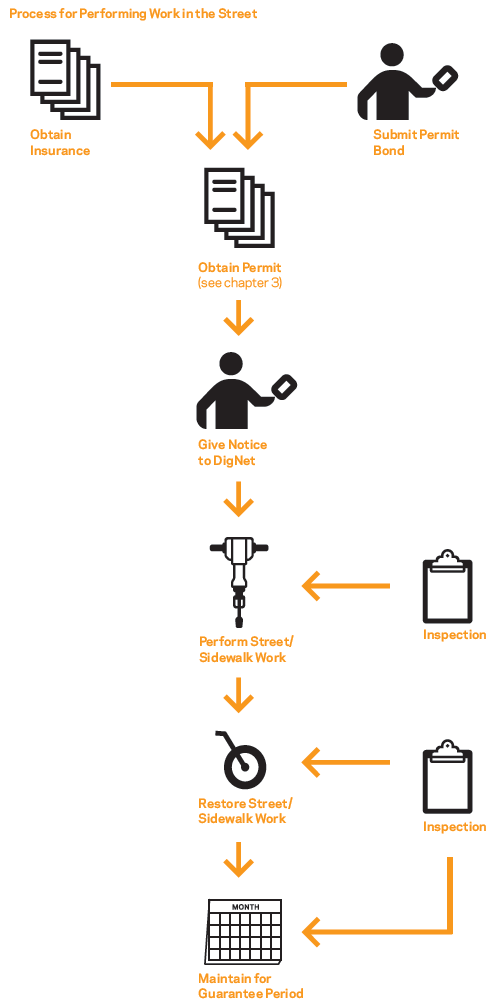
4.2 Street Excavation Requirements
Street excavations must be performed in accordance with Section 2-11 (e) of the Highway Rules
Some of the requirements include, but are not limited to the following, where the applicant must:
- Give notice to New York 811*. In accordance with New York State Industrial Code Rule No. 53 relating to construction, for excavation and demolition operations at or near underground facilities, permittees must contact New York 811 at least 48 hours
 prior to beginning any work. New York 811 may be reached by calling 1-800-272-4480 or 811.
prior to beginning any work. New York 811 may be reached by calling 1-800-272-4480 or 811. - Break the existing pavement using only hand-held tools (no "ram hoes" or truck-mounted tools), unless otherwise authorized.
- Assure that tools, debris, or other materials are not allowed to block water flow in gutters.
- Use timber, sheeting or bracing for any open excavation deeper than 5 feet.
- Not perform tunneling or jacking without a permit.
- Use full trenching for all sewer repair/connections.
- Limit traffic obstruction to one lane unless otherwise authorized by NYC DOT.
- Employ and display appropriate barricades, signs, lights, and other approved traffic control devices in accordance with the most recent version of the MUTCD, published by the Federal Highway Administration, and the New York State Supplement.
- Cover all unattended street openings/excavations with plates unless otherwise directed by NYC DOT.
- Follow all permit stipulations, such as the hours and/or days in which street operations and construction may take place, and removal of applied markings pursuant to a New York 811 notification at Special Treatment Project (STP) locations. Work on critical streets may be limited to nights, weekends, or off-peak periods; however, work outside of the weekday daytime period (7:00 AM to 6:00 PM) requires a noise variance from the NYC DOT Office of Construction Mitigation and Coordination (OCMC).
- Maintain at least 5 feet of unobstructed sidewalk for pedestrians at all times. Any work that narrows the sidewalk to less than 5 feet may require a temporary Sidewalk Closing Permit.
- Store construction materials in areas adjacent to the work site only as designated on the permit. Excavated material must either be removed from the site or stockpiled at a designated curb with proper barricading. Storage of construction-related equipment, excluding cranes, must follow any special stipulations on the permit. Storage of cranes, as noted in the Highway Rules, Section 2-05(j), requires an additional permit from NYC DOT.
4.2.1 New York 811, Inc.
New York 811 is a nonprofit organization that acts as a communications link between utility companies and individuals planning any digging activity in the five boroughs of New York City and Nassau and Suffolk Counties on Long Island. New York State law (Article 36 of General Business Law and 16 NYCRR Part 753, AKA Industrial Code 53) requires excavators to contact New York 811, via 811, 800-272-4480 or the internet, within 2 to 10 working days before performing any digging or excavation work. New York 811 then relays digging and excavation requests to its member network of utility companies and underground facility owners, who are required to mark the location of their underground facilities within two working days. Excavators use those markings to help identify underground facility locations ”in order to promote public safety and to prevent damage to public and private property.” (16 NYCRR Part 753)
Tips for Excavators
- Call before you dig. 811 or 800-272-4480.
- Wait the required time.
- Confirm utility response.
- Respect the marks.
- Dig with care.
Additional information can be obtained by contacting New York 811 at 800-272-4480, or visiting the New York 811 Website
Required Information for Call
- Name of caller
- Name, address and phone number of excavator
- Excavator’s field phone number
- Name of field contact person
- Address/location of work area
- Start date and time
- Means of digging and excavation
- Brief description of the planned digging and excavation
Marking Color Codes
When utility company representatives mark a location, they use colored flags and/or paint to identify the type of underground service:
| Red | Electric power lines, cables, conduit and lighting cables | |
| Yellow | Gas, oil, steam, petroleum and gaseous materials | |
| Orange | Communications, alarm, signal lines, cables and conduit | |
| Blue | Potable water | |
| Purple | Reclaimed water, irrigation and slurry lines | |
| Green | Sewers and drain lines | |
| Pink | Temporary survey markings | |
| White | Proposed excavation |
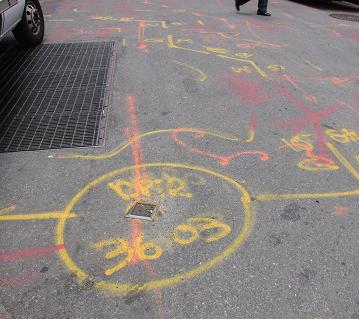
Streets can hide a complex infrastructure of underground utilities. One call to New York 811 provides for where gas (yellow), electric (red) and phone (orange) are located.
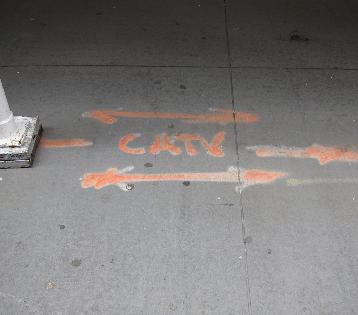
It is essential to call New York 811 before digging anywhere, including sidewalks and soil. This New York 811 marking shows where a cable television line is located beneath the sidewalk.
4.3 Street Restoration Requirements
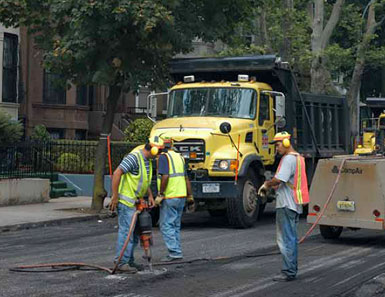
Street resurfacing in progress. NYC DOT's street reconstruction and resurfacing programs include nearly 6,000 miles of city streets.
Permanent Restoration—Upon completion of work in a street, permittees are required to restore all street openings/excavations in accordance with the Highway Rules, Section 2-11(e) including, but not limited to, the following required restoration elements:
- "Backfill" refers to the bottom layer of the restoration. All materials used for backfill must be free from bricks, blocks, excavated pavement materials and/or organic material or other debris.
- "Base course" refers to the layer of material below the wearing course. The concrete base must be restored at the same grade as the existing base; at no time may it be brought up to the asphalt course unless authorized by NYC DOT.
- Wearing course* refers to the top layer of pavement, which is designed to provide an even surface and withstand the wear of traffic. The wearing course material must conform to NYC DOT specifications, and the finished grade of the wearing course must be flush with the surrounding pavement on all sides of the cut. The restored wearing course must extend 6 inches beyond the edge of the base course.
Temporary Restoration—If street opening/excavation work remains unfinished at the end of the day, the permittee must perform temporary repairs in accordance with the Highway Rules, Section 2-11(e) including, but not limited to the following requirements:
- Immediately upon completing the compaction of the backfill of any street opening/excavation, a temporary pavement of an acceptable asphalt paving mixture not less than 4 inches thick after compaction must be installed flush with the adjacent surfaces; or
- If plating or decking will be used, the size of the plate or decking must extend a minimum of 12 inches beyond the edge of the trench*, be firmly placed to prevent rocking, and be sufficiently ramped, covering all edges of the steel plates to provide a smooth riding surface. All plating and decking must be made safe for vehicles, cyclists and/or pedestrians and be adequate to carry the load.
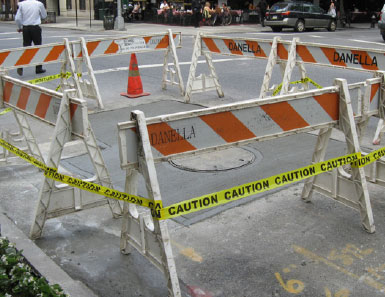
Street restoration following utility work, 18th Street and Irving Place, Manhattan.
Street Restoration Types
- Permanently Restored Opening / Excavation
- Temporary Repair: Plate
- Temporary Repair: Fill
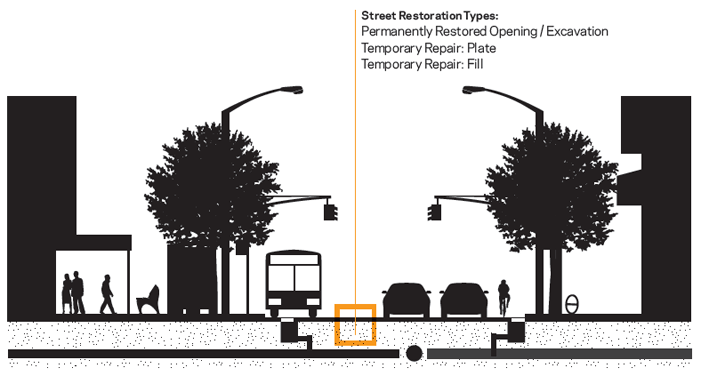
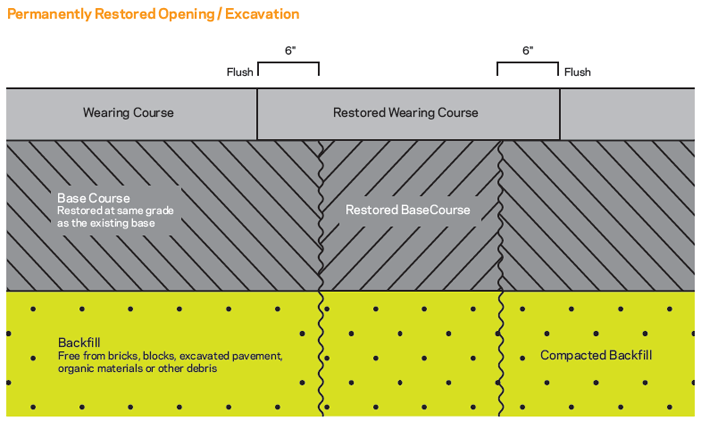
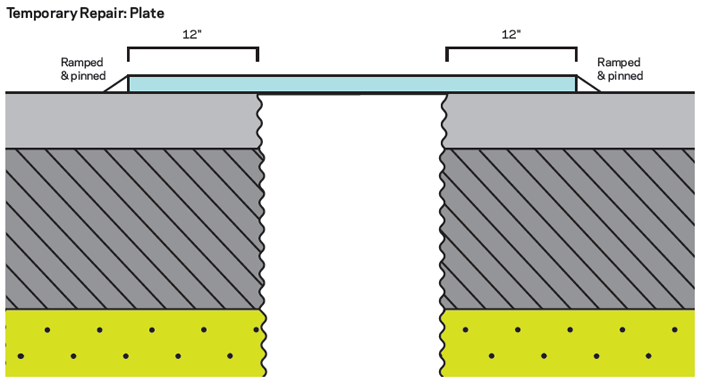
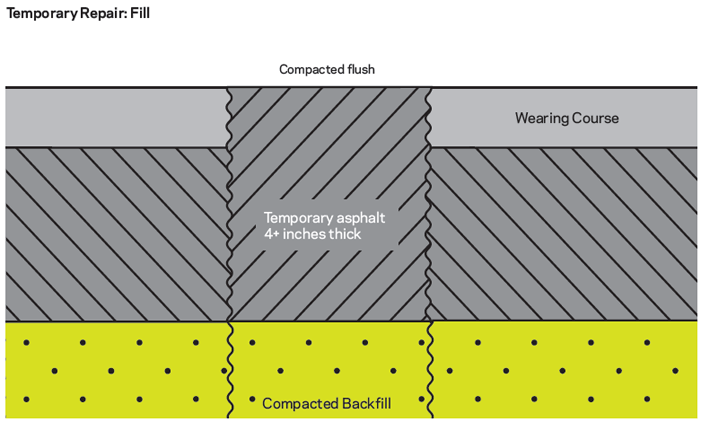
4.4 Sidewalk Repairs
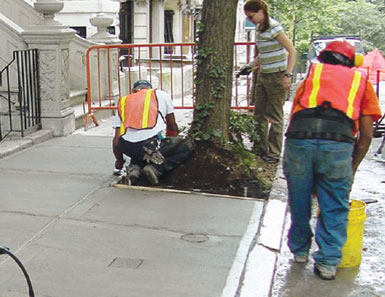
A temporary sidewalk closure while a sidewalk repair is underway.
Upon completion of work, sidewalks must be restored according to Highway Rules, Section 2-09(f)(4) and NYC DOT Standard Highway Specifications. Some of the requirements include but are not limited to:
Expansion Joints— Expansion joints must be placed at 20-foot intervals, expansion joint filler material must be placed to the full depth of the sidewalk, and all expansion joints must be recessed and sealed.
Concrete—must be poured and finished in accordance with NYC DOT Standard Highway Specifications.
Sidewalk flags—Must be 5'x 5' where feasibleAll flags containing substantial defects as defined in the Highway Rules must be replaced; patching of individual flags is not permitted.
Foundation Material—When replacing a concrete sidewalk, the foundation material may be retained and graded to the required subgrade. Any foundation material not meeting specifications must be removed.
Sidewalk Grades—Unless granted a waiver from NYC DOT, permanent sidewalks must be laid to the legal curb grades.
Transverse Slope—Sidewalks must be laid to pitch from the building line toward the curb. The minimum slope, calculated on a line perpendicular to the curb, must be 1" in 5', and the maximum is limited to 3" in 5'. Minimum slopes should be used wherever possible. The maximum transverse slope permitted for vault covers, gratings and other sidewalk structures is 1" in 5'.
Longitudinal Slope—The longitudinal slope of the sidewalk must be uniform and parallel to the curb at the curb's proper grade.
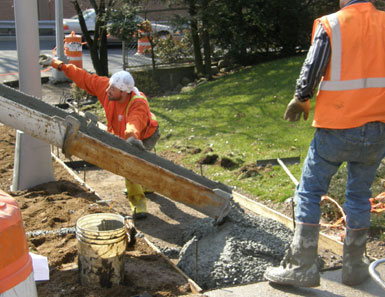
Workers pour cement during sidewalk reconstruction.
Corner Treatment—The two slope lines meeting at the intersection of the two building lines must drop from a common point at the building corner toward their respective curbs at a rate within the limits prescribed in the Highway Rules. If this is not possible, sketches or drawings must be submitted, in duplicate, showing the proposed method of treatment to NYC DOT for approval.
Pedestrian Ramps—When a corner is constructed, reconstructed or repaired, pedestrian ramps must be installed in accordance with NYC DOT Standard Highway Specifications found and in accordance with the most recent revision of Drawing H-1011 from the NYC DOT's Standard Details of Construction.
Adjoining Existing and New Sidewalks—Junctions and transitions between new and existing sidewalks must conform to specifications.
4.5 Street Construction Inspections and Enforcement
NYC DOT's HIQA unit inspects work sites for compliance with Title 19 of the NYC Administrative Code, NYC DOT Rules and Regulations, NYC DOT specifications and NYC DOT permit stipulations. HIQA performs inspections during active construction through its completion and up to the end of the Guarantee Period. HIQA may also inspect emergency street openings/excavations and utility access cover openings.
Upon inspection, HIQA may issue any of the following:
Corrective Action Requests (CARs) are issued to address conditions such as inadequate street restorations, missing or cracked street hardware or street cave-ins. Any corrective action required by the CAR must be performed within 30 days ![]() of the issuance of the CAR. For conditions that need immediate attention from the permittee, NYC DOT may issue Priority CARs [AKA Notices of Immediate Corrective Action (NICAs)]. Further information on responding to CARs may be found in the Highway Rules, Section 2-02(d).
of the issuance of the CAR. For conditions that need immediate attention from the permittee, NYC DOT may issue Priority CARs [AKA Notices of Immediate Corrective Action (NICAs)]. Further information on responding to CARs may be found in the Highway Rules, Section 2-02(d).
Notices of Violation (NOVs)/Summonses are issued when there is a violation of laws, rules, regulations, specifications, or stipulations. NOVs carry a monetary fine and place the matter under the jurisdiction of the New York City Environmental Control Board (ECB). Further information on responding to ECB violations may be found on the ECB website.
Orders, given orally or in writing, may be issued by the Commissioner to cease and desist work or to perform remedial action. Failure to comply with an order issued by the Commissioner may result in criminal or civil penalties. Further information on responding to Orders may be found in the Highway Rules, Section 2-02(e).
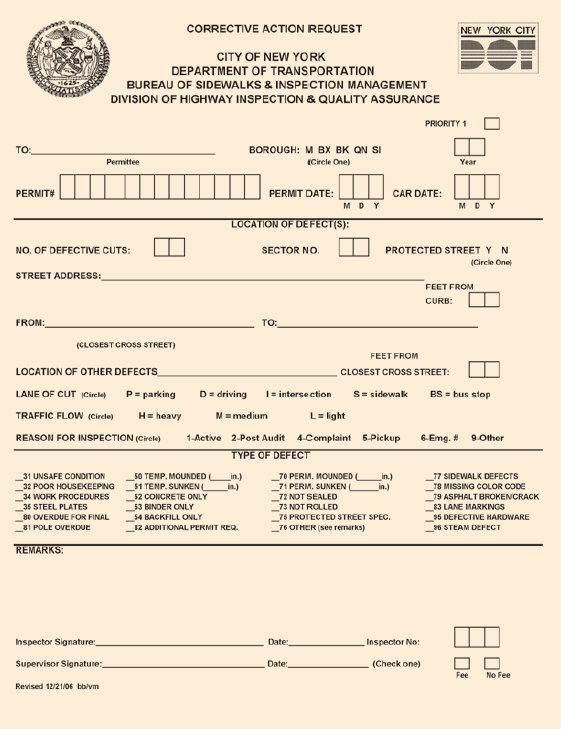
A sample Corrective Action Request Form
4.6 Sidewalk Violation Inspections and Enforcement
Private property owners are responsible for installing, repairing and maintaining sidewalks abutting their properties. NYC DOT inspects sidewalks for defects and when a defect is identified, a Sidewalk Violation is issued to the property owner and a copy is submitted to the County Clerk's office. There is no fine associated with a Sidewalk Violation. The violation provides a property owner 75 days ![]() to make repairs (see the Sidewalk Repairs section above for further details). If repairs have not been made within the 75 day period, the City may make the repairs and bill the property owner for the cost of the repairs.
to make repairs (see the Sidewalk Repairs section above for further details). If repairs have not been made within the 75 day period, the City may make the repairs and bill the property owner for the cost of the repairs.
Private homeowners applying for Sidewalk Repair Permits who will be making the repairs themselves may apply for permits by mail. If a contractor is being used, the contractor must be registered with NYC DOT and must take out the permit.
After repairs are complete, the property owner can contact 311 to schedule a Sidewalk Violation Dismissal. A dismissal inspection is always required to close out a violation. A Sidewalk Violation will be removed if the work has been satisfactorily completed. View more information on how to respond to Sidewalk Violations.
Appendices
Appendix A—Common Permit Types and Documents Needed
- Street Opening Permits
- Building Operations/Construction Activity Permits
- Sidewalk Construction Permits
- Canopy Permits
- Registration & Insurance
- Applications
- Miscellaneous Procedures
- Highway Rules
- Minimum Clearance Requirements For Transformer Vaults
Appendix C—NYC DOT Contact Information
- ASHO Borough Offices
- Borough Permit Offices
- HIQA Borough Offices
- Borough Commissioners
- Other NYC DOT Office Contacts
Appendix D—Other Agency and Utility Contact Information
- Department of Design and Construction, Construction Director Borough Offices
- Department of City Planning Borough Offices
- Department of Buildings Borough Offices
- Department of Parks and Recreation Borough Offices
- Environmental Control Board Borough Offices
- Other City and State Offices
- Utility Contacts
Appendix A—Common Permit Types and Documents Needed
Street Opening Permits
| Permit Type | Description | Fee | Maximum Duration (days) | Conditions | Necessary Documentation |
|---|---|---|---|---|---|
| 0100 | OPEN SWALK TO INSTALL FOUNDATION | $135 | 30/90 | REQUIRES DOB APPROVAL or REQUIRES DOT FRANCHISE | DOB PERMIT DOT FRANCHISE AGREEMENT |
| 0102 | MAJOR INSTALLATION – HIGH VOLTAGE | $135/380 | 30/90 | LIMITED TO CITY FRANCHISEE | N/A |
| 0103 | MAJOR INSTALLATION – GAS | $135/380 | 30/90 | LIMITED TO CITY FRANCHISEE | N/A |
| 0104 | MAJOR INSTALLATION – STEAM | $135/380 | 30/90 | LIMITED TO CITY FRANCHISEE | N/A |
| 0105 | MAJOR INSTALLATION – TELEPHONE | $135/380 | 30/90 | LIMITED TO CITY FRANCHISEE | N/A |
| 0106 | TRANSFORMER VAULT – ON RDWAY | $135/380 | 30 | LIMITED TO CITY FRANCHISEE | N/A |
| 0107 | TRANSFORMER VAULT - ON SIDEWALK | $135 | 30 | LIMITED TO CITY FRANCHISEE | N/A |
| 0108 | INSTALLATION OF POLES | $135 | 30 | REQUIRES DOT STREET LIGHTING APPROVAL | N/A |
| 0109 | MAJOR INSTALLATION - WATER | $135/380 | 30/90 | REQUIRES DEP APPROVAL | DEP WATER SLIP |
| 0110 | MAJOR INSTALLATION - CABLE | $135/380 | 30/90 | LIMITED TO CITY FRANCHISEE | DoITT FRANCHISE AGREEMENT (Initial Submission Only) |
| 0111 | MAJOR INSTALLATION - SEWER | $135/380 | 30/90 | REQUIRES DEP APPROVAL | DEP SEWER SLIP |
| 0113 | REPAIR WATER | $135/380 | 30 | REQUIRES DEP APPROVAL | DEP WATER SLIP |
| 0114 | REPAIR SEWER | $135/380 | 30 | REQUIRES DEP APPROVAL | DEP SEWER SLIP |
| 0115 | REPAIR WATER AND SEWER | $135/380 | 30 | REQUIRES DEP APPROVAL | DEP WATER AND SEWER SLIPS |
| 0116 | FUEL OIL LINE (SIDEWALK ONLY) | $135 | 30 | REQUIRES PROPERTY OWNER APPROVAL
REQUIRES FIRE DEPARTMENT APPROVAL |
LETTER FROM PROPERTY OWNER
LETTER FROM FIRE DEPARTMENT |
| 0117 | VAULT CONSTRUCTION OR ALTERATION | $135 | 30 | REQUIRES DOB APPROVAL
REQUIRES DOT APPROVAL |
DOB VAULT PERMIT
DOT APPROVED PLANS |
| 0118 | RESET, REPAIR OR REPLACE CURB | $135 | 30 | REQUIRES DOB APPROVAL or REQUIRES DOT APPROVAL |
DOB BUILDER'S PAVEMENT PLAN (BPP) AUTHORIZATION FORM
DOT APPROVED SCARA FORM |
| 0119 | PAVE STREET | $135 | 30 | REQUIRES DOB APPROVAL or REQUIRES DOT APPROVAL |
DOB BUILDER'S PAVEMENT PLAN (BPP) AUTHORIZATION FORM
DOT APPROVED SCARA FORM |
| 0120 | TREE PIT | $135 | 30 | REQUIRES DPR APPROVAL or REQUIRES DOB APPROVAL |
DPR PERMIT
DOB BUILDER'S PAVEMENT PLAN (BPP) AUTHORIZATION FORM |
| 0122 | REPAIR GAS | $135/380 | 30 | LIMITED TO CITY FRANCHISEE | N/A |
| 0123 | REPAIR STEAM | $135/380 | 30 | LIMITED TO CITY FRANCHISEE | N/A |
| 0124 | REPAIR ELECTRIC OR COMMUNICATIONS | $135/380 | 30 | LIMITED TO CITY FRANCHISEE | N/A |
| 0126 | TEST PITS OR CORES OR BORINGS | $135/380 | 30 | REQUIRES PROPERTY OWNER APPROVAL (Unless Government contract) |
LETTER FROM PROPERTY OWNER (Unless Government contract) ENGINEERING PLANS |
| 0127 | CONDUIT CONSTRUCTION (CABLE, TELECOMMUNICATION) AND FRANCHISE | $135/380 | 30 | REQUIRES CITY FRANCHISE or REQUIRES DOT FRANCHISE |
CITY FRANCHISE AGREEMENT
DOT FRANCHISE AGREEMENT |
| 0128 | ERECT CANOPY | $135 | 30 | REQUIRES DOT HIGHWAY INSPECTION QUALITY ASSURANCE (HIQA) APPROVAL | N/A |
| 0129 | INSTALL STREET FURNITURE | $135 | 30 | REQUIRES DOT FRANCHISE | DOT FRANCHISE AGREEMENT |
| 0130 | LAND FILL | $135 | 30 | PROPERTY OWNER APROVAL
REQUIRES DOT APPROVAL |
LETTER FROM PROPERTY OWNER |
| 0131 | PRIVATE SEWER | $135/380 | 30 | REQUIRES DOT FRANCHISE
REQUIRES DEP APPROVAL |
DOT FRANCHISE AGREEMENT
DEP APPROVED ENGINEERING PLANS |
| 0132 | INSTALL FENCE | $135 | 30 | REQUIRES DOB APPROVAL | DOB FENCE PERMIT |
| 0133 | INSTALL TRAFFIC SIGNALS | $135/380 | 30 | REQUIRES APPROVAL FROM DOT SIGNALS UNIT or
REQUIRES DOT CONTRACT |
DOT SIGNALS APPROVED PLANS
DOT NOTICE TO PROCEED (Initial submission only) |
| 0138 | INSTALLATION OF FIRE ALARM | $135 | 30 | REQUIRES FIRE DEPARTMENT CONTRACT | FDNY NOTICE TO PROCEED |
| 0139 | INSTALLATION OF BUS SHELTER | $135 | 30 | REQUIRES DOT FRANCHISE | DOT FRANCHISE AGREEMENT |
| 0151 | PUBLIC TELEPHONES | $135 | 30 | LIMITED TO CITY FRANCHISEE | DoITT FRANCHISE AGREEMENT (Initial submission only) ------- DoITT APPROVAL LETTER (Each Location) |
Building Operations/Construction Activity Permits
| Permit Type | Description | Fee | Maximum Duration (days) | Conditions | Necessary Documentation |
|---|---|---|---|---|---|
| 0201 | PLACE MATERIAL ON ST | $80-140 | 30-90 | REQUIRES DOB APPROVAL (IF IN CONJUNCTION WITH A NEW BUILDING OR BUILDING ALTERATION)
REQUIRES DOT APPROVAL |
DOB PERMIT
IN CONJUNCTION WITH OTHER DOT PERMITS |
| 0202 | CROSSING SIDEWALK | $50 | 30-90 | REQUIRES DOB APPROVAL (IF IN CONJUNCTION WITH A NEW BUILDING OR BUILDING ALTERATION)
REQUIRES DOT APPROVAL |
DOB PERMIT
IN CONJUNCTION WITH OTHER DOT PERMITS |
| 0203 | CRANE OR SHOVEL ON STREET | $150 1st week then $50 Per | 1 WK-12Wks | REQUIRES DOB APPROVAL
MAY ALSO REQUIRE DOT APPROVAL |
DOB CRANES AND DERRICKS FORM ---- DOB CRANE NOTICE (CN) (If Applicable) ---- ENGINEERING PLANS (If Applicable) DOT OVER-DIMENSIONAL PERMIT |
| 0204 | PLACE EQUIP. OTHER THAN CRANE OR SHOVEL | $50 PER | 30-90 | REQUIRES DOB APPROVAL (IF IN CONJUNCTION WITH A NEW BUILDING OR BUILDING ALTERATION)
REQUIRES DOT APPROVAL |
DOB PERMIT
IN CONJUNCTION WITH OTHER DOT PERMITS |
| 0205 | PLACE SHANTY OR TRAILER ON STREET | $50 PER | 30-90 | REQUIRES DOB APPROVAL | DOB PERMIT |
| 0207 | FRANCHISE INSTALLATION (OVERHEAD STRUCTURE) | $50 | 30-90 | REQUIRES DOT FRANCHISE | DOT FRANCHISE AGREEMENT |
| 0208 | TEMPORARY PEDESTRIAN WALK | $50 | 30-90 | REQUIRES DOB APPROVAL (IF IN CONJUNCTION WITH A NEW BUILDING OR BUILDING ALTERATION)
REQUIRES DOT APPROVAL |
DOB PERMIT
IN CONJUNCTION WITH OTHER DOT PERMITS |
| 0210 | DECORATIVE STREET LIGHTS | $50 | 30-90 | REQUIRES APPROVAL FROM DOT STREET LIGHTING UNIT | DOT STREET LIGHTING APPROVAL FORM |
| 0211 | OCCUPANCY OF ROADWAY AS STIPULATED | $50 | 30-90 | REQUIRES DOB APPROVAL (IF IN CONJUNCTION WITH A NEW BUILDING OR BUILDING ALTERATION)
REQUIRES DOT APPROVAL |
DOB PERMIT
IN CONJUNCTION WITH OTHER DOT PERMITS |
| 0214 | PLACE CONTAINER ON STREET | $50 PER | 30-90 | REQUIRES DOB APPROVAL (IF IN CONJUNCTION WITH A NEW BUILDING OR BUILDING ALTERATION)
REQUIRES DOT APPROVAL |
DOB PERMIT
IN CONJUNCTION WITH OTHER DOT PERMITS |
| 0215 | OCCUPANCY OF SIDEWALK AS STIPULATED | $50 | 30-90 | REQUIRES DOB APPROVAL (IF IN CONJUNCTION WITH A NEW BUILDING OR BUILDING ALTERATION)
REQUIRES DOT APPROVAL |
DOB PERMIT
IN CONJUNCTION WITH OTHER DOT PERMITS |
| 0221 | SIGNS & PAVEMENT MARKINGS | $50 | 30-90 | REQUIRES DOT APPROVAL | DOT APPROVED ENGINEERING PLANS |
Sidewalk Construction Permits
| Permit Type | Description | Fee | Maximum Duration (days) | Conditions | Necessary Documentation |
|---|---|---|---|---|---|
| 0401 | REPAIR SIDEWALK | $70 PER 300 LF | 30 | N/A | PLAN OR SKETCH |
| 0402 | CONSTRUCT NEW SIDEWALK | $70 PER 300 LF | 30 | REQUIRES DOT APPROVAL | DOT APPROVED SCARA FORM |
| 0403 | REPLACE SIDEWALK | $70 PER 300 LF | 30 | REQUIRES DOT APPROVAL | DOT APPROVED SCARA FORM |
| 0405 | NEW SIDEWALK , BUILDERS PAVEMENT (BPP) | $70 PER 300 LF | 30 | REQUIRES DOB APPROVAL | DOB BUILDER'S PAVEMENT PLAN (BPP) AUTHORIZATION FORM |
| 0500 | VAULT LICENSE | $35 | 1 TIME | DOT FRANCHISE APPROVAL | DOT AND DOB APPROVED PLANS |
Canopy Permits
| Permit Type | Description | Fee | Maximum Duration (days) | Conditions | Necessary Documentation |
|---|---|---|---|---|---|
| 0701 | HOTEL CANOPY | $50 | 1 YEAR | REQUIRES DOT HIGHWAY INSPECTION QUALITY ASSURANCE (HIQA) APPROVAL | N/A |
| 0702 | RESTAURANT | $50 | 1 YEAR | REQUIRES DOT HIGHWAY INSPECTION QUALITY ASSURANCE (HIQA) APPROVAL | N/A |
| 0703 | RESIDENCE | $50 | 1 YEAR | REQUIRES DOT HIGHWAY INSPECTION QUALITY ASSURANCE (HIQA) APPROVAL | N/A |
| 0704 | MISCELLANEOUS | $50 | 1 YEAR | REQUIRES DOT HIGHWAY INSPECTION QUALITY ASSURANCE (HIQA) APPROVAL | N/A |
| 0705 | SIDEWALK CAFE | $25 | 1 YEAR | REQUIRES DOT HIGHWAY INSPECTION QUALITY ASSURANCE (HIQA) APPROVAL | N/A |
Appendix B—Forms
Please contact NYC DOT if you need accessibility assistance with these forms
Filing Plans and Guidelines for the Design of Sidewalks, Curbs, Roadways and Other Infrastructure Components
Registration & Insurance
- Certification by Broker
- Certificate of Insurance
- Additional Insured Endorsements
- Permittee Registration Application
- Permit Bond Templates
Street Work Applications
- Emergency Authorization Number Form
- Application for Roadway/Sidewalk Permits
- Application for Full Roadway Closure
- Full Roadway Closure
- Emergency Street Opening Permit Form
- Street Arterial Maintenance (SAM) Release Form for Protected Streets
- Application to Renew Permits
- Application to Reissue Permit(s)
- Application for Governmental Work Permit(s)
- Application to Renew Governmental Work Permit(s)
- Application to Reissue Governmental Work Permit(s)
- Application for Canopy Authorization
- Written Consent from Property Owner to install and maintain a canopy
Miscellaneous Procedures
- Affidavit of Ownership (Homeowner)
- Statement of Construction Details
- Debris Container Permit Form
- Parking Meter Maintenance Requisition
- Request for Purchase of Temporary Construction Signs
- Construction Project Information Signs (CPIS) Directions
- Request for Permit for Record Purposes
- Engineering Package for Vault Application
- New Building Major Alteration Procedures
Highway Rules
Minimum Clearance Requirements For Transformer Vaults
| Item | Obstruction Type | Clearance | Agency | Contact |
|---|---|---|---|---|
| 1 | Bench | 5 ft | DOT | Franchises, Concessions and Consents - (212) 839-6550 |
| 2 | Bicycle Rack | 5 ft | DOT | Bicycle group - (212) 839-7240 |
| 3 | Bus Stop Sign | 5 ft | DOT | Borough Engineering - see Appendix C for borough office |
| 4 | Bus Zone | Not Permitted | MTA | MTA/NYCT - Bus Operations - (646) 252-5517 or (646) 252-5544 |
| 5 | Canopy | 3 ft | DOT | HIQA - see Appendix C for borough office |
| 6 | Cellar Door/Hatch Door | Prefer 3 ft along the same line | DOT | Plan Examination Unit |
| 7 | Corner Quadrant | 5 ft | DOT | Plan Examination Unit |
| 8 | Curb Cut | 3 ft | DOT | Plan Examination Unit |
| 9 | Curb Offset | 18 inches (maximum 24 inches) from the grating edge perpendicular to curb | DOT | Plan Examination Unit |
| 10 | Driveways | 3ft out of driveway cut | DOT | Plan Examination Unit |
| 11 | All Entrances | 3 ft each side | DOT | Plan Examination Unit |
| 12 | Fire Hydrant | 5 ft | DEP | Division of Review & Construction Compliance - (718) 595-5223 or Plan Review Section - (718) 595-5191 |
| 13 | Areaway, Grating, Opening | * Maintain minimum Clear Path requirement (Below) | DOT | Plan Examination Unit |
| 14 | Mailbox | 3 ft | USPS | General customer service - (800) ASK-USPS |
| 15 | Newsstands | 5 feet offset along the curb line (Not Permitted in front) | DOT | Department of Consumer Affairs - 311 or (212) NEW-YORK outside the five boroughs |
| 16 | Parking Meter | 3 ft | DOT | Parking Engineering - (718) 786-6984 |
| 17 | Sign Posts | 3 ft | DOT | Borough Engineering - see Appendix C for borough office |
| 18 | Standpipe | 3 ft | NYFD | (718) 999-2457 |
| 19 | Street Light | 3 ft | DOT | Street Lighting - (718) 786-2788 |
| 20 | Telephone Booth | 5 ft | Owner | |
| 21 | Tree Pit | 7 ft (prefer 10 ft) | DPR | Department of Parks - see Appendix C for borough office |
| 22 | Utility Access Cover | 3 ft | Utility | Con Ed, Verizon, National Grid, etc. - see Appendix D for contact info |
| 23 | Utility Pole | 3 ft | Utility | Con Ed, Verizon, National Grid, etc. - see Appendix D for contact info |
| 24 | Water Line | 3 ft | DEP | See #12 above |
| 25 | Landscaped Grass Strip | Not Permitted | Plan Examination Unit |
* Clear Path (pedestrian walkway): This directive is intended to provide pedestrians with the maximum amount of safety and space to traverse the sidewalk. This requires a minimum distance on narrow sidewalks (10-12 feet Secondary Streets) of 5 ft., or a minimum distance on wide sidewalks (Larger than 12 feet Main Streets) of 8 ft. DOT's preference is that there is no split in Pedestrian Flow.
Note: All distances indicate measurements from nearest edge of any object to closest edge of vault.
Plan Examination Unit
Bureau of Permit Management and Construction Control
New York City Department of Transportation
55 Water Street, New York, NY 10041
(212) 839-9666
nyc.gov/dot
Appendix C—NYC DOT Contact Information
Administrative Superintendent of Highway Operations (ASHO) Offices
The ASHO in each borough releases Capital Project In-House (CPI) holds and Street Arterial Maintenance (SAM) holds. See Section 3.5.1 Holds for more information.
The Bronx
1400 Williamsbridge Road, 2nd Floor
Bronx, NY 10461
(212) 748-6670
Office hours: 8:30 AM-4:30 PM
Brooklyn
16 Court Street, 16th floor
Brooklyn, NY 11211
(718) 222-7307
Office hours: 8:30 AM-4:30 PM
Manhattan
59 Maiden Lane, 37th floor
New York, NY 10038
(212) 839-8980
Office hours: 8:30 AM-4:30 PM
Queens
120-55 Queens Boulevard, 2nd floor
Kew Gardens, NY 11424
(212) 839-2480
Office hours: 8:30 AM-4:30 PM
Staten Island
10 Richmond Terrace, Room 309
Staten Island, NY 10301
(212) 839-2399
Office hours: 8:30 AM-4:30 PM
Permit Offices
Applications for most permit types can be submitted to the Manhattan Central Permit Office. Some permit types can also be processed at the relevant borough office. See Chapter 3—Permits and Approvals for more information.
The Bronx
Effective 8/5/19 – Closed until Further Notice
Brooklyn
16 Court Street, 15th floor
Brooklyn, NY 11211
By Appointment only, call (646) 892-1388/1389
Office hours: Open Wednesdays only - 8:30 AM-3:30 PM
Manhattan / Central Permit Office
55 Water Street, Concourse Level
New York, NY 10041
Call for appointment (212) 839-9570/9595
Office hours: Monday-Friday 8:30AM-3:30PM, walk-ins welcome
Queens
120-55 Queens Boulevard, 1st floor, Room 1-240
Kew Gardens, NY 11424
By Appointment only, call (212) 839-2473
Office hours: Open Tuesday & Wednesday only 8:30 AM-3:30 PM
Staten Island
10 Richmond Terrace, Room 308
Staten Island, NY 10301
By Appointment only, call (212) 839-2387
Office hours: Open Wednesdays only 8:30 AM-3:30 PM
Highway Inspection and Quality Assurance (HIQA) Offices
To request authorization for the installation of a canopy, an applicant must initiate the process at the HIQA office in the borough where the proposed canopy will be located. See Section 3.4 Canopy Authorization and Permits for more information.
HIQA also releases many holds. See Section 3.5.1 Holds for more information.
HIQA Central Office
(212) 839-8847
(212) 839-8857
(212) 839-8856
The Bronx
1400 Williamsbridge Road, 1st floor
Bronx, NY 10461
For Holds: (212) 748-6609
All other inquiries: (212) 748-6610
Office hours: 8:30 AM-5:00 PM
Brooklyn
16 Court Street, 15th floor
Brooklyn, NY 11211
For Holds: (718) 222-7231
All other inquiries: (718) 222-7207
Office hours: 8:30 AM-5:00 PM
Manhattan
59 Maiden Lane, 34th Floor
New York, NY 10038
(212) 839-4700
Office hours: 8:30 AM-5:00 PM
Queens
120-55 Queens Boulevard, Ground Floor, Room G-210
Kew Gardens, NY 11424
(212) 839-2430
Office hours: 8:30 AM-3:30 PM (in person)
Telephone inquiries: 8:30 AM-4:30 PM
Staten Island
10 Richmond Terrace, Room 427
Staten Island, NY 10301
(212) 839-2410
Office hours: 8:30 AM to 5:00 PM
Other NYC DOT Office Contacts
| Street Lighting | (718) 786-2788 |
| Franchises, Concessions and Revocable Consents | (212) 839-6550 |
| Plan Examination Unit | (212) 839-9666 |
| Bridges (for Over Dimensional Vehicle permit) | (212) 839-6335 |
| Fiscal Affairs: Revenue & Accts Receivable | (212) 839-9270 |
Emergency Authorization Unit
To obtain forms:
From 7:00 AM to 3:30 PM, Monday to Friday, call: (212) 839-9660/61/62
All other times - (718) 433-3340
To fax forms:
From 7:00 AM to 3:30 PM, Monday to Friday: (212) 839-9697/99 or 9688
All other times: (718) 433-3447
Appendix D—Other Agency and Utility Contact Information
Department of Design and Construction (DDC)
Construction Director Borough Offices
The Bronx and North Queens (north of the Long Island Expressway)
30-30 Thomson Avenue, 4th Floor
Long Island City, NY 11101
(718) 391-1008
8:30 AM to 4:30 PM
South Queens (south of the LIE)
30-30 Thomson Avenue, 4th Floor
Long Island City, NY 11101
(718) 391-1958
8:30 AM to 4:30 PM
Brooklyn
30-30 Thomson Avenue, 4th Floor
Long Island City, NY 11101
(718) 391-1937
8:30 AM to 4:30 PM
Lower Manhattan (south of Canal Street)
40 Worth Street 8th Floor
New York, NY 10013
(212) 442-1890
8:30 AM to 4:30 PM
Manhattan
40 Worth Street 8th Floor
New York, NY 10013
(212) 442-7962
8:30 AM to 4:30 PM
Staten Island
30-30 Thomson Avenue, 4th Floor
Long Island City, NY 11101
(718) 391-1110
Office hours: 8:30 AM - 4:30 PM
Department of City Planning (DCP)
Borough Offices
The Bronx
One Fordham Plaza, 5th Fl.
Bronx, NY 10458-5891
Tel: 718-220-8500
Fax: 718-584-8628
Brooklyn
16 Court Street, 7th Fl.
Brooklyn, NY 11241-0103
Tel: 718-780-8280
Fax: 718-596-2609
Central Office
22 Reade Street
New York, NY 10007-1216
Tel: 212-720-3300
Fax: 212-720-3219
Manhattan
22 Reade Street, 6th Fl. West
New York, NY 10007-1216
Tel: 212-720-3480
Fax: 212-720-3488
Queens
120-55 Queens Blvd., Room 201
Kew Gardens, NY 11424
Tel: 718-286-3170
Fax: 718-286-3183
Staten Island
130 Stuyvesant Place, 6th Fl.
Staten Island NY 10301
Tel: 718-556-7240
Fax: 718-556-7305
Department of Buildings (DOB)
Borough Offices
The Bronx
1932 Arthur Avenue, 5th Floor
Bronx, NY 10457
Customer Service: (718) 579-6920
Brooklyn
210 Joralemon Street, 8th Floor
Brooklyn, NY 11202
Customer Service: (718) 802-3675
Manhattan
280 Broadway, 3rd Floor
New York, NY 10007
Customer Service: (212) 566-0042
Queens
120-55 Queens Boulevard
Kew Gardens, NY 11424
Customer Service: (718) 286-0600
Staten Island
10 Richmond Terrace
Borough Hall, 2nd Floor
Staten Island, NY 10301
Customer Service: (718) 816-2300
Department of Parks and Recreation (DPR)
Borough Offices
The Bronx
NYC Parks & Recreation
Attn: Forestry
1 Bronx River Parkway
Bronx, NY 10462
Bronx.Forestry@parks.nyc.gov
Fax: (718) 430-4663
Tel: (718) 430-1877
Brooklyn
NYC Parks & Recreation
Attn: Forestry
95 Prospect Park West
Brooklyn, NY 11215
Brooklyn.Forestry@parks.nyc.gov
Fax: (718) 965-7753
Tel: (718) 965-7750
Manhattan
NYC Parks & Recreation
Attn: Forestry
24 West 61st St., 5th Fl.
New York, NY 10023
Manhattan.Forestry@parks.nyc.gov
Fax: (212) 860-1359
Tel: (212) 860-1845
Queens
NYC Parks & Recreation
Attn: Forestry
80-30 Park Lane
Kew Gardens, NY 11415
Queens.Forestry@parks.nyc.gov
Fax: (718) 699-7491
Tel: (718) 699-4700
Staten Island
NYC Parks & Recreation
Attn: Forestry
1150 Clove Rd.
Staten Island, NY 10301
StatenIsland.Forestry@parks.nyc.gov
Fax: (718) 816-9194
Tel: (718) 390-2080
Environmental Control Board (ECB)
Borough Offices
The Bronx
3030 Third Avenue
Bronx, NY 10455
Tel: (718) 993-6110
Fax: (718) 993-3077
For hearings, Monday to Friday from 8:30 AM to 3:30 PM.
For questions, Monday to Friday from 8:30 AM until 5:00 PM.
Brooklyn
233 Schermerhorn Street, 11th Floor
Brooklyn, NY 11201
Tel: (718) 875-7428
Fax: (718) 858-0069
For hearings, Monday to Friday from 8:30 AM to 3:30 PM.
For questions, Monday to Friday from 8:30 AM until 5:00 PM.
Manhattan
66 John Street, 10th Floor
New York, NY 10038
Tel: (212) 361-1400
Fax: (212) 361-1900
For hearings, Monday to Friday from 8:30 AM to 3:30 PM.
For questions, Monday to Friday from 8:30 AM until 5:00 PM.
Queens
144-06 94th Avenue, Main Floor
Jamaica, NY 11435
Tel: (718) 298-7300
Fax: (718) 298-7075
For hearings, Monday to Friday from 8:30 AM to 3:30 PM.
For questions, Monday to Friday from 8:30 AM until 5:00 PM.
Staten Island (part-time office)
350 St. Marks Place, Main Floor
Staten Island, NY 10301
Tel: (718) 815-8541 on hearing days
Fax: (718) 815-8391
For hearings, 1st, 2nd, 3rd, and 4th Wednesdays and Thursdays of the month from 8:30 AM to 3:30 PM
For questions, Mon-Fri 8:30 AM until 5:00 PM.
Other City and State Offices
New York City Department of Consumer Affairs (DCA)
42 Broadway
New York, NY 10004
311 (or 212-NEW-YORK outside the City)
Office Hours: Monday–Friday from 9:00 AM to 5:00 PM
New York City Department of Environmental Protection (DEP)
Division of Review & Construction Compliance (718) 595-5223 or
Chief Plan Review Section, DEP/BWSO (718) 595-5191
New York City Fire Department (FDNY)
Permits (hazardous storage/operations) – (718) 999-2457
New York City Department of Information Technology and Telecommunications (DoITT)
75 Park Place, 9th Floor
New York, NY 10007
Tel: (212) 788-6600
New York City Landmarks Preservation Commission (LPC)
Municipal Building
1 Centre Street, 9th Floor
New York, NY 10007
Tel: (212) 669-7817
Fax: (212) 669-3844
New York City Office of Emergency Management (OEM)
165 Cadman Plaza East
Brooklyn, NY 11201
Tel: 311 or (718) 422-8700
Public Design Commission of the City of New York (PDC)
City Hall, 3rd Floor
New York, NY 10007
Tel: (212) 788-3071
Fax: (212) 788-3086
New York State Department of Environmental Conservation (DEC)
47-40 21st Street - 7th Floor
Long Island City, NY 11101
Tel: (718) 482-4516
Visit the DEC website at the following address to determine the appropriate contact http://www.dec.ny.gov/63.html
Metropolitan Transportation Authority (MTA) – Bus Operations
Tel: (646) 252-5517 or (646) 252-5544
New York State Department of Transportation (NYSDOT)
Hunters Point Plaza
47-40 21st Street
Long Island City, NY 11101
Tel: (718) 482-4825
Utility Contacts
| Con Edison | (800) 752-6633 |
| National Grid | (718) 643-4050 |
| Time Warner | (212) 484-8000 |
| Verizon | (212) 757-9940 |
Appendix E—Links
Chapter 1—Introduction
Chapter 2—Advance Notice and Coordination of Planned Street Work
Section 2.2 NYC DOT's Capital Project Map Portal and Other Online Information
- DOTMap
- Guide to using NYCityMap and DOTMap
- Weekly milling, resurfacing and concrete repair schedules
- NYC DOT Construction Embargo List
Section 2.3 Key Principles for Effective Notice and Coordination of Major Planned Street Work
Chapter 3—Permits and Approvals
Section 3.2 The Permitee Registration Process
3.2.1 Required Documentation for a Permittee Registration Application
- Permittee Registration Application
- Highway Rules
- Insurance and Indemnification Requirements from Title 34, Rules of the City of New York
- Certification by Broker form
- Certificate of Insurance form
- Instructions for Permittee Registration Application
Section 3.3: The Permit Application Process (Non-Emergency Work)
- Roadway/Sidewalk Permit Application
- Critical Streets list in the Highway Rules, Section 2-07 (c) (5)
3.3.1 Common Requirements for All Permit Types
- Roadway/Sidewalk Permit Application
- Application for Governmental Work Permit
- Request for Full Roadway Closure
- Franchise, Concession or Revocable Consent
3.3.2 Application Procedures for a Street Opening Permit
3.3.3 Application Procedures for a Building Operations/Construction Activity Permit
3.3.4 Application Procedures for a Sidewalk Construction Permit
3.3.5 Permit Application Review and Issuance (for Street Opening, Building Operations/Construction Activity, and Sidewalk Construction Permits)
3.3.6 Permit Renewals and Re-Issuances (for Street Opening, Building Operations/Construction Activity, and Sidewalk Construction Permits)
- Application to Renew Permits
- Application to Renew Government Permits
- Application to Re-Issue Permits
- Application to Re-issue Government Permits
Section 3.4: Canopy Authorization and Permits
3.4.1 Application Procedure for Canopy Authorizations and Permits
- NYC DOT Standard Details of Construction
- Work that Requires LPC Approval
- Additional information about historic districts
Section 3.5: Other Provisions Pertaining to Permits
3.5.1 Holds
3.5.3 Other Actions
Section 3.6: Emergency Work and Special Circumstances
3.6.1 Emergency Utility Access Cover Openings and Emergency Street Openings
3.6.2 Embargoes
- Construction Embargos at the Special Traffic Advisory link
- Request for Roadway/Sidewalk Permits during Embargo Periods
Section 3.7: Vault Approvals
3.7.3 Vaults Requiring a Revocable Consent
Chapter 4—Executing Work in the Street
Section 4.1: General Requirements For Executing Work
Section 4.2: Street Opening/Excavation Requirements
4.2.1 New York 811, Inc.
Section 4.4: Sidewalk Repairs
Section 4.5: Street Construction Inspections and Enforcement
Section 4.6: Sidewalk Violation Inspections and Enforcement
Appendix F—Permit Stipulations
NOTE: This list of permit stipulations is provided as a reference tool, for informational purposes only. The stipulation text on a NYC DOT permit is the official text, with which a permittee must comply.
| Stipulation | Description |
|---|---|
| 000 | UTILITY COVER EMBARGO 0600-2000 WEEKDAYS |
| 001 | UTILITY COVER EMBARGO 1600-2000 WEEKDAYS |
| 002 | UTILITY COVER EMBARGO 0700-1900 WEEKDAYS |
| 003 | UTILITY COVER EMBARGO 0700-1000 1600-2000 WEEKDAYS |
| 004 | UTILITY COVER EMBARGO 0700-1000 1600-1900 WEEKDAYS |
| 005 | UTILITY COVER EMBARGO 0700-2000 WEEKDAYS |
| 006 | UTILITY COVER EMBARGO 1600-1900 WEEKDAYS |
| 007 | UTILITY COVER EMBARGO 0700-1000 WEEKDAYS |
| 008 | UTILITY COVER EMBARGO/HOLIDAY EMBARGO 0600-2400 WEEKDAYS/WEEKENDS |
| 009 | THE ROADWAY AND/OR SIDEWALK SHALL BE REPLACED IN-KIND. |
| 010 | THIS PERMIT MAY BE EXTENDED ONCE ONLY, FOR A PERIOD OF 14 DAYS AT $40. HOWEVER IT MUST BE PRESENTED FOR EXTENSION NO LATER THAN 5 BUS DAYS PRIOR TO EXPIRING. |
| 011 | POST SIGNS MEETING NYCDOT SPECIFICATIONS FOR DIRECTING PEDESTRIANS TO OPPOSITE SIDEWALK. SIGNS MUST BE POSTED AT WORK ZONES AS WELL AS BOTH INTERSECTIONS OF AFFECTED SIDEWALK. |
| 012 | FLAG PERSON MUST BE PROVIDED TO STOP PEDESTRIAN AND/OR VEHICLE TRAFFIC WHILE LIFTING MATERIALS OVERHEAD AND ALSO WHEN CROSSING SIDEWALK IN CONJUCTION WITH CROSSING SIDEWALK PERMITS. |
| 013 | MAINTAIN MINIMUM 5 FOOT CLEAR SIDEWALK |
| 014 | MAINTAIN A 5 FOOT CLEAR PEDESTRIAN WALKWAY IN ROADWAY. WALKWAY MUST MEET NYCDOT SPECIFICATIONS. WALKWAY MUST BE RAMPED AT ENTRY TO SIDEWALK FOR HANDICAPPED ACCESSIBILITY. |
| 015 | MAINTAIN 8 FOOT CLEAR PEDESTRIAN WALKWAY ON SIDEWALK. |
| 016 | FULL WIDTH OF SIDEWALK SHALL BE OPENED TO PEDESTRIANS WHEN SITE IS UNATTENDED EXCEPT FOR CONCRETE CURING WHEN THAT PORTION OF THE SIDEWALK MAY REMAIN CLOSED PROVIDED ALL OTHER STIPULATIONS ON THIS PERMIT ARE COMPLIED WITH. THIS EXECPTION DOES NOT APPLY IF STIPULATION 014 IS ALSO APPLIED TO THIS PERMIT. |
| 017 | CONTRACTORS SHALL NOTIFY POLICE, FIRE, EMS, COMMUNITY BOARDS, AND ABUTTING PROPERTY OWNERS 48 HOURS PRIOR TO CONSTRUCTION |
| 018 | NO NOISY OPERATIONS MAY OCCUR AFTER 10:00 PM. |
| 019 | WORK 7 AM - 6 PM, MONDAY THROUGH FRIDAY |
| 020 | RESTORE ALL TRAVEL LANES TO TRAFFIC. CONTRACTOR MAY CONTAIN A MAXIMUM OF 25 LINEAR FEET, 8 FEET ADJACENT TO THE CURB DURING NON-WORK HOURS. CONTAINMENT ONLY TO RESTRICT PARKING AND FOR STORAGE OF EXCAVATED MATERIAL/FILL. USE OF METERED,AUTHORIZED PARKING AND NO STANDING ZONES IS PROHIBITED. |
| 021 | MAINTAIN ONE 12 FOOT LANE FOR LOCAL AND EMERGENCY ACCESS AT ALL TIMES |
| 022 | PLACE BARRICADES AND POST SIGNS MEETING "FEDERAL MANUAL OF UNIFORM TRAFFIC CONTROL DEVICES (MUTCD)" STANDARDS STATING "ROAD CLOSED TO THROUGH TRAFFIC" |
| 023 | MAINTAIN ONE 11 FOOT LANE FOR TRAFFIC |
| 024 | MAINTAIN TWO 11 FOOT LANES FOR TRAFFIC |
| 025 | MAINTAIN THREE 11 FOOT LANES FOR TRAFFIC |
| 026 | MAINTAIN FOUR 11 FOOT LANES FOR TRAFFIC |
| 027 | MAINTAIN 2 LANES FOR TRAFFIC, 1 LANE IN EACH DIRECTION |
| 028 | MAINTAIN 4 LANES FOR TRAFFIC, 2 LANES IN EACH DIRECTION |
| 029 | COORDINATE CONSTRUCTION ACTIVITY WITH THEATRE GROUPS PRIOR TO WORK. |
| 030 | OCCUPY A MAXIMUM OF 12 FT OF ROADWAY FOR ASBESTOS REMOVAL ONLY BETWEEN THE HOURS OF 7PM - 6AM |
| 031 | MAINTAIN TWO 11 FOOT LANES, ONE 11 FOOT LANE ON EACH SIDE OF THE EXISTING DOUBLE YELLOW CENTER LINE |
| 032 | MAINTAIN FOUR 11 FOOT LANES, TWO 11 FOOT LANES ON EACH SIDE OF THE EXISTING DOUBLE YELLOW CENTER LINE |
| 033 | MAINTAIN TWO 11 FOOT LANES, ONE 11 FOOT LANE ON EACH SIDE OF THE EXISTING CENTER MALL |
| 034 | MAINTAIN FOUR 11 FOOT LANES, TWO 11 FOOT LANES ON EACH SIDE OF THE EXISTING CENTER MALL. |
| 035 | MAINTAIN 1 - 11 FOOT LANE FOR 2 WAY THRU TRAFFIC W/FLAGGERS AT EACH END OF WORK ZONE. |
| 036 | NO WORK MAY EXTEND MORE THAN 8 FEET FROM CURB WITHOUT EXPLICIT AUTHORIZATION OF MTCCC. |
| 037 | SECTION 24-224 ADMINISTRATIVE CODE VARIANCE GRANTED FOR HOURS AND DAYS STIPULATED HEREIN |
| 038 | ALL TEMPORARY TRAFFIC CONTROL DEVICES, INCLUDING BUT NOT LIMITED TO SIGNS, CHANNELIZING DEVICES, FENCING AND MARKINGS SHALL BE PROVIDED, INSTALLED, MAINTAINED AND REMOVED BY THE PERMITTEE IN ACCORDANCE WITH THE MOST RECENT VERSION OF PART 6 OF THE MANUAL ON UNIFORM TRAFFIC CONTROL DEVICES FOR STREETS AND HIGHWAYS (MUTCD). OBTAIN THE MUTCD AT HTTP://MUTCD.FHWA.DOT.GOV |
| 039 | OCCUPY 8 FOOT WIDTH OF ROADWAY ADJACENT TO CURB |
| 040 | OCCUPY 12 FOOT WIDTH OF ROADWAY; FULL WIDTH OF ROADWAY RESTORED TO TRAFFIC WHEN SITE IS UNATTENDED. |
| 041 | OCCUPY ONE 11 FOOT LANE |
| 042 | OCCUPY TWO 11 FOOT LANES |
| 043 | OCCUPY THREE 11 FOOT LANES |
| 044 | OCCUPY FOUR 11 FOOT LANES |
| 045 | OCCUPY 12 FOOT WIDTH OF ROADWAY. RESTORE ALL TRAVEL LANES WHEN SITE IS UNATTENDED CONTRACTOR MAY CONTAIN A MAXIMUM OF 25 LINEAR FEET, 8 FEET ADJACENT TO THE CURB DURING NON-WORK HOURS. CONTAINMENT ONLY TO RESRTICT PARKING AND FOR STORAGE OF EXCAVATED MATERIAL/FILL. USE OF METERED, AUTHORIZED PARKING AND NO STANDING ZONES IS PROHIBITED.td> |
| 046 | WORK MAY OCCUR FOR MSO ONLY FROM 7PM FRIDAY TO 6:00AM MONDAY, 24 HRS A DAY. WITHIN THIS TIME FRAME ONE WAY ROADWAYS LESS THAN 39FT. MAY BE INTERMITTENTLY CLOSED TO THROUGH TRAFFIC WITH THE USE OF FLAGGERS WHILE PROVIDING LOCAL ACCESS AT ALL TIMES FOR A MAXIMUM OF 90 MINS. BETWEEN THE HOURS OF 12:01AM AND 6:00AM. |
| 047 | OCCUPY 8 FOOT WIDTH OF ROADWAY ADJACENT TO NORTH CURB LINE |
| 048 | OCCUPY 8 FOOT WIDTH OF ROADWAY ADJACENT TO SOUTH CURB LINE |
| 049 | OCCUPY 8 FOOT WIDTH OF ROADWAY ADJACENT TO EAST CURB LINE |
| 050 | OCCUPY 8 FOOT WIDTH OF ROADWAY ADJACENT TO WEST CURB LINE |
| 051 | OCCUPY 11 FOOT WIDTH OF ROADWAY ADJACENT TO NORTH CURB LINE |
| 052 | OCCUPY 11 FOOT WIDTH OF ROADWAY ADJACENT TO SOUTH CURB LINE |
| 053 | OCCUPY 11 FOOT WIDTH OF ROADWAY ADJACENT TO EAST CURB LINE |
| 054 | OCCUPY 11 FOOT WIDTH OF ROADWAY ADJACENT TO WEST CURB LINE |
| 055 | OCCUPY 20 FOOT WIDTH OF ROADWAY ADJACENT TO NORTH CURB LINE |
| 056 | OCCUPY 20 FOOT WIDTH OF ROADWAY ADJACENT TO SOUTH CURB LINE |
| 057 | OCCUPY 20 FOOT WIDTH OF ROADWAY ADJACENT TO EAST CURB LINE |
| 058 | OCCUPY 20 FOOT WIDTH OF ROADWAY ADJACENT TO WEST CURB LINE |
| 060 | WORK MAY OCCUR 24 HOURS A DAY, SEVEN DAYS A WEEK. SECTION 24-224 ADMINISTRATIVE CODE VARIANCE GRANTED FOR HOURS AND DAYS STIPULATED HEREIN. |
| 061 | ALL WORK OPERATIONS MUST BE RESTRICTED WITHIN 11 FEET OF THE NORTHEAST QUADRANT OF THE INTERSECTION. |
| 062 | ALL WORK OPERATIONS MUST BE RESTRICTED WITHIN 11 FEET OF THE NORTHWEST QUADRANT OF THE INTERSECTION. |
| 063 | ALL WORK OPERATIONS MUST BE RESTRICTED WITHIN 11 FEET OF THE SOUTHEAST QUADRANT OF THE INTERSECTION. |
| 064 | ALL WORK OPERATIONS MUST BE RESTRICTED WITHIN 11 FEET OF THE SOUTHWEST QUADRANT OF THE INTERSECTION. |
| 065 | WORK CROSSING THE ROADWAY CAN NOT EXTEND MORE THAN 11 FEET AT A TIME. BACKFILL OR PLATE BEFORE PROCEEDING. |
| 066 | DO NOT PLACE MATERIALS, TRAILERS, CRANES, CONTAINERS, OR EQUIPMENT IN FRONT OF DRIVEWAYS, BUS STOPS, WITHIN FIFTEEN FEET OF A FIRE HYDRANT, IN AUTHORIZED PARKING ZONES OR BLOCKING ACCESS TO DEP WATER TESTING BOXES. IF WORK IS DIRECTLY IN ABOVE AREAS, MAY BE IN VICINITY DURING STIPULATED WORK HOURS BUT NOT WHEN SITE IS UNATTENDED. |
| 067 | WORK 9 PM TO 6 AM, MONDAY TO FRIDAY, MAINTAIN TWO 11 FOOT LANES FOR TRAFFIC, RESTORE FULL WIDTH TO TRAFFIC WHEN SITE IS UNATTENDED. SECTION 24-224 ADMINISTRATIVE CODE VARIANCE GRANTED FOR HOURS AND DAYS STIPULATED HEREIN. |
| 068 | WORK 11 PM TO 5 AM, MONDAY TO FRIDAY, MAINTAIN TWO 11 FOOT LANES FOR TRAFFIC, RESTORE FULL WIDTH WHEN SITE IS UNATTENDED. SECTION 24-224 ADMINISTRATIVE CODE VARIANCE GRANTED FOR HOURS AND DAYS STIPULATED HEREIN. |
| 069 | WORK 12:01 AM - 5 AM, MONDAY TO FRIDAY AND/OR SUNDAY 12:01 AM TO 8 AM, FULL CLOSURE OF ROADWAY, RESTORE FULL WIDTH WHEN SITE IS UNATTENDED. SECTION 24-224 ADMINISTRATIVE CODE VARIANCE GRANTED FOR HOURS AND DAYS STIPULATED HEREIN. |
| 070 | WORK HOURS ARE EASTBOUND 7 AM TO 3 PM OR WESTBOUND 10 AM TO 4 PM, MONDAY THROUGH FRIDAY |
| 071 | WORK 10 AM-4 PM, MONDAY TO FRIDAY |
| 072 | WORK 9 AM-4 PM, MONDAY TO FRIDAY |
| 073 | WORK MONDAY TO FRIDAY 10 AM-4 PM, SATURDAYAND SUNDAY, WITH NO NOISY OPERATIONS AFTER MIDNIGHT |
| 074 | WORK SATURDAY, 8 AM-6 PM AND SUNDAY 9 AM-6 PM. SECTION 24-224 ADMINISTRATIVE CODE VARIANCE GRANTED FOR HOURS AND DAYS STIPULATED HEREIN. |
| 075 | WORK 7 PM FRIDAY TO 6 AM MONDAY AND 7 PM-6 AM WEEKNIGHTS. SECTION 24-224 ADMINISTRATIVE CODE VARIANCE GRANTED FOR HOURS AND DAYS STIPULATED HEREIN. |
| 076 | WORK SATURDAY AND SUNDAY. SECTION 24-224 ADMINISTRATIVE CODE VARIANCE GRANTED FOR HOURS AND DAYS STIPULATED HEREIN. |
| 077 | NO NOISY OPERATIONS AFTER MIDNIGHT |
| 078 | FULL WIDTH OF ROADWAY SHALL BE OPENED TO TRAFFIC WHEN SITE IS UNATTENDED. |
| 079 | WORK 7 PM-10 AM WEEKNIGHTS. SECTION24-224 ADMINISTRATIVE CODE VARIANCE GRANTED FOR HOURS AND DAYS STIPULATED HEREIN. |
| 080 | WORK 7 PM - 6 AM WEEKNIGHTS, NO WEEKENDS. SECTION 24-224 ADMINISTRATIVE CODE VARIANCE GRANTED FOR HOURS AND DAYS STIPULATED HEREIN. |
| 081 | WORK 10 AM - 7 PM, MONDAY THROUGH FRIDAY. SECTION 24-224 ADMINISTRATIVE CODE VARIANCE GRANTED FOR HOURS AND DAYS STIPULATED HEREIN. |
| 082 | WORK 7 AM - 4 PM, MONDAY THROUGH FRIDAY |
| 083 | WORK 9 AM TO 2 PM MONDAY TO FRIDAY |
| 084 | WORK 8 AM TO 7 PM MONDAY TO FRIDAY. SECTION 24-224 ADMINISTRATIVE CODE VARIANCE GRANTED FOR HOURS AND DAYS STIPULATED HEREIN. |
| 085 | WORK FROM 7 PM FRIDAY THROUGH 6 AM MONDAY. SECTION 24-224 ADMINISTRATIVE CODE VARIANCE GRANTED FOR HOURS AND DAYS STIPLUATED HEREIN. |
| 086 | WORK 7 AM - 3 PM, MONDAY THROUGH FRIDAY |
| 087 | WORK 9 AM - 3 PM, MONDAY THROUGH FRIDAY |
| 088 | WORK 10 AM - 3 PM, MONDAY THROUGH FRIDAY |
| 089 | WORK 9 AM TO 7 PM EXCEPT SUNDAY. SECTION24-224 ADMINISTRATIVE CODE VARIANCE GRANTED FOR HOURS AND DAYS STIPULATED HEREIN. |
| 090 | BEFORE WORK, MUST COORDINATE AND OBTAIN APPROVAL FROM NYSDOT 9A EIC. MUST MEET ALL REQUIREMENTS AS SET FORTH IN RTE 9A RECONSTRUCTION PROJECT REPAIR DETAILS FOR REPLACEMENT OF 50 YEARS CONCRETE PAVEMENT AND SIDEWALK DATED 9/7/2001. |
| 091 | THIS PERMIT ACTIVITY MAY NOT START UNTIL THE PERMITTEE COORDINATES ALL WORK WITH ANY ONGOING CONSTRUCTION & WITH THE PROJECT/RESIDENT ENGINEER FOR ANY ONGOING CAPITAL PROJECTS. |
| 092 | REQUIRES OCMC REVIEW |
| 093 | WORK HOURS ARE NORTHBOUND 7 AM TO 3 PM OR SOUTHBOUND 10 AM TO 4 PM, MONDAY THROUGH FRIDAY |
| 094 | WORK HOURS ARE NORTHBOUND 10 AM TO 4 PM OR SOUTHBOUND 7 AM TO 3 PM, MONDAY THROUGH FRIDAY |
| 095 | WORK HOURS NORTHBOUND 7 AM TO 3 PM OR SOUTHBOUND 10 AM TO 6 PM, MONDAY THROUGH FRIDAY |
| 096 | WORK HOURS ARE NORTHBOUND 10 AM TO 6 PM OR SOUTHBOUND 7 AM TO 3 PM, MONDAY THROUGH FRIDAY |
| 097 | WORK HOURS ARE EASTBOUND 10 AM TO 4 PM OR WESTBOUND 7 AM TO 3 PM, MONDAY THROUGH FRIDAY |
| 098 | WORK HOURS ARE EASTBOUND 7 AM TO 3 PM OR WESTBOUND 10 AM TO 6 PM, MONDAY THROUGH FRIDAY |
| 099 | THIS PERMIT IS VOID IF INSURANCE IS NOT RENEWED TO COVER PERIOD OF THIS PERMIT |
| 100 | WORK HOURS ARE EASTBOUND 10 AM TO 6 PM OR WESTBOUND 7 AM TO 3 PM, MONDAY THROUGH FRIDAY |
| 101 | THE PERMITTEE IS REQUIRED TO INSTALL, MAINTAIN, AND REMOVE ALL NECESSARY TEMPORARY PARKING AND REGULATORY SIGNS AND PAVEMENT MARKINGS AND RESTORE TO THEIR ORIGINAL CONDITION PER NYCDOT STANDARDS PRIOR TO THE EXPIRATION OF THE PERMIT. PERMITTEE MUST NOTIFY NYPD/TRAFFIC MANAGEMENT CENTER 48 HOURS PRIOR TO CHANGING ANY SIGNS/MARKINGS. APPROVED PLANS MUST BE ON SITE |
| 102 | WORK 10 PM TO 6 AM NIGHTLY. SECTION24-224 ADMINISTRATIVE CODE VARIANCE GRANTED FOR HOURS AND DAYS STIPULATED HEREIN. |
| 103 | PARKING OF NON-COMMERCIAL VEHICLES ON THE STREET (ROADWAY AND SIDEWALK) WITHIN WORK ZONES IS PROHIBITED. |
| 104 | LOCAL AND EMERGENCY ACCESS MUST BE PROVIDED FROM EACH END OF THE BLOCK AT THE INTERSECTIONS WITH USE OF FLAGGERS AND SIGNAGE. |
| 105 | DESIGNATED AS COBBLESTONE STREET. ROADWAY MUST BE RESTORED IN KIND. APPROVAL FROM NYCDOT HIQA BOROUGH OFFICE IS REQUIRED BEFORE WORK COMMENCES. CONTRACTOR MUST CALL HIQA BOROUGH OFFICE BEFORE REPLACING COBBLESTONES SO HIQA CAN MONITOR THE REPLACEMENT. |
| 106 | CONTRACTORS SHALL NOTIFY IN WRITING BY LETTER POLICE, FIRE, EMS, COMMUNITY BOARDS, AND ALL PROPERTY OWNERS ON THE AFFECTED STREET SEGMENT A MINIMUM OF 7 CALENDAR DAYS PRIOR TO CLOSURE. WHEN APPLICABLE, NYCT OR PRIVATE BUS COMPANIES MUST ALSO BE NOTIFIED. |
| 107 | LOADING AND UNLOADING, STANDING OR PARKING IN A LANE ADJACENT TO THE WORK ZONE IN THE ROADWAY IS PROHIBITED. THIS APPLIES TO PERMITTEES AND ALL OF THEIR SUBCONTRACTORS. |
| 108 | NYC ADMINISTRATIVE CODE, 19-142, WORKERS ON EXCAVATIONS: A PERSON TO WHOM A PERMIT MAY BE ISSUED, TO USE OR OPEN A STREET, SHALL BE REQUIRED, BEFORE SUCH PERMIT MAY BE ISSUED, TO AGREE THAT NONE BUT COMPETENT WORKERS, SKILLED IN THE WORK REQUIRED OF THEM, SHALL BE EMPLOYED THEREON, (CONT. ON STIP 109) |
| 109 | ...AND THAT THE PREVAILING SCALE OF UNION WAGES SHALL BE THE PREVAILING WAGE FOR SIMILAR TITLES AS ESTABLISHED BY THE FISCAL OFFICER PURSUANT TO SEC. TWO HUNDRED TWENTY OF THE LABOR LAW, PAID TO THOSE SO EMPLOYED. |
| 110 | A VMS BOARD MUST BE PLACED A MINIMUM OF 7 CALENDAR DAYS PRIOR TO CLOSURE WITHIN A LEGAL PARKING SPACE ENTERING THE STREET TO BE CLOSED. THE VMS BOARD MUST STATE THE STREET TO BE CLOSED AND THE DATES AND TIMES OF SUCH CLOSURE. VMS BOARD MUST BE REMOVED UPON COMPLETION OF THE APPROVED CLOSURE. |
| 111 | A 4' X 4' FIXED ORANGE CONSTRUCTION SIGN WITH 5" BLACK LETTERING MUST BE PLACED A MINIMUM OF 7 CALENDAR DAYS PRIOR TO CLOSURE AT A LOCATION ENTERING THE STREET TO BE CLOSED. THE SIGN MUST BE PLACED AT A HEIGHT OF 7 TO 10 FEET AND STATE THE STREET TO BE CLOSED AND THE DATES AND TIMES OF THE CLOSURE. FIXED SIGN MUST BE REMOVED UPON COMPLETION OF THE APPROVED CLOSURE. |
| 112 | MAINTAIN 1 - 11 FOOT LANE ON ONE-WAY STREETS AND TWO 11 FOOT LANES ON TWO-WAY STREETS. |
| 113 | WORK 9 AM TO 7 PM SATURDAY AND 10 AM TO 7 PM SUNDAY. SECTION 24-224 ADMINISTRATIVE CODE VARIANCE GRANTED FOR HOURS AND DAYS STIPULATED HEREIN. |
| 114 | NO WORK CAN OCCUR WITHIN 2 BLOCKS OF AN ACTIVELY OPERATING NYCDDC SITE. IT IS THE PERMITTEE'S RESPONSIBILITY TO COORDINATE WITH DDC'S WALL STREET WATER MAIN PROJECT EIC AT (212)791-8170 PRIOR TO BEGINNING A WORK OPERATION. |
| 115 | THIS PERMIT BECOMES VOID WHEN THE BUILDING STRUCTURE FIRST FLOOR LEVEL IS COVERED BY A ROOF, SECOND FLOOR OR A SECOND FLOOR SLAB. |
| 116 | REQUIRES OCMC AND EXECUTIVE REVIEW |
| 117 | REQUIRES LOWER MANHATTAN BOROUGH COMMISSIONER'S OFFICE (LMBCO) REVIEW |
| 118 | REQUIRES BUREAU OF BRIDGES APPROVAL PRIOR TO WORK. |
| 119 | THE TRAFFIC STIPULATIONS ON THIS PERMIT DO NOT GO INTO EFFECT AS LONG AS THE CONTRACTOR CONTINUES TO WORK NON-STOP, AROUND THE CLOCK, TO CORRECT THE EMERGENCY SITUATION |
| 204 | THIS PERMIT INCLUDES AUTHORIZATION FOR THE STORAGE OF EQUIPMENT (OTHER THAN CRANES) AND MATERIALS ON THE JOB SITE ONLY, INCLUDING JERSEY BARRIERS IF APPLICABLE. OFF-SITE STORAGE MUST BE PERMITTED SEPARATELY. |
| 205 | ALL WORK MUST BE PREAPPROVED BY LANDMARK PRESERVATION COMMISSION. |
| 206 | DESIGNATED LANDMARK AREA. PAVEMENT MUST BE RESTORED IN KIND. APPROVAL FROM THE LANDMARK PRESERVATION COMMISSION IS REQUIRED BEFORE WORK COMMENCES. |
| 207 | THIS SEGMENT IS PARTIALLY DESIGNATED LANDMARK |
| 221 | THIS PERMIT ALLOWS FOR INSTALLATION OF TEMP ROADWAY/PAVEMENT MARKINGS AND/OR TEMP CONSTRUCTION REGULATORY SIGNS AS PER APPROVED MPT PLANS. A SEPARATE 221 PERMIT IS NOT REQUIRED FOR CAPITAL/GOVT PROJECTS. PERMITTEE/SPONSORING AGENCY REQUIRED TO POST ADVISORY SIGNS ON THE SEGMENT AFFECTED MIN 48-HRS PRIOR TO CHANGING EXISTING SIGNS. DO NOT PLACE ON MTA/NYCT ANTENNA POLES. |
| 410 | VARIANCE GRANTED TO WORK DURING THE"HOLIDAY" EMBARGO-NOVEMBER TO JANUARY, AS STIPULATED BY THE OCMC OFFICE. |
| 461 | SPECIAL PROCEDURES TO FOLLOW WHEN RESTORING TRENCHES IN RECENTLY PROTECTED RECONSTRUCTED ROADWAYS: 1. BEVELED SAWCUT IN ROADWAY. 2. VERMEER CUT OF TRENCH. 3. COMPLY WITH DOT STANDARD #H1042C. 4. BACKFILL/COMPACT IN 12 INCH LIFTS. 5. RESTORE CONCRETE BASE. 6. RESTORE PAVEMENT AFTER SUFFICIENT TIME FOR CURING. |
| 900 | RED LIGHT CAMERA CONDUIT IS LOCATED IN YOUR PROPOSED WORK AREA. PRIOR TO BEGINING ANY WORK, TO ENSURE THAT YOU RESTORE THE AREA IN-KIND, YOU MUST CONTACT THE NYCDOT RED LIGHT CAMERA UNIT TO OBTAIN THE CONSTRUCTION AND MARKINGS PLANS FOR THIS WORK AREA. (718)786-8589 OR (718)786-8407 |
| 901 | ONE SPEED REDUCER IS LOCATED IN THE ROADWAY OF YOUR PROPOSED WORK AREA. PRIOR TO BEGINING ANY WORK, TO ENSURE THAT YOU RESTORE THE AREA IN-KIND,YOU MUST CONTACT THE NYC TRAFFIC PLANNING DIVISION TO OBTAIN THE CONSTRUCTION AND MARKING PLANS FOR SPEED REDUCER INSTALLATION AND ANY SIGNAGE ASSOCIATED WITH THE REDUCER |
| 902 | TWO SPEED REDUCERS ARE LOCATED IN THE ROADWAY OF YOUR PROPOSED WORK AREA. PRIOR TO BEGINING ANY WORK, YOU MUST CONTACT THE NYC TRAFFIC PLANNING DIVISION TO OBTAIN THE CONSTRUCTION AND MARKING PLANS FOR SPEED REDUCER INSTALLATION AND ANY SIGNAGE ASSOCIATED WITH THE REDUCER. |
| 903 | THREE SPEED REDUCERS ARE LOCATED IN THE ROADWAY OF YOUR PROPOSED WORK AREA.PRIOR TO BEGINING ANY WORK, TO ENSURE THAT YOU RESTORE IN-KIND, YOU MUST CONTACT THE NYC TRAFFIC PLANNING DIVISION TO OBTAIN THE CONSTRUCTION AND MARKING PLANS FOR SPEED REDUCER INSTALLATION AND ANY SIGNAGE ASSOCIATED WITH THE REDUCER. |
| 904 | FOUR SPEED REDUCERS ARE LOCATED IN THE ROADWAY OF YOUR PROPOSED WORK AREA.PRIOR TO BEGINING ANY WORK,TO ENSURE THAT YOU RESTORE IN-KIND, YOU MUST CONTACT THE NYC TRAFFIC PLANNING DIVISION TO OBTAIN THE CONSTRUCTION AND MARKING PLANS FOR SPEED REDUCER INSTALLATION AND ANY SIGNAGE ASSOCIATED WITH THE REDUCER. |
| 905 | FIVE OR MORE SPEED REDUCERS ARE LOCATED IN THE ROADWAY OF YOUR PROPOSED WORK AREA. PRIOR TO BEGINNING ANY WORK, TO ENSURE THAT YOU RESTORE IN-KIND, YOU MUST CONTACT THE NYC TRAFFIC PLANNING DIVISION TO OBTAIN THE CONSTRUCTION AND MARKING PLANS FOR SPEED REDUCER INSTALLATION AND ANY SIGNAGE ASSOCIATED WITH THE REDUCER. |
| 910 | SPEED REDUCERS ARE PROPOSED FOR THE ROADWAY OF YOR WORK AREA. PRIOR TO BEGINNING ANY WORK, YOU MUST CONTACT THE NYC TRAFFIC PLANNING DIVISION TO OBTAIN THE CONSTRUCTION AND MARKING PLANS FOR SPEED REDUCER INSTALLATION AND ANY SIGNAGE ASSOCIATED WITH THE REDUCER. |
| ODV | ALL OVERDIMENSIONAL CRANE/TRAILERS REQUIRE AN ADDITIONAL PERMIT FROM THE NEW YORK CITY DEPARTMENT OF TRANSPORTATION DIVISION OF BRIDGES. ALL PERMITS MUST BE ON SITE. |
| 12"RES | THIS PERMIT IS BEING ISSUED WITH THE UNDERSTANDING THAT THE PERMITTEE IS RESPONSIBLE FOR 12"BEYOND FURTHEST CUT TO CURB LINE FOR ALL CUTS AS AGREED TO W ITH THE BOROUGH ASHO'S OFFICE. |
| 2008SS | AN EMBARGO WILL BE IN EFFECT FOR THIS AREA SATURDAY AUGUST 2, 9 AND 16 FROM 12:01AM TO 6:00PM. NO WORK EXCEPT FOR EMERGENCY WORK MAY OCCUR. |
| 8FTRES | THIS PERMIT IS BEING ISSUED WITH THE UNDERSTANDING THAT THE PERMITTEE IS RESPONSIBLE FOR RESTORATION OF CUT CONFINED TO WITHIN 8 FEET OF THE CURB LINE IN ACCORDANCE WITH NYCDOT RULES AND REGULATIONS FOR PROTECTED STREETS. |
| AUTHPK | PRIOR TO PERFORMING ANY NON-EMERGENCY WORK WHICH IMPACTS AUTHORIZED PARKING, THE CONTRACTOR SHALL NOTIFY & COORDINATE WITH NYC DOT AUTHORIZED PARKING UNIT AT: AUTHORIZEDPARKING@DOT.NYC.GOV, PRIOR TO OCCUPYING THESE AREAS. STORAGE OF MATERIAL OR EQUIPMENT DURING NON-WORKING HOURS IN AUTHORIZED PARKING ZONES IS PROHIBITED WITHOUT PRIOR APPROVAL FROM NYC DOT AUTHORIZED PARKING. |
| BCLAY1 | BARCLAYS CENTER (ATLANTIC YARDS) EVENTS. NO LANE CLOSURES PERMITTED TWO HOURS PRIOR TO BARCLAYS CENTER EVENTS THROUGH TWO HOURS AFTER THE EVENT HAS ENDED. |
| BENCH1 | A CITYBENCH IS/WILL BE LOCATED ON THIS STREET. PERMITTEE SHALL NOT MOVE, DAMAGE OR DISRUPT THE BENCH. IF WORK IMPACTS ON THE BENCH, THE PERMITTEE MUST CONTACT NYC DOT AT 212-839-6569 OR VIA EMAIL AT CITYBENCH@DOT.NYC.GOV PRIOR TO WORK. THE PERMITTEE IS RESPONSIBLE FOR THE REPLACEMENT OF DAMAGED BENCHES. |
| BIKE01 | THE PERMITTEE MUST CREATE A TEMPORARY BIKEWAY AROUND THE WORK ZONE DELINEATED BY CONES OR SIMILAR VERTICAL TRAFFIC DEVICES IF THE WORK IMPACTS A PROTECTED BICYCLE LANE. THE MINIMUM WIDTH FOR A TEMPORARY ONE-WAY BIKEWAY MUST BE 5 FEET AND 8 FEET FOR A TWO-WAY BIKEWAY. WHERE A TWO-WAY BICYCLE LANE EXISTS ON A ONE-WAY STREET, THE BICYCLE LANE IN THE OPPOSITE DIRECTION OF TRAFFIC SHOULD ALWAYS BE ACCOMMODATED BY A TEMPORARY FIVE-FOOT BIKEWAY AND DELINEATED BY CONES. THE MOVING LANE MUST BECOME A TEMPORARY SHARED VEHICLE AND BICYCLE LANE. NO REDUCTION OF MOVING LANES IS PERMITTED UNLESS STIPULATED ON THIS PERMIT. PARKING RESTRICTIONS MAY APPLY. WHEN A ONEWAY TEMPORARY BIKEWAY CANNOT BE CREATED, THE NEAREST MOVING LANE TO THE BICYCLE LANE MUST BECOME A SHARED VEHICLE AND BICYCLE LANE. PERMITTEE MUST COMPLY WITH THE BIKE MPT DESIGN GUIDELINES (PDF). |
| BIKE02 | THE PERMITTEE MUST CREATE A TEMPORARY BIKEWAY AROUND THE WORK ZONE DELINEATED BY CONES OR SIMILAR VERTICAL TRAFFIC DEVICES IF THE WORK IMPACTS A BICYCLE LANE. THE MINIMUM WIDTH FOR A ONE-WAY BIKEWAY MUST BE 5 FEET AND 8 FEET FOR A TWO-WAY BIKEWAY. WHERE A TWO-WAY BICYCLE LANE EXISTS ON A ONE-WAY STREET, THE BICYCLE LANE IN THE OPPOSITE DIRECTION OF TRAFFIC SHOULD ALWAYS BE ACCOMMODATED BY A TEMPORARY FIVE-FOOT BIKEWAY AND DELINEATED BY CONES. THE MOVING LANE MUST BECOME A TEMPORARY SHARED VEHICLE AND BICYCLE LANE. NO REDUCTION OF MOVING LANES IS PERMITTED UNLESS STIPULATED ON THIS PERMIT. PARKING RESTRICTIONS MAY APPLY. WHEN A ONE-WAY TEMPORARY BIKEWAY CANNOT BE CREATED, THE NEAREST MOVING LANE MUST BECOME A SHARED VEHICLE AND BICYCLE LANE. PERMITTEE MUST COMPLY WITH THE BIKE MPT DESIGN GUIDELINES (PDF). |
| BIKE03 | IF WORK IMPACTS A SHARED VEHICLE AND BICYCLE LANE, THE PERMITTEE MUST POST THE SIGN ASSEMBLY SC-151 AND SC-152 AT THE WORK ZONE AND THE SIGN ASSEMBLY SC-145 AND SC-152. IF THE 50 FEET FALLS WITHIN THE INTERSECTION, IT SHOULD BE INSTALLED ON THE APPROACH TO THE INTERSECTION AND ON THE SIDEWALK AT A LOCATION BETWEEN THE CROSSWALK AND STOP BAR. FOR SIGN ASSEMBLY INFORMATION SEE BIKE MPT DESIGN GUIDELINES. PERMITTEE MUST COMPLY WITH THE BIKE MPT DESIGN GUIDELINES (PDF). |
| BIKE04 | IF WORK IMPACTS AN INTERSECTION, THE PERMITTEE MUST POST THE SIGN ASSEMBLY SC-151 AND SC-152 AT THE WORK ZONE AND THE SIGN ASSEMBLY SC-145 AND SC-152. IF THE 50 FEET FALLS WITHIN THE INTERSECTION, IT SHOULD BE INSTALLED ON THE APPROACH TO THE INTERSECTION AND ON THE SIDEWALK AT A LOCATION BETWEEN THE CROSSWALK AND STOP BAR. FOR SIGN ASSEMBLY INFORMATION SEE BIKE MPT DESIGN GUIDELINES. PERMITTEE MUST COMPLY WITH THE BIKE MPT DESIGN GUIDELINES (PDF). |
| BIKELN | IF WORK IS AFFECTING A BIKE ROUTE/LANE, CONTRACTOR MUST POST ADVANCE WARNING SIGNS 350' & 200' PRIOR TO WORK ZONE "CONSTRUCTION IN BIKE LANE AHEAD PROCEED WITH CAUTION" AND ALSO POST SIGN AT WORK ZONE "CONSTRUCTION IN BIKE LANE,PROCEED WITH CAUTION". SUCH SIGNS SHALL BE ORANGE,3'X3',DIAMOND SHAPE,WITH 4" BLACK LETTERING. SIGNS SHALL BE POSTED IN ACCORDANCE WITH FEDERAL M.U.T.C.D.MANUAL |
| BIKESH | A BIKE SHARE STATION IS/WILL BE LOCATED ON THIS STREET. PERMITTEE SHALL NOT MOVE, DAMAGE OR DISRUPT THE OPERATION OF THE STATION. IF WORK IMPACTS THE STATION, THE PERMITTEE MUST CONTACT NYC BIKE SHARE AT 855-245-3311 FOR THEIR REQUIREMENTS PRIOR TO WORK. THE PERMITTEE MAY BE REQUIRED TO PAY STATION DEACTIVIATION AND/OR REMOVAL CHARGES. |
| BIKESW | IF WORK IS AFFECTING A BIKE ROUTE/LANE, CONTRACTOR MUST POST ADVANCE WARNING SIGNS 350' & 200' PRIOR TO WORK ZONE "CONSTRUCTION IN BIKE LANE AHEAD PROCEED WITH CAUTION" AND ALSO POST SIGN AT WORK ZONE "CONSTRUCTION IN BIKE LANE,PROCEED WITH CAUTION". SUCH SIGNS SHALL BE ORANGE,3'X3',DIAMOND SHAPE,WITH 4" BLACK LETTERING. SIGNS SHALL BE POSTED IN ACCORDANCE WITH FEDERAL M.U.T.C.D.MANUAL |
| BIOSW1 | A NYC DEP RIGHT OF WAY GREEN INFRASTRUCTURE PRACTICE IS LOCATED IN THE ROADWAY AND/OR SIDEWALK. PERMITTEE MUST CONTACT NYC DEP 48 BUSINESS HOURS BEFORE CONSTRUCTION STARTS AT GIUTILITY@DEP.NYC.GOV FOR FURTHER INSTRUCTION ON HOW TO PROCEED. ALSO, THE PERMITTEE MUST FOLLOW NYC DEPS GREEN INFRASTRUCTURE PROTECTION REQUIREMENTS AT HTTPS://WWW1.NYC.GOV/SITE/DEP/WATER/GREEN-INFRASTRUCTURE.PAGE. PERMITTEE IS RESPONSIBLE FOR RESTORATION, REPLACEMENT, OR RECONSTRUCTION OF DAMAGED DEP GREEN INFRASTRUCTURE ASSETS IMPACTED BY THE PERMITTEE AS DIRECTED BY DEP. |
| BKBR01 | BROOKLYN BRIDGE CONTRACT 6 WILL REQUIRE NUMEROUS OVERNIGHT AND WEEKEND CLOSURES OF INBOUND VEHICULAR TRAFFIC. DURING THESE CLOSURES ALL CONSTRUCTION EMBARGOS AND/OR TEMPORARY CONSTRUCTION PARKING RESTRICTIONS MUST BE COMPLIED WITH. |
| BLKRES | THIS PERMIT IS BEING ISSUED WITH UNDERSTANDING THAT THE PERMITTEE IS RESPONSIBLE FOR BLOCK SEGMENT CURB TO CURB RESTORATION AS AGREED TO WITH THE BOROUGH ASHO'S OFFICE. |
| BLNRES | THIS PERMIT IS BEING ISSUED WITH THE UNDERSTANDING THAT THE PERMITTEE IS RESPONSIBLE FOR BUILDING LINE TO BUILDING CURB TO CURB RESTORATION AS AGREED TO WITH THE BOROUGH ASHO'S OFFICE. |
| BRIDGE | THE SITE OF YOUR PROPOSED WORK MAY BE WITHIN 100FT OF A BRIDGE STRUCTURE. YOU MUST SURVEY THE SITE. IF WORK IS WITHIN 100FT OF A BRIDGE STRUCTURE, YOU MUST SUBMIT A SCALED DRAWING SHOWING THE WORK AND EXACT LOCATION. IF WORK IS MORE THAN 100FT AWAY, YOU MUST FORWARD CERTIFICATION. SEND RESPONSES TO NYCDOT DIV. OF BRIDGES: BRIDGESHOLD@DOT.NYC.GOV OR CALL 212-839-9222/9223 PRIOR TO WORK. |
| CANOPY | UPON INITIAL INSTALLATION OF A CANOPY, THE PERMIT TO MAINTAIN A CANOPY SHALL BE PLACED ON HOLD UNTIL A FINAL INSPECTION DETERMINES CANOPY WAS INSTALLED AS PER SUBMITTED PLANS. UPON COMPLETION OF INSPECTION, THIS PERMIT SHALL BE RELEASED OR REJECTED BY THE HIQA UNIT. IF RENEWED OR REISSUED, THIS PERMIT SHALL NOT BE PLACED ON HOLD. |
| COLRDW | COLORED ROADWAY AND OR SPECIAL MARKINGS ARE LOCATED ON THE ROADWAY OF YOUR PROPOSED WORK AREA. PRIOR TO BEGINNING ANY WORK, TO ENSURE THAT YOU RESTORE THE AREA IN-KIND, YOU MUST CONTACT THE NYCDOT TRAFFIC OPERATIONS DIVISION TO OBTAIN THE RESTORATION PLANS FOR THIS ROADWAY INCLUDING COLOR MARKINGS AND ANY OTHER INSTALLATION REQUIRED. |
| CONCRT | DESIGNATED AS A FULL DEPTH CONCRETE ROADWAY THAT MUST BE RESTORED IN KIND AS PER DOT STANDARD SPECIFICATION #1042A&B. APPROVAL FROM NYCDOT HIQA BOROUGH OFFICE IS REQUIRED BEFORE WORK COMMENCES. THE CONTRACTOR MUST CALL HIQA BOROUGH OFFICE BEFORE THE FINAL RESTORATION STARTS SO THAT HIQA CAN MONITOR THE WORK. |
| CORES | PERMITTEE IS PARTICIPATING IN CORE DRILLING PILOT PROGRAM. |
| CPIS | CONSTRUCTION PROJECT INFORMATIONAL SIGN REQUIRED PER DOT HWY RULE SEC 2-02(C) 4 & 5. CRITERIA & PROTOTYPE FOUND AT: DOT_CPIS_DIRECTIONS.PDF. EFFECTIVE 7/1/13 PROJECTS REQUIRING NYC DOB PERMIT & WHERE CONSTRUCTION OR DEMOLITION SITE IS ENCLOSED W/ FENCE OR SIDEWALK SHED INSTALLED MUST COMPLY W/ REQUIREMENTS OF LL47 OF 2013 & NOT W/ CPIS STIPULATION. |
| CRBRES | THIS PERMIT IS BEING ISSUED WITH THE UNDERSTANDING THAT THE PERMITTEE IS RESPONSIBLE FOR CURB LANE ONLY RESTORATION AS AGREED TO WITH THE BOROUGH ASHO'S OFFICE. |
| CRC001 | APPLICANT SHALL NOT PLACE CONTAINER IN A WAY THAT CONFLICTS WITH OTHER PERMITTED CONSTRUCTION ACTIVITIES ON THE SAME BLOCK. PERMITTEE MAY BE REQUIRED TO REMOVE CONTAINER IMMEDIATELY UPON NOTIFICATION BY NYCDOT OR AUTHORIZED GOVERNMENT EMPLOYEE. CONTAINER SHALL NOT BE STORED OR PLACED WITHIN: (I) "NO STOPPING", "NO STANDING", "NO PARKING ANYTIME" OR "AUTHORIZED PARKING" AREAS. |
| CRC002 | CONTINUED: (II) FIFTEEN FEET OF HYDRANTS (III) A CROSSWALK OR PEDESTRIAN RAMP, NOR SHALL IT BE STORED OR PLACED IN ANY MANNER AS TO OBSTRUCT ANY CROSSWALK OR PEDESTRIAN RAMP. (IV) FIVE FEET OF RAIL ROAD TRACKS. (V) THE AREA CREATED BY EXTENDING THE BUILDING LINE TO THE CURB (THE"CORNER") OR THE AREA TEN FEET FROM EITHER SIDE OF THE CORNER (THE"CORNER QUADRANT"). |
| CTCRES | THIS PERMIT IS BEING ISSUED WITH THE UNDERSTANDING THAT THE PERMITTEE IS RESPONSIBLE FOR CURB TO CURB RESTORATION AS AGREED TO WITH THE BOROUGH ASHO'S OFFICE. |
| CURE01 | MAXIMUM OF 11 FEET OF ROADWAY MAY REMAIN CLOSED AFTER WORKING HOURS ONLY FOR CONCRTETE CURING. FULL WIDTH OF ROADWAY NOT REQUIRED DURING CONCRETE CURING PERIOD. ONLY FOR CORRECTIVE ACTION FOR SPECIAL EVENTS. |
| CURE02 | ONE LANE MAY REMAIN CLOSED, FOR CONCRETE CURING ONLY, FOR A MAXIMUM OF 48 CONSECUTIVE HOURS MONDAY TO FRIDAY IF WEEKDAY WORK HOURS ARE GRANTED, OR FROM 12:01AM SATURDAY THROUGH 6AM MONDAY IF WEEKEND OR NIGHTLY (7 NIGHTS) WORK HOURS ARE GRANTED. |
| DC0001 | APPLICANT SHALL NOT PLACE CONTAINER IN A WAY THAT CONFLICTS WITH OTHER PERMITTED CONSTRUCTION ACTIVITIES ON THE SAME BLOCK.PERMITTEE MAY BE REQUIRED TO REMOVE CONTAINER IMMEDIATELY UPON NOTIFICATION BY NYCDOT OR AUTHORIZED GOVERNMENT EMPLOYEE. CONTAINER SHALL NOT BE STORED OR PLACED WITHIN: (I) "NO STOPPING","NO PARKING ANYTIME" OR "AUTHORIZED PARKING" AREAS. |
| DC0002 | CONTINUED: (II) FIFTEEN FEET OF HYDRANTS (III) A CROSSWALK OR PEDESTRIAN RAMP, NOR SHALL IT BE STORED OR PLACED IN ANY MANNER AS TO OBSTRUCT ANY CROSSWALK OR PEDESTRIAN RAMP. (IV) FIVE FEET OF RAIL ROAD TRACKS. (V) THE AREA CREATED BY EXTENDING THE BUILDING LINE TO THE CURB (THE"CORNER") OR THE AREA TEN FEET FROM EITHER SIDE OF THE CORNER (THE"CORNER QUADRANT"). |
| DEP001 | MAY ALSO WORK 7PM TO 11PM WEEK DAYS ONLY FOR THE PURPOSE OF DEP INSPECTION WITH INSPECTOR ON SITE. NO EXCAVATION OR NOISY OPERATION PERMITTED DURING THIS TIME PERIOD. IF PERMIT ALLOWS WORK TO 6PM WEEKDAYS WORK MAY ALSO OCCUR FROM 6PM TO 11PM WEEKDAYS FOR THE PURPOSE OF DEP INSPECTION ONLY WITH INSPECTOR ON SITE. |
| EMERSW | WORK BEING PERFORMED IS FOR EMERGENCY SIDEWALK REPAIRS DUE TO TORNADOS. MAY WORK 24/7, OCCUPY CURB LANE, ALL EQUIPMENT, STORAGE OF MATERIAL ALLOWED. MUST MAINTAIN SAFE PASSAGE FOR PEDESTRIANS. WAIVER TO WORK DURING 2010 HOLIDAY EMBARGO GRANTED FOR THIS PERMIT. |
| ETMRES | THIS PERMIT IS BEING ISSUED WITH THE UNDERSTANDING THAT THE PERMITTEE IS RESPONSIBLE FOR EXTENDED TRENCH MORE THAN REGULAR CUT-BACK AS AGREED TO WITH THE BOROUGH ASHO'S OFFICE. |
| EVENT1 | WORK SHALL BE PERFORMED IN ACCORDANCE WITH NYCDOT'S SPECIAL EVENTS OFFICE REQUIREMENTS RELATED TO A SPECIAL EVENT, AS IDENTIFIED IN THEIR EMAIL, WHICH MUST BE KEPT ON-SITE WITH ALL ACTIVE PERMITS WHILE THE APPROVED WORK IS BEING PERFORMED. |
| FENCE | NO WORK SHALL BE PERFORMED UNDER THIS PERMIT UNLESS ACCOMPANIED BY AN ACTIVE TYPE 204 PERMIT TO MAINTAIN THE FENCE & AN ACTIVE TYPE 215 PERMIT. |
| FLOAT1 | ALL OCCUPANCY OF THE ROADWAY SHALL BE CONFINED TO THE PARKING LANE ONLY, WITH NO IMPACT ON THE BIKE LANE OR TRAVEL LANES AT ANY TIME. |
| GRID01 | WORK IS PERMITTED BETWEEN 9AM AND 6PM SATURDAY FOR THE SOLE PURPOSE OF DISCONNECTING THE CUSTOMER FROM THE OLD GAS MAIN, AND RECONNECTING THE CUSTOMER TO THE NEW GAS MAIN. |
| GRNBIK | RESTORATION OF ROADWAY WHICH HAS GREEN COLORED BIKE LANE MARKING MUST BE RESTORED AS FOLLOWS: FOUR COATS OF GREEN # 105953 RIDE-A-WAY COATING MATER'L MFG'D BY FLINT TRADING INC OR EQUIVALENT. PHONE # (508) 429-6023. STREETBOND COLORANT IS ADDED TO PROVIDE COLOR. |
| HIQA01 | THIS PERMIT ONLY ALLOWS FOR THE CLOSURE OF A ROADWAY OR SIDEWALK AS STIPULATED. ANY STORAGE OF MATERIAL OR STORAGE OF EQUIPMENT REQUIRES A SEPARATE PERMIT. |
| HTPO | RESTORATION MUST BE FULL DEPTH CONCRETE AS PER FIRST AVE SPEC,1042A,B & 1050. MUST TINT CONCRETE TO MATCH ASPHALT. |
| INTRES | THIS PERMIT IS BEING ISSUED WITH THE UNDERSTANDING THAT THE PERMITTEE IS RESPONSIBLE FOR FULL INTERSECTION RESTORATION AS AGREED TO WITH THE BOROUGH ASHO'S OFFICE. |
| L00001 | WORK 7 AM TO 10 PM MONDAY THROUGH FRIDAY |
| L00002 | WORK 10 AM TO 10 PM SATURDAY AND SUNDAY |
| L00004 | CONTRACTOR MUST NOTIFY THE ALLIANCE FOR DOWNTOWN NEW YORK 120 BROADWAY SUITE 3340 NEW YORK, NEW YORK 10271 212-566-6700, AT LEAST 3 BUSINESS DAYS PRIOR TO STARTING WORK. |
| L00005 | AS A CONDITION OF THIS PERMIT A CONSTRUCTION MANAGER FAMILIAR WITH THIS PROJECT IS REQUIRED TO ATTEND WEEKLY TUESDAY MEETINGS AT 115 BROADWAY 5TH FL OF THE L.M.C.C.C. |
| L00006 | NO NOISY WORK 10 PM TO 7 AM M-F, 10 PM FRIDAY TO 8 AM SATURDAY, 10 PM SATURDAY TO 9 AM SUNDAY AND 10 PM SUNDAY TO 7 AM MONDAY. |
| L00007 | CONTRACTOR SHALL BE RESPONSIBLE FOR ALL EQUIPMENT, VEHICLES AND PERSONNEL ON OR AROUND WORK SITE. |
| L00008 | PARKING OF NON COMMERCIAL VEHICLES ON THE ROADWAY, SIDEWALK OR WITHIN THE WORK ZONE IS PROHIBITED. VIOLATORS SHALL BE FINED AND PERMITS WILL BE SUSPENDED FOR NON COMPLIANCE. |
| L00009 | ALL UTILITY COMPANIES SHALL BE REQUIRED TO INSTALL THEIR UTILITIES &/OR CONDUITS A MINIMUM OF 18 INCHES BELOW THE ROAD WAY SURFACE OR BASE WHICHEVER IS GREATER AS PER NYC DOT HIGHWAY RULES & REGULATIONS 2-11(11)(VII). AREAS WHERE THE MINIMUM CANNOT BE ACHIEVED, CONTRACTOR MUST FIRST OBTAIN WRITTEN APPROVAL FROM THE DEPARTMENT. |
| L00010 | WORK 10AM TO 8PM SATURDAY AND SUNDAY |
| LIGHTS | LIGHTS MUST BE INSTALLED PRIOR TO 11/16 AND REMOVED BETWEEN 01/02 AND 01/15. |
| LMZONE | REQUIRES LOWER MANHATTAN BOROUGH COMMISSIONER'S OFFICE (LMBCO) REVIEW. |
| NOISE1 | BY SUBMITTING THIS APPLICATION AND/OR RENEWAL REQUEST, THE PERMITTEE CERTIFIES ITS COMPLIANCE WITH ALL APPLICABLE CITYWIDE CONSTRUCTION NOISE MITIGATION REQUIREMENTS INCLUDING, BUT NOT LIMITED TO THE DEVELOPMENT OF A COMPLIANT NOISE MITIGATION OR ALTERNATE NOISE MITIGATION PLAN. PLEASE CONTACT THE NYC DEPARTMENT OF ENVIRONMENTAL PROTECTION (WWW.NYC.GOV/DEP) FOR FURTHER INFORMATION. |
| OCMC03 | WORK 9 PM TO 6 AM NIGHTLY. SECTION24-224 ADMINISTRATIVE CODE VARIANCE GRANTED FOR HOURS AND DAYS STIPULATED HEREIN. |
| OCMC04 | WORK SOUTHBOUND ONLY. CANNOT WORK WHEN GOWANUS EXPRESSWAY HAS MORE THAN 1 LANE CLOSED SOUTHBOUND. MUST CONTACT NYSDOT ENGINEER IN CHARGE NIGHTLY TO COORDINATE |
| OCMC05 | NO NOISY OPERATIONS BETWEEN 12:01 AM AND 7:00AM. NYPD AGENTS AND VMS BOARDS REQUIRED AS PER MEC01-36. |
| OCMC06 | MUST MAINTAIN 40 FEET CLEAR ROADWAY. |
| OCMC07 | WORK INCLUDES: CURB/SIDEWALK REPAIR AS NEEDED; ROADWAY MILLING/REPAIR AND RESURFACING; REMOVAL OF CENTER MEDIAN; RESETTING UTILITY OPENING; REMOVAL/REINSTALLATION OF TRAFFIC SIGNALS INCLUDING CONDUIT; INSTALLATION OF PAVEMENT MARKINGS AND PARKING SIGNAGE. ALL WORK TO MEET OR EXCEED NYC DOT STANDARDS. |
| OCMC08 | AS PER STIPULATION MEC04-246 AND PROJECT PLANS DATED 04/30/04 WHICH MUST BE ATTACHED TO PERMIT. |
| OCMC09 | WORK HOURS 9 PM TO 5 AM. SECTION 24-224 ADMINISTRATIVE CODE VARIANCE GRANTED FOR HOURS AND DAYS STIPULATED HEREIN. |
| OCMC11 | WORK ALSO ALLOWED 10 AM TO 6 PM SATURDAY. SECTION 24-224 ADMINISTRATIVE CODE VARIANCE GRANTED FOR HOURS AND DAYS STIPULATED HEREIN. |
| OCMC12 | FULL SIDEWALK CLOSURE ALLOWED FOR SIDE WALKS LESS THAN 15 FT WIDE. POST SIGNS MEETING NYCDOT SPECS AT WORK ZONE AND AT BOTH INTERSECTIONS DIRECTING PEDS TO OPPOSITE SIDEWALK. MAINTAIN 5 FEET FOR PEDS ON SIDEWALKS 15 FEET OR MORE IN WIDTH. AFTER WORKING HOURS MINIMUM OF 5 FEET OF SIDEWALK MUST BE MAINTAINED FOR PEDESTRIANS IN BOTH CASES. |
| OCMC15 | WORK HOURS 7 AM - 10 PM MON-FRI, AND 10 AM - 7 PM SAT AND SUN. |
| OCMC16 | ONE 11-FOOT LANE MAY REMAIN CLOSED FOR CONCRETE CURING ONLY, ON WEEKENDS, DEFINED AS 12:01AM SATURDAY THROUGH 6AM MONDAY. |
| OCMC17 | WORK ALLOWED 8 AM TO 4 PM SATURDAY. SECTION 24-224 ADMINISTRATIVE CODE VARIANCE GRANTED FOR HOURS AND DAYS STIPULATED HEREIN. |
| OCMC18 | WORK NIGHTLY 9 PM - 6 AM SUNDAY NIGHT TO FRIDAY MORNING AND 9 PM FRIDAY TO 6 AM SUNDAY. AS COORDINATED WITH COMMUNITY BOARD, CON ED. MUST COMPLY WITH DEP NOISE REQUIREMENTS. |
| OCMC19 | WORK IN ACCORDANCE WITH OCMC STIP SHEET AND ALL VALID AMENDMENTS, AND LOCATION SHEET WHICH MUST BE ATTACHED TO THIS PERMIT AND ON SITE. |
| OCMC20 | WORK IN ACCORDANCE WITH OCMC STIP SHEET AND ALL VALID AMENDMENTS WHICH MUST BE ATTACHED TO THIS PERMIT AND ON SITE. |
| OCMC21 | FULL SIDEWALK CLOSURE WITH WALKWAY IN ROADWAY, WEEKDAY NIGHTS 7PM TO 6AM AND FRI NIGHT 7PM THRU MON 6AM. ON WEEKDAYS FROM 6AM TO 7PM MUST WORK BEHIND BARRIER WHILE MAINTAINING HALF SIDEWALK (MIN 5 FEET) FOR PEDESTRIANS AND NO USE OF ROADWAY. SECTION 24-224 ADMINISTRATIVE CODE VARIANCE GRANTED FOR HOURS AND DAYS STIPULATED HEREIN. |
| OCMC24 | WORK ALLOWED 8 PM TO 6 AM NIGHTLY. SECTION24-224 ADMINISTRATIVE CODE VARIANCE GRANTED FOR HOURS AND DAYS STIPULATED HEREIN. |
| OCMC25 | WORK ALLOWED 7 PM TO 6 AM NIGHTLY. SECTION24-224 ADMINISTRATIVE CODE VARIANCE GRANTED FOR HOURS AND DAYS STIPULATED HEREIN. |
| OCMC27 | OCCUPY ONE 11 FOOT LANE 10 PM TO 12 PM NIGHTLY. OCCUPY TWO 11 FOOT LANES 12:01 AM TO 5 AM NIGHTLY. MAINTAIN 5' SIDEWALK AT ALL TIMES. FULL WIDTH OF SIDEWALK AND ROADWAY MUST BE RESTORED AFTER WORKING HOURS. |
| OCMC28 | OCCUPY 15 FEET OF E/S CURB LANE. MAINTAIN 5 FOOT PED. WALKWAY IN CLOSED LANE. PLACE LEFT LIGHTED ARROW BOARD 24/7 NE CORNER OF AMSTERDAM AVE/W.60 ST. NO IMPACT ON 4 TRAVEL LANES AT ANY TIME. |
| OCMC29 | MUST COORDINATE WITH NYPD PRECINCT C.O. AND NYCTA |
| OCMC30 | MAINTAIN ONE 11 FOOT LANE FOR THRU TRAFFIC 9 AM TO 2 PM AND 3:30 PM TO 6 PM MON. TO FRI. WHEN SCHOOL IS OUT MAINTAIN ONE 11 FOOT LANE FOR THRU TRAFFIC 7 AM TO 6 PM MON. TO FRI. OTHER TIMES OCCUPY 11 FEET ADJACENT TO SOUTH CURB ONLY. |
| OCMC32 | WORK ONE DAY PER WEEK 7:00 AM TO 4:00 PM |
| OCMC34 | AT REQUEST OF DEP LETTER DATED 6/16/05 WITH C.B. REQUEST TO DEP:LOCAL AND EMERGENCY TRAFFIC DURING WORKING HOURS DURING NON-WORKING HOURS ONE LANE OPENED TO TRAFFIC. |
| OCMC35 | WORK 7PM TO 11PM MON. TO FRI. AND 9AM TO 11 PM SAT. AND SUN. NO WORK ON JULY 12, 2005. SUMMER RELIEF SYSTEM UPGRADE. THIS WORK HAS PRIORITY OVER OTHER NON-EMERGENCY WORK ON STREET SEGMENT. |
| OCMC37 | WORK HOURS 7 AM - 10 PM MON-FRI, AND 8 AM - 10P M SATURDAY, AND 9 AM TO 10 PM SUNDAY. SECTION 24-224 ADMINISTRATIVE CODE VARIANCE GRANTED FOR HOURS AND DAYS STIPULATED HEREIN. |
| OCMC38 | FIRE/EMERGENCY ACCESS/EVACUATION POINTS FOR ALL BUILDINGS CANNOT BE ENCROACHED. CONSTRUCTION ZONE LAYOUT MUST BE IN ACCORDANCE AND COMPATIBLE WITH ANY AND ALL NYC DEPARTMENT OF BUILDINGS (DOB) AND NYC FIRE DEPARTMENT (FDNY) FIRE AND EMERGENCY EVACUATION REGULATIONS/CODES AND PRACTICES. |
| OCMC39 | IN AREAS WHERE A FENCE/BARRICADE USAGE IS PERMITTED THE FENCE/BARRICADE CANNOT OBSTRUCT, RESTRICT OR COMPROMISE THE SIGHT LINES OF PERDESTRIAN/VEHICULAR INTERFACE. |
| OCMC48 | MANTAIN 1 13 FOOT LANE EAST BOUND, 1 15 FOOT LANE WEST BOUND. MAY ALSO CLOSE SIDEWALK ON NORTH SIDE FRONTING DEVELOPMENT. |
| OCMC50 | WALKWAY IN ROADWAY MAY BE CLOSED 8AM- 4:30PM MON - FRI OPEN ALL OTHER TIMES. DURING CLOSURE SCA MUST SUPERVISE FLAGERS AT EACH INTERSECTION APPROCHING THE WALKWAY CLOSURE DIRECTING PEDESTRIAN TO OPPOSITE SIDEWALK VIA CROSSWALK. CLOSURE GRANTED AT REQUEST OF SCA LETTER |
| OCMC51 | MAY ALSO WORK SAT AND SUN 7 AM TO 6 PM, AS WELL AS NIGHTLY 10 PM TO 5 AM. |
| OCMC52 | WORK HOURS ARE 7 AM - 8 PM MON-FRI AND 9 AM - 6 PM SAT. ONE ADDITIONAL LANE ADJACENT TO THE ENCLOSED WORK ZONE MAY OCCUR 12:01 AM - 5 AM NIGHTLY WITH NO NOISE OPERATIONS. |
| OCMC53 | ALL MITIGATIONS INCLUDING: VARIABLE MESSAGE BOARDS, NYPD INTERSECTION TRAFFIC AGENTS, CONSTRUCTION, PARKING, AND BUS STOP SIGNAGE MUST IN PLACE AND MAINTAINED FOR THE LIFE OF THE PROJECT |
| OCMC57 | WORK 8PM TO 5AM SUNDAY TO FRIDAY MORNING. COORDINATE WITH NYSDOT PRIOR TO WORK. IF MULTIPLE LANES ON GOWANUS IN SAME DIRECTION AS MILLING, NO MILLINGY WORK MAY OCCUR. |
| OCMC58 | MOBILAZATION OF PROJECT INCLUDING RE-STRIPPING OF ROADWAY AND INSTALLATION OF BARRIERS WORK ONLY 10PM TO 6AM MON TO FRI AND 10PM TO 8AM SAT AND SUNDAY. |
| OCMC61 | IF LOCATION IS IN SCHOOL ZONE AS SPECIFIED IN SCHOOL STIPULATION, MAY ONLY WORK 9 AM TO 2 PM MON TO FRI WHEN SCHOOL IS IN SESSION (083 STIPULATION). |
| OCMC75 | ALL CLOSURES ARE CONFINED TO 15 FEET TO THE NEW EAST CURB LINE. WITHIN THIS 15 FEET THE FIRST 8 FEET ADJACENT TO THE CURB IS FOR MATERIALS/EQUIPMENT, THE THE REMAINDER OF THIS 15 FEET IS FOR 5 FOOT CLEAR FOR PEDESTRIANS WITH BARRIERS NO IMPACT ON THE REMAINDER OF THE 47 FEET OF THE REAMINDER OF THE ROADWAY AT ANY TIME._ MEC-07-270 |
| OCMC76 | CONTRACTOR MAY NOT REMOVE OR RELOCATE ANY PARKING METERS OR BLOCK PUBLIC ACCESS TO MUNI-METERS WITHOUT FIRST OBTAINING APPROVAL FROM NYCDOT PARKING METER DIVISION AT 718-894-8651. |
| OCMC77 | SOUTH CURB LANE MAY BE OCCUPIED AT ALL TIMES.FOR PUMPING OPERATION MAY ALSO TAKE THE ADJACENT LANE 7AM-4PM MONDAY TO FRIDAY WHILE MAINTAINING ONE 11 FOOT LANE FOR TRAFFIC. POST "NO STANDING 7AM- 6PM M-F" SIGNS ON THE NORTH CURB. FOR DRILLING OPERATION MAY WORK 7AM-6PM MONDAY - FRIDAY IN CURB LANE AND PART OF SIDEWALK. PROVIDE 5 FEET FOR PEDESTRIANS ON SIDEWALK OR IN CURB LANE. |
| OCMC78 | WORK 10AM-3PM TO SET UP WORK AREA INCLUDES SHIFTING MOVING LANE TO CENTER STRIPED AREA AND ESTABLISING WORK ZONE ONCE WORK ZONE ESTABLISHED MAY WORK 24/7 WITHIN WORK ZONE/DRILLING ALL WORK IN ACCORDANCE WITH DRAWING MPT-3 8/28/07. MUST MAINTAIN 1 SOUTHBOUND AND 2 NORTH BOUND LANES AFTER ESTABLISHED WORK ZONE IS SET UP. |
| OCMC81 | LANE CLOSURES MAY NOT OCCUR WHEN TWO LANE CLOSURES OCCUR ON GOWANUS OR ON RAMPS LEADING TO 3RD AVENUE. MUST COORDINATE WITH RESIDENT ENGINEER NYSDOT MR.WONG AT 718-499-7075 PRIOR TO WORK. |
| OCMC85 | 2 HOURS BEFORE UNTIL 2 HOURS AFTER ALL YANKEE HOME GAMES ALL MOVEMENTS INTO AND OUT OF THE SITE ARE RESTRICTED ALONG EXTERIOR STREET. FLAGGERS ARE REQUIRED FOR ALL MOVEMENTS IN AND OUT OF SITE AT ALL OTHER TIMES. MOVEMENT RESTRICTIONS ALONG EXTERIOR STREET WILL BE IN EFFECT DURING ALL SPECIAL EMBARGOS AFFECTING THE AREA SUCH AS THE POPE VISIT AND ALL STAR GAME. |
| OCMC90 | WORK 10 AM TO 2 PM MONDAY-FRIDAY |
| OCMC91 | ONE 11 FOOT LANE MAY REMAIN CLOSED FOR CONCRETE CURING ONLY FOR MAXIMUM OF48 HOURS. |
| OCMC92 | DURING WORKING HOURS SIDEWALK MAY BE CLOSED PROVIDED FLAGGERS ARE AT EACH INTERSECTION AND AT BOTH ENDS OF WORK SITE TO SAFELY CROSS PEDESTRIANS. DURING NON-WORKING HOURS PEDESTRIAN WALK WAY MUST BE MAINTAINED ON SIDEWALK OR ON ROADWAY. |
| OCMC95 | THE CONTRACTOR SHALL MAINTAIN (1) EITHER A 5-FOOT CLEAR SIDEWALK FOR PEDESTRIAN ACCESS AT ALL TIMES,(2) A PROTECTED WALKWAY IN THE ROADWAY MEETING ALL NYCDOT SPECIFICATIONS AND RAMPED AT ENTRY TO SIDEWALK FOR HANDICAPPED ACCESSIBILITY OR,(3) A NYCDOB APPROVED PROTECTED WALKWAY THORUGH THE BUILDING. |
| OCMC97 | MAINTAIN A 5-FOOT CLEAR SIDEWALK WHEN WORKING ON THE ROADWAY AND A 5-FOOT PROTECTED PEDESTRIAN WALKWAY IN THE ROADWAY MEETING NYCDOT SPECIFICATIONS AND RAMPED AT ENTRY TO SIDEWALK FOR HANDICAPPED ACCESSIBILITY WHEN WORKING ON THE SIDEWALK. NO WORK SHALL BE PERFORMED UNDER THIS PERMIT UNLESS ACCOMPANIED BY AN ACTIVE TYPE 208 & 215 PERMIT. |
| ODTRES | THIS PERMIT IS BEING ISSUED WITH THE UNDERSTANDING THAT THE PERMITTEE IS RESPONSIBLE FOR ORIGIN TO DESTINATION FOR DISTANCE OF TRENCH CURB TO CURB AS AGREED TO WITH THE BOROUGH ASHO'S OFFICE |
| ODV001 | THIS PERMIT REQUIRED AN ODV PERMIT WHICH MUST BE IN THE VEHICLE FOR INSPECTION BY A POLICE OFFICER AND OR AUTHORIZED GOVERNMENTAL EMPLOYEE UPON REQUEST. |
| ODVODV | ALL OVERDIMENSIONAL CRANE/TRAILERS REQUIRE AN ADDITIONAL PERMIT FROM THE NEW YORK CITY DEPARTMENT OF TRANSPORTATION DIVISION OF BRIDGES. ALL PERMITS MUST BE ON SITE. |
| OEM001 | PERMITTEE MUST CALL/FAX OEM REGARDING EMERGENCY SITUATION. PHONE # 718-422-8700 FAX # 718-422-8710. |
| PAPER1 | PERMITTEE IS AUTHORIZED TO RESTRICT PARKING IN FRONT OF WRK ZONE & ALONG THE OPPOSITE CURB LN OF WRK ZONE USING NYPD PAPER SIGNS STATING DAY(S) OF WRK. SIGNS SHALL BE POSTED MIN OF 48-HRS PRIOR TO START OF WRK & IMMEDIATELY REMOVED UPON COMPLETION OF WRK OR PERMIT EXPIRATION. WHEN POSTING SIGNS ON TREES ONLY ELASTIC BANDS MAY BE USED. POSTING OF SIGNS ON MTA/NYCT ANTENNA POLES IS PROHIBITED. |
| PERMPV | NYC DEP PERMEABLE PAVEMENT IS LOCATED IN THE ROADWAY AND/OR SIDEWALK. PERMITTEE MUST CONTACT NYC DEP 48 BUSINESS HOURS BEFORE CONSTRUCTION STARTS AT GIUTILITY@DEP.NYC.GOV FOR FURTHER INSTRUCTION ON HOW TO PROCEED. ALSO, THE PERMITTEE MUST FOLLOW NYC DEP GREEN INFRASTRUCTURE PROTECTION REQUIREMENTS AVAILABLE AT HTTPS://WWW1.NYC.GOV/SITE/DEP/WATER/GREEN-INFRASTRUCTURE.PAGE. PERMITTEE IS RESPONSIBLE FOR RESTORATION, REPLACEMENT OR RECONSTRUCTION OF DAMAGED DEP GREEN INFRASTRUCTURE ASSETS IMPACTED BY THE PERMITTEE AS DIRECTED BY DEP. |
| POLES | THE PERMITTEE MUST HAVE APPROVAL FROM NYCDOT STREET LIGHTING FOR INSTALLATION/REPLACEMENT OF POLES. |
| POLESW | A PORTION OF THE SIDEWALK MAY REMAIN CLOSED OFF FOR CONCRETE CURING DURING POLE INSTALLATION PROVIDED A MINIMUM 5-FOOT CLEAR PATH FOR PEDESTRIANS IS MAINTAINED ON THE SIDEWALK AT ALL TIMES. NO OCCUPANCY OF ROADWAY OF PERMITTED AFTER WORKING HOURS. |
| PUC001 | MAY WORK 7AM TO 8PM IN PARKING LANE ONLY TO OPEN UNDERGROUND STREET ACCESS COVERS FOR REPAIRS AND OR CABLE PULLS. LANE MUST BE AN UNRESTRICTED PARKING LANE. AUTHORIZED PARKING, DIPLOMAT PARKING, BUS STOPS & TAXI ZONES ARE RESTRICTED. |
| RE-DIG | PERMITTEE IS REQUIRED TO CALL NYCDOT HIQA OFFICE AT 212-839-2430 TO SCHEDULE THEIR RE-DIG. |
| REDBUS | RESTORATION OF ROADWAY WHICH HAS RED COLORED BUS LANE MARKING MUST BE RESTORED AS FOLLOWS: FOUR COATS OF TERACOTTA #103856 RIDE-A-WAY COATING MATER'L MFG'D BY INTERGRATED PAVING CONCEPTS INC OR EQUIVALENT. PHONE#508-429-6023. STREETBOND COLORANT IS ADDED TO PROVIDE COLOR. |
| REDPNT | PERMITTEE MAY OCCUPY CURB LANE 24/7 FROM 10/4 THROUGH OCTOBER 10/15/2010. PERMITTEE MAY ALSO OCCUPY ONE TRAVEL LANE ADJACENT TO EAST CURB LANE 830PM TO 4:30AM.NIGHTLY FROM 10/4 THROUGH 10/15. PROJECT COORDINATED THROUGH PLANNING & SUSTAINABILITY FOR PILOT PROGRAM. |
| RESENG | FOR PROJECT COORDINATION PURPOSES, THE PERMITTEE MUST CONTACT THE RESIDENT ENGINEER FOR THE NYCT SECOND AVENUE SUBWAY PROJECT PRIOR TO COMMENCING WORK. ALL WORK SHALL ALSO BE COORDINATED WITH ALL OTHER ONGOING CONSTRUCTION IN THE AREA. |
| SAWCUT | DURING RESTORATION SAW CUTTING IS REQUIRED AS PER DRAWING H-1042A |
| SCAPE1 | THE PERMITTEE IS NOT PERMITTED TO ENTER, OCCUPY OR USE ANY PUBLICLY-OWNED OR PRIVATELY OWNED, NON-PAVED, LANDSCAPED OR NON-LANDSCAPED LOCATION WITHOUT SPECIFIC WRITTEN PERMISSION. WHEN THE LANDSCAPE IS WITHIN THE RIGHT OF WAY OF A LIMITED-ACCESS ARTERIAL HIGHWAY, WRITTEN APPROVAL FROM THE NYCDOT OCMC- HIGHWAYS IS REQUIRED.WHEN THE LANDSCAPE IS WITHIN THE RIGHT OF WAY OF A PUBLIC |
| SCAPE2 | OR PUBLIC PARK WRITTEN APPROVAL FROM CITY OF NEW YORK PARKS AND RECREATION IS REQUIRED. WHEN THE LANDSCAPE IS WITHIN THE RIGHT OF WAY OF ANY OTHER JURISDICTION SUCH AS PRIVATE PROPERTY, STATE, FEDERAL ETC., IT IS THE PERMITTEES RESPONSIBILITY TO DETERMINE THE PROPERTY OWNER AND OBTAIN THE WRITTEN APPROVAL. |
| SCHOOL | NO WORK IS TO BE PERFORMED WITHIN A BLOCK FRONTING A SCHOOL INCLUDING INTERSECTIONS FOR ONE HOUR PRIOR TO SCHOOL START TIME THROUGH ONE HOUR AFTER END OF SCHOOL TIME. PERMITTEE MUST NOTIFY SCHOOL PRINCIPAL IN WRITING 48 HOURS PRIOR TO BEGINNING ANY WORK. THIS STIP VOIDS ANY/ALL OTHER CONFLICTING STIPS ON THIS PERMIT UNLESS ACCOMPANIED WITH VARIANCE STIP VAR001. |
| SENSOR | PERMITTEE SHALL NOT DISRUPT OR DAMAGE SENSORS INSTALLED WITHIN THE PARKING_LN. NO EQUIPMENT/MAT'L MAY BE PLACED ON TOP OF SENSORS. PERMITTEE MUST CONTACT DOT TRAFFIC & PLANNING OFFICE BY EMAIL AT PKGSENSORS@DOT.NYC.GOV FOR THEIR REQUIREMENTS PRIOR TO WORK. PERMITTEE IS RESPONSIBLE FOR REPLACEMENT OF DAMAGED SENSORS AS DIRECTED BY DOT. |
| SHUNT1 | THIS PERMIT INCLUDES THE OCCUPANCY OF THE ROADWAY AND OR SIDEWALK BY BARRIERS FOR THE PURPOSE OF SAFETY AND PROTECTION SURROUNDING THE OPEN UTILITY COVER WHILE MAINTAINING A SHUNT. |
| SIGNS | CONTRACTOR/PERMITTEE IS REQUIRED TO POST AND MAINTAIN ADVISORY SIGNS A MINIMUM OF48 HRS PRIOR TO CHANGING EXISTING PARKING REGULATION SIGNS TO APPROVED TEMPORARY CONSTRUCTION PARKING REGULATION SIGNS. THE SIGNS SHOULD BE POSTED ON ALL POLES AND DRIVE RAILS ON THE SEGMENT AFFECTED INDICATING THE DATE OF THE CHANGE, THE NEW REGULATIONS AND A TELEPHONE NUMBER TO OBTAIN INFORMATION. |
| SKT001 | 8FTRES-RESTORE AS PER SKETCH #1 OF DOT'S PROTECTED STREET RESTORATION REQ'MENTS. THIS STIP IS USED FOR SINGLE CUTS IN THE CURB/PARKING LANE. IF CURB LANE BECOMES A TRAVEL LANE THIS STIP DOES NOT APPLY. NORMAL LL14 RESTORATION IS REQUIRED. |
| SKT002 | CRBRES-RESTORE AS PER SKETCH #2 OF DOT'S PROTECTED STREET RESTORATION REQ'MENTS. THIS STIP IS USED FOR MULTIPLE CUTS IN A CURB/PARKING LANE AND FOR SINGLE CUTS IN CURB LANES THAT CONVERT TO TRAVEL LANES DURING SPECIFIC HOURS. FULL CURB LANE RESTORATION WOULD BE REQUIRED FOR 8' WIDTH OF CURB LANE AND THE LENGTH OF ALL CUTS PLUS ANY LL14 CUTBACKS. |
| SKT003 | STLRES-RESTORE AS PER SKETCH #3 OF DOT'S PROTECTED STREET RESTORATION REQ'MENTS. THIS STIP IS USED FOR WORK IN A TRAVEL LANE. FULL TRAVEL LANE RESTORATION WOULD BE REQUIRED FOR 11' WIDTH OF TRAVEL LANE AND THE LENGTH OF THE WORK PLUS ANY LL14 CUTBACKS. |
| SKT004 | BLKRES-RESTORE AS PER SKETCH #4 OF DOT'S PROTECTED STREET RESTORATION REQ'MENTS. THIS STIP IS USED FOR WORK IN NUMEROUS LANES AND THROUGHOUT THE LENGTH OF A BLOCK. FULL BLOCK SEGMENT RESTORATION IS REQUIRED FOR THE LENGTH OF THE ROADWAY CURB TO CURB. |
| SKT005 | BLNRES-RESTORE AS PER SKETCH #5 OF DOT'S PROTECTED STREET RESTORATION REQ'MENTS. THIS STIP IS USED FOR WORK CROSSING THE ROADWAY OR FOR BPP RESTORATIONS THAT FALL OUTSIDE OF THE HALF PLUS FIVE RULE. FULL BUILDING LINE RESTORATION IS REQUIRED FOR WIDTH OF THE ROADWAY. |
| SKT006 | CNRRES-RESTORE AS PER SKETCH #6 OF DOT'S PROTECTED STREET RESTORAITON REQ'MENTS. THIS STIP IS USED FOR WORK IN AN INTERSECTION. FULL CORNER QUADRANT RESTORATION IS REQUIRED FOR ALL CORNER QUADRANTS EXCAVATED. FULL INTERSECTION RESTORATION WILL BE REQUIRED WHEN MORE THAN 50% OF THE INTERSECTION IS EXCAVATED. |
| SKT007 | INTRES-RESTORE AS PER SKETCH #7 OF DOT'S PROTECTED STREET RESTORATION REQ'MENTS. THIS STIP IS USED WHEN MORE THAN 50% OF THE INTERSECTION HAS BEEN EXCAVATED OR IF WORK CROSSES THE MIDDLE OF THE INTERSECTION. FULL INTERSECTION RESTORATION WILL BE REQUIRED. |
| SKT008 | 1/2RES-RESTORE AS PER SKETCH #8 OD DOT'S PROTECTED STREET RESTORATION REQ'MENTS. THIS STIP IS USED FOR BPP PLANS AND REQUIRES THE CONTRACTOR TO RESTORE HALF THE ROADWAY PLUS 5'. |
| SKT009 | 1FTRES-RESTORE AS PER SKETCH #9 OD DOT'S PROTECTED STREET RESTORATION REQ'MENTS. THIS STIP IS USED FOR WORK THAT FALLS BETWEEN LANES AND REQUIRES THE CONTRACTOR TO RESTORE THE ROADWAY FROM 1' PAST THEIR RESTORATION TO THE NEAREST CURB FOR THE LENGTH OF THEIR WORK. |
| SKT010 | ODTRES-RESTORE AS PER SKETCH#10 OF DOT'S PROTECTED STREET RESTORATION REQ'MENTS. THIS STIP IS USED FOR WORK IN NUMEROUS LANES BUT NOT FOR THE ENTIRE LENGTH OF THE BLOCK. FULL CURB TO CURB RESTORATION WILL BE REQUIRED FOR THE ENTIRE LENGTH OF THE WORK. |
| SS2008 | AN EMBARGO WILL BE IN EFFECT FOR THIS WORK AREA FROM 7/28/14 THRU 8/16/14 ALL ROADWAY/SIDEWALK OPENINGS WHICH CANNOT BE COMPLETED INCLUDING BACKFILL AND RESTORATION PRIOR TO 7/28/14 SHOULD NOT BE STARTED. THE EMBARGO INCLUDES BUILDING OPERATIONS. |
| STLRES | THIS PERMIT IS BEING ISSUED WITH THE UNDERSTANDING THAT THE PERMITTEE IS RESPONSIBLE FOR SPECIFIC TRAVEL LANE RESTORATION AS AGREED TO WITH THE BOROUGH ASHO'S OFFICE. |
| STP001 | THIS PERMIT REQUIRES REVIEW AND RELEASE FOR SPECIAL TRAFFIC PROJECT RESTORATION. |
| STP002 | THIS PERMIT REQUIRES REVIEW AND RELEASE FOR SPECIAL TRAFFIC PROJECT RESTORATION. |
| STPAVE | FOR ANY CAPITAL WORK INVOLVING CURB-TO- CURB RESURFACING OF THE STREET,PERMITTEE AND RESIDENT ENGINEER FOR THE SPONSORING AGENCY SHALL NOTIFY THE APPROPRIATE DOT BOROUGH ADMIN. SUPERINTENDENT OF HIGHWAY OPERATIONS (ASHO) OFFICE & OCMC-STREETS IN WRITING NO LATER THAN 48-HOURS PRIOR TO COMPLETION OF PAVING. |
| TINT01 | SIDEWALK RESTORATION AT THIS LOCATION REQUIRES SIDEWALK STANDARD 4.13C. IF MORE THAN 50% OF THE SIDEWALK FRONTAGE IS AFFECTED THE ENTIRE SIDEWALK MUST BE REPLACED WITH THE NEW 4.13C STANDARD. |
| TINTSW | ALL SIDEWALKS IN C4-4 THROUGH C4-7, C5 & C6 COMMERCIAL DISTRICTS, AS DEFINED IN THE NYC ZONING RESOLUTION SHALL BE OF PIGMENTED CONCRETE WITH SAW-CUT JOINTS AS SET FORTH IN SEC. 4.13 C OF THE DEPT. SPECIFICATIONS. IN SUCH COMMERCIAL DISTRICTS IF MORE THAN 50% OF SIDEWALK FRONTAGE IS REPAIRED/REPLACED THE ENTIRE SIDEWALK MUST BE REPLACED IN CONFORMANCE WITH THE 4.13 C DEPT. SPECIFICATION. |
| TMC001 | CONTRACTORS WHO AT ANY TIME DURING THEIR PERMITTED WORK ENCOUNTER TRAFFIC SURVEILLANCE CAMERAS, DETECTION EQUIP OR ANY TYPE OF COMMUNICATION EQUIPMENT (WIRELESS OR HARD-WIRED) ON ANY NYCDOT FACILITY, THAT IS NOT INCLUDED ON THE DESIGN/BUILD DWGS, SHALL IMMEDIATELY NOTIFY NYCDOT TRAFFIC MANAGEMENT AT TMC@DOT.NYC.GOV & 718-433-3390/40 AND AWAIT DIRECTION PRIOR TO CONTINUING WORK |
| TOOL01 | MAY STORE TOOL CART IN PARKING LANE DURING NON-WORKING HOURS. MUST BE AN UNRESTRICTED PARKING LANE. USE OF NO STOPPING ZONES, NO STANDING ZONES AUTHORIZED PARKING, DIPLOMAT PARKING AND TAXI ZONES IS PROHIBITED. |
| TREEPT | THIS PERMIT INCLUDES ALL WORK ASSOCIATED WITH THE INSTALLATION OF TREE PITS/STORM WATER CATCHMENTS. WORK INCLUDES TREE PIT & MAY INCLUDE NEW CURB,REQUIRED ROADWAY REPLACEMENT AND SIDEWALK REPLACEMENT. |
| TREPT1 | THE CONTRACTOR IS RESTRICTED FROM REMOVING ANY STREET FURNITURE FOR THE INSTALLATION OF TREE PITS. |
| VAR001 | VARIANCE GRANTED TO WORK DURING SCHOOL HOURS AS STIPULATED BY O.C.M.C. OFFICE. |
| VAULT1 | NO WORK SHALL BE PERFORMED UNDER THIS PERMIT UNLESS ACCOMPANIED BY AN ACTIVE VAULT PERMIT AT THE SAME LOCATION (EITHER PERMIT TYPE 117,107 OR 106). |
| VAULTS | PERMITTEE IS REQUIRED TO OBTAIN PLAN APPROVAL FROM DOT/PERMIT MANAGEMENT ENGINEERING REVIEW AT 212-839-9666 |
| WAGE01 | NYC ADMINISTRATIVE CODE, 19-142, WORKERS ON EXCAVATIONS: A PERSON TO WHOM A PERMIT MAY BE ISSUED, TO USE OR OPEN A STREET, SHALL BE REQUIRED, BEFORE SUCH PERMIT MAY BE ISSUED, TO AGREE THAT NONE BUT COMPETENT WORKERS, SKILLED IN THE WORK REQUIRED OF THEM, SHALL BE EMPLOYED THEREON, (CONT. ON STIP WAGE02) |
| WAGE02 | ...AND THAT THE PREVAILING SCALE OF UNION WAGES SHALL BE THE PREVAILING WAGE FOR SIMILAR TITLES AS ESTABLISHED BY THE FISCAL OFFICER PURSUANT TO SEC. TWO HUNDRED TWENTY OF THE LABOR LAW, PAID TO THOSE SO EMPLOYED. |
| WEA001 | WORK NORTHBOUND 7AM-4PM M-F AND 9AM-6PM SAT/SUN. WORK SOUTHBOUND 9AM-6PM M-F AND 9AM-6PM SAT/SUN. MAINTAIN 2 LANES SOUTHBOUND AND 1 LANE NORTHBOUND FROM 7AM-9AM M-F. MAINTAIN 2 LANES NORTHBOUND AND 1 LANE SOUTHBOUND FROM 4PM-6PM M-F. MAINTAIN 1 LANE IN EACH DIRECTION FROM 9AM-4PM M-F AND 9AM-6PM SAT/SUN. COORD. WITH NYCDOT MILLING AND PAVING OPERATION |